FOCUS Tools
LEARN's Focus in Action videos show how three teachers and their classrooms of students worked their way through: interdisciplinary planning; Cross-Curricular Competency development; use of the Broad Areas of Learning; subject-specific content; scaffolding student development and use of competencies; and overall implementation of competency teaching and learning in the Secondary Cycle 1 classroom.
Each classroom was visited three times to document how teachers and students planned for and engaged in learning through complex tasks. The perspective of the video comes from the three teachers trying to make sense of the Québec Education Program and using the Focus Secondary, Cycle 1 materials to facilitate their planning, teaching and student learning.
La version française est disponible ici - Aller au page 
FOCUS Tools
Graphic Organizers provided in Focus, Secondary Cycle 1 can be used as a guide for ongoing assessment. Teachers and students alike can use the graphic organizers to evaluate throughout the learning situation. Students can self- and peer-evaluate and set personal learning goals and teachers can evaluate competencies at different phases of the process.
CCC1: Uses Information
Key Features from the QEP | In the classroom? | Graphic Organizers |
|---|---|---|
| Systematizes the information-gathering process - Establishes research strategies | Description: The student has developed strategies to access information effectively from different sources including databases, written and audio-visual documents and experts, for a variety of purposes | Bibliography 1 |
| Bibliography 2 | ||
| Conducting a Survey - Preparing for the survey | ||
| Internet Search Plan | ||
| Q3 - The 3 Questions of Information-Gathering | ||
| Researching Internet Guide | ||
| Using Information | ||
| Gathers information - Selects appropriate information sources | Description: The student carefully selects sources and is able to assess the usefulness of the information gathered. He or she is able to compare and analyze the content in order to determine its usefulness. He or she can organize the information and make connections to prior knowledge. The student knows when to pursue further research. | 3 Questions & Answers |
| Analogies | ||
| Common Threads 1 & 2 | ||
| Conducting a Survey - Answer and Tally Sheet | ||
| Conducting a Survey - Asking Questions (Multiple-choice & Open questions) | ||
| Consulting Various Media | ||
| Resource Organizer | ||
| Selecting Relevant Information | ||
| Taking Notes | ||
| Puts information to use - Answers his/her questions, using the information gathered | Description: While using the acquired knowledge to answer the question at hand, the student can also apply it to new contexts. The student is mindful of copyright by citing his or her sources appropriately. | Analogies |
| Common Threads 1 & 2 | ||
| Comparing This and That | ||
| Comparing This, That & the Other | ||
| Conducting a Survey - Answer and Tally Sheet | ||
| Summarize It! | ||
| Synthesize It! | ||
| Using Information |
CCC 1.1: 3 Questions and Answers
This organizer expands on Q3 - The Three Questions of Information Gathering by asking students to think about where information can be found and then identify the information they found.
Key feature: Gathering information
CCC 1.2: Analogies
This organizer helps students make links between two ideas, concepts, or things that are similar in some respects.
Key feature: Gathers information
CCC 1.3: Bibliography 1
This organizer will allow students to cite their sources of information.
Key feature: Systematizes the information-gathering process
CCC 1.4: Bibliography 2
This organizer will allow the more advanced or more experienced student to cite the sources of information used. They would not require the prompting questions.
Key feature: Systematizes the information-gathering process
CCC 1.5: Common Threads 1
This organizer helps students organize their research and use the information in new ways by comparing important or relevant information from different sources.
Key features: Gathers information, Puts information to use
CCC 1.6: Common Threads 2
This organizer helps students to organize information gathered from different sources. Students are then able to identify what the sources have in common.
Key features: Gathers information, Puts information to use
CCC 1.7: Comparing This and That
This 2-item comparison matrix allows students to isolate two important characteristics and specifically compare them and then to finally draw conclusions.
Key feature: Puts information to use
CCC 1.8: Comparing This, That & the Other
This 3-item comparison matrix allows students to isolate three important characteristics and specifically compare them and then to finally draw conclusions from the data collected.
Key feature: Puts information to use
CCC 1.9: Conducting a Survey (Preparing for the Survey)
This organizer is designed to help students gather information in preparation for the survey process they note the information they want to collect, who, and what to ask.
Key feature: Systematizes the information-gathering process
CCC 1.10: Conducting a Survey (Asking Open-Ended Questions)
This organizer helps students to gather information and note their open-ended survey questions and the respondents' answers.
Key feature: Gathers information
CCC 1.11: Conducting a Survey (Asking Multiple-Choice Questions)
This organizer helps students to organize students' multiple-choice survey questions and their accompanying four choices/responses.
Key feature: Gathers information
CCC 1.12: Conducting a Survey
This organizer allows students to isolate the survey question and its possible answers. It allows students to gather the names of those interviewed and to tabulate the number of responses from the survey.
Key features: Gathers information, Puts information to use
CCC 1.14: Consulting Various Media
This organizer is intended to help students track their viewing or listening of a media source such as a video, television program, CD-ROM, or audiotape, etc... Students are also asked to determine whether the resource contained essential or secondary information.
Key features: Gathers information, Puts information to use
CCC 1.15: Internet Search Plan
This organizer helps students organize their Internet search and gather information from the most useful sites in their search.
Key feature: Systematizes the information-gathering process
CCC 1.17: Q3 - The 3 Questions of Information Gathering
This organizer helps students make connections between prior knowledge of a topic and what further information they will need. It prompts students to think about where information can be found.
Key feature: Systematizes the information-gathering process
CCC 1.19: Researching Internet Guide
This organizer is designed to help students organize their Internet search.
Key feature: Systematizes the information-gathering process
CCC 1.20: Resource Organizer
This organizer encourages students to use a broad variety of resources and assists them in thinking of resources they may not have considered on their own. It also asks students to make a judgment as to the usefulness of the resource.
Key feature: Gathers information
CCC 1.21: Selecting Relevant Information
This organizer helps students to identify relevant information in the research they conducted.
Key feature: Gathers information
CCC 1.22: Summarize It!
This organizer helps students to isolate the general statement or topic, break it down to more specific information, and finally make note of specific examples. Distilling and summarizing information from information-based texts.
Key feature: Puts information to use
CCC 1.23: Synthesize It!
This organizer helps students to isolate the central concept, break it down to more specific information, and finally make note of specific examples. Distilling and summarizing information from information-based texts.
Key feature: Puts information to use
CCC 1.24: Taking Notes
This organizer provides students with a framework for efficient note taking.
Key feature: Gathers information
CCC 1.26: Using Information
This organizer encourages students to identify the value of information from different sources. It then asks students to put this information to use and answer their questions using the information they've gathered.
Key features: Systematizes the information-gathering process, Puts information to use
CCC2: Solves Problems
Key Features from the QEP | In the classroom? | Graphic Organizers |
|---|---|---|
| Analyzes the components of a situational problem - Identifies the context and the main elements of the situational problem and makes connections among them | Description: Whether teacher-posed or real-life, the student is able to define a problem and identify the key elements of the situation by calling upon his or her previous experience. | Brainstorm! |
| Formulating Questions | ||
| Problems and Metaphors | ||
| What's the Problem? | ||
| Tests possible solutions - Lists and classifies possible solutions | Description: The student understands that there are many ways to solve problems and examines many possibilities in order to make an informed choice. He or she can compare the advantages and disadvantages before selecting the solution that seems most appropriate given the context and the resources that are available. After attempting to solve the problem, the sstudent evaluates the effectiveness of his or her methods. He or she remains flexible, trying again, using other means, reformulating hypotheses and sharing ideas with others, until an effective solution is found. | Goal and Action Plan |
| Plus, Minus, Interesting | ||
| Problems and Metaphors | ||
| Strategies: Pros and Cons | ||
| What's the Problem? | ||
| Adopts a flexible approach - Reviews the steps taken | Description: The student can reflect on his or her problem-solving process, identifying strategies that were successful and difficulties that were encountered. He or she can apply successful strategies to new problem-solving situations. | Goal and Action Plan |
| Plus, Minus, Interesting |
CCC 2.1: Brainstorm!
This organizer provides a space for students to conduct an initial brainstorm, then prompts them to identify key ideas and questions.
Key feature: Analyzes the components of a situational problem.
CCC 2.3: Formulating Questions
This organizer assists students in formulating questions by prompting them to identify the issues and context of a situation.
Key feature: Analyzes the components of a situational problem.
CCC 2.4: Goal and Action Plan
This organizer may be used throughout the problem-solving process to help students plan and reflect on the procedures that were used. It assists students in evaluating the effectiveness of the procedure or strategy applied and to assess why their goal was or was not met.
Key features: Tests possible solutions, Adopts a flexible approach
CCC 2.6: Plus, Minus, Interesting
This organizer allows students to reflect on the strategy they chose by identifying the successes, difficulties, and consequences of the strategy.
Key features: Tests possible solutions, Adopts a flexible approach
CCC 2.7: Problems & Metaphors
This organizer encourages students to recognize similarities to problems solved previously and then consider possible solutions.
Key features: Analyze the components of a situation, Tests possible solutions
CCC 2.9: Strategies: Pros and Cons
This organizer helps students to brainstorm different possible strategies and consider the appropriateness of each strategy by identifying its pros and cons. Students then select which strategy they will use and explain their choice.
Key feature: Tests possible solutions
CCC 2.11: What's the Problem?
This organizer is designed to help students identify the main elements of a problem and to think back to prior experiences that might be related to their current problem. It also helps students brainstorm a list of strategies they can use to solve the problem. Students can draw, create a flow chart, or write in point form to explain how they will apply the strategy that they have selected.
Key features: Analyzes the components of a situational problem, Tests possible solutions
CCC3: Exercises Critical Judgment
Key Features from the QEP | In the classroom? | Graphic Organizers |
|---|---|---|
| Forms an opinion - Defines the question under consideration. Weighs the logical, ethical, or aesthetic issues involved | Description: The student is called upon to make judgments in many contexts which include moral and ethical issues, appreciation of arts and literature, and problem-solving situations. While the student realizes that there may be many ways to view the issues, he or she takes an informed position that is based on analysis and well-established criteria rather than conjecture. | An Informed Opinion |
| My Opinion | ||
| Questioning an Issue | ||
| How Does it Measure Up? 1 & 2 | ||
| Expresses his/her judgment - Articulates and communicates his/her viewpoint | Description: The student is able to express his or her position clearly and to explain his or her reasoning to others. | Compare and Contrast |
| How Does It Measure Up? 1 & 2 | ||
| My Opinion | ||
| Qualifies his/her judgment - Compares his/her opinion with those of others | Description: The student understands that his or her opinions can be influenced by a range of thoughts, emotions, and external factors. He or she is increasingly aware that many issues are more complex than they first appear and that making a judgment goes beyond stating what one likes or dislikes. After hearing the views of others, the student is ready to re-evaluate his or her position. | Compare and Contrast |
| My Opinion | ||
| Questioning an Issue | ||
| What Influences You? |
CCC 3.1: An Informed Opinion
 This organizer guides students in forming an opinion by asking them to consider the facts and put them into context.
This organizer guides students in forming an opinion by asking them to consider the facts and put them into context.
Key feature: Forms an opinion
CCC 3.2: Compare and Contrast
 This organizer will help a student to share his/her point of view with a partner. It may also help the students to re-evaluate their own opinion.
This organizer will help a student to share his/her point of view with a partner. It may also help the students to re-evaluate their own opinion.
Key features: Expresses his/her judgment, Qualifies his/her judgment
CCC 3.4: How Does it Measure Up?
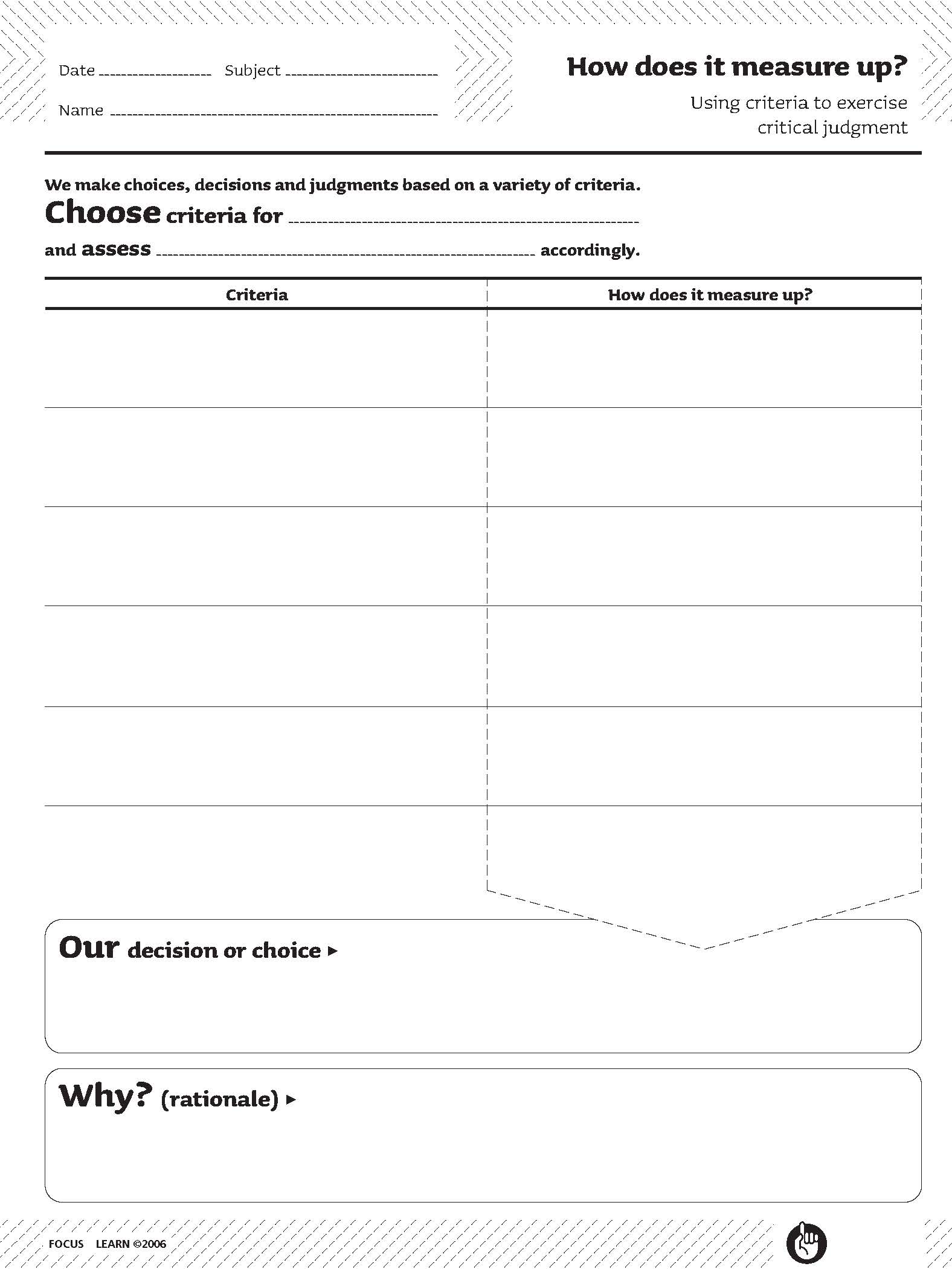 This organizer provides space for students to set up criteria in order to help them make a choice, decision, or judgment. They are asked to provide a rationale for their final decision.
This organizer provides space for students to set up criteria in order to help them make a choice, decision, or judgment. They are asked to provide a rationale for their final decision.
Key features: Forms an opinion, Expresses his/her judgment
CCC 3.5: My Opinion
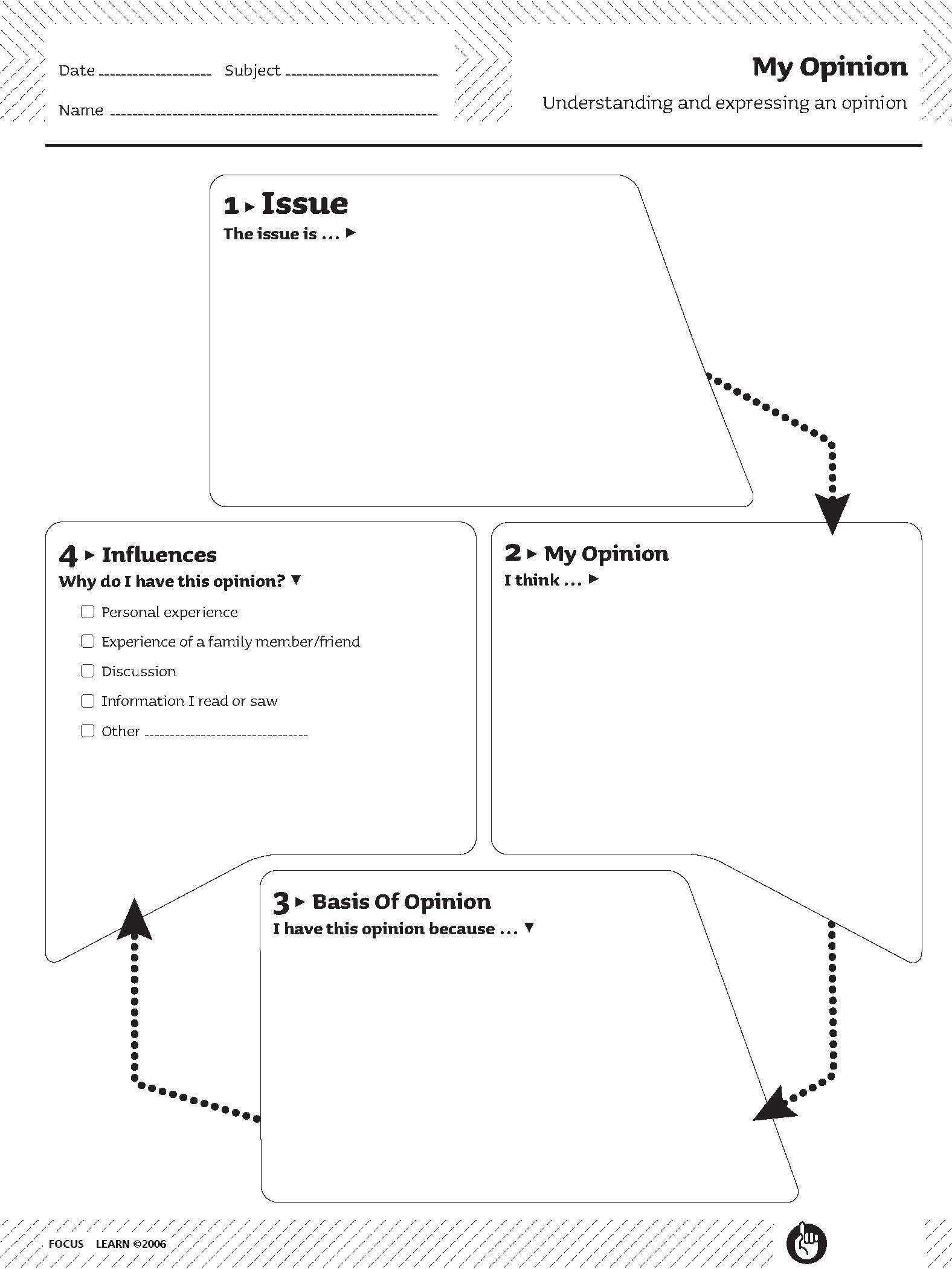 This version of the organizer provides space for students to set up criteria in order to assess two possible options. They are asked to provide a rationale for their final decision.
This version of the organizer provides space for students to set up criteria in order to assess two possible options. They are asked to provide a rationale for their final decision.
Key features: Forms an opinion, Expresses his/her judgment
CCC 3.6: Observation of Cross-Curricular Competency Development
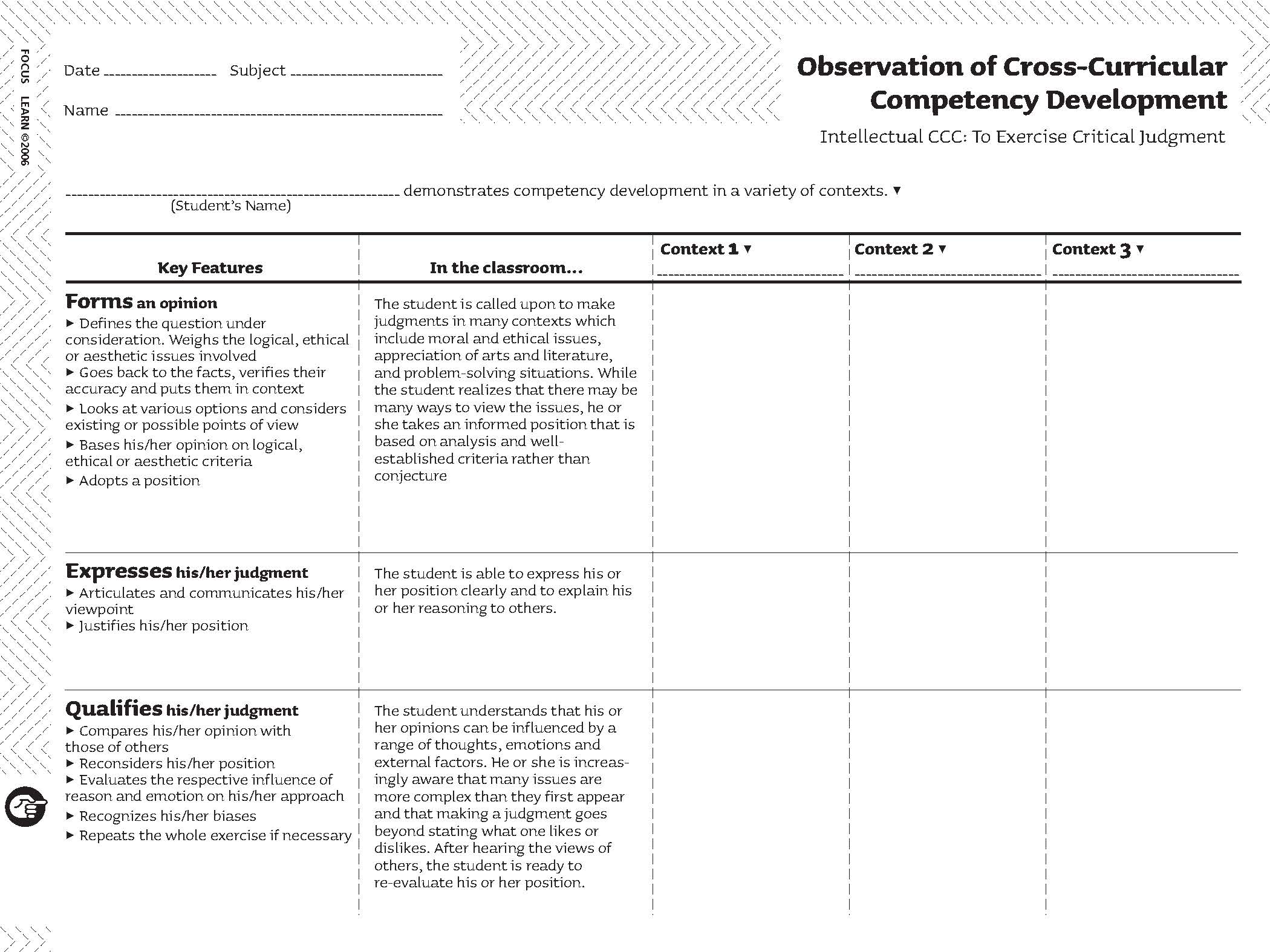 This organizer assists students in forming, articulating, and identifying the source of their opinion or point of view.
This organizer assists students in forming, articulating, and identifying the source of their opinion or point of view.
Key features: Forms an opinion, Express his/her judgment, Qualifies his/her judgment
CCC 3.8: Reflecting on How I Exercised Critical Judgment
This organizer helps students to define and clarify the issue. It asks students to break down the issue into specific questions and to balance his or her viewpoint with someone else's. The student is asked to express his or her opinion based on the information gathered and to think about what influenced him or her.
Key feature: Forms an opinion, Qualifies his/her judgment
CCC4: Uses Creativity
Key Features from the QEP | In the classroom? | Graphic Organizers |
|---|---|---|
| Becomes familiar with all the elements of a situation - Defines the objectives and issues involved | Description: The student can take initiative and visualize possible outcomes when faced with an academic or real-life challenge. Rather than remaining fixed on one idea or right way of accomplishing a task, he or she can envision ways of proceeding. | Creating a Different Plan |
| Idea-Go-Round | ||
| Explores - Accepts risks and unknowns | Description: The student is open to new situations and is willing to take risks. When faced with problems, he or she explores a variety of approaches and is not discouraged by failed attempts. In addition, the student understands the importance of applying strategies and techniques (such as brainstorming) to overcome mental blocks and frustration. He or she is open to suggestions from peers and teachers, while maintaining a sense of individuality. | A World of Possibilities |
| Creating a Different Plan | ||
| Thinking Outside the Box | ||
| What Inspires Me? | ||
| Adopts a flexible mode of operation - Tries out new approaches | Description: Always in search of new ways of thinking and doing, the student finds innovative ways to use existing resources and to express his or her ideas. | A World of Possibilities |
| Exploring Different Modes | ||
| Thinking Outside the Box | ||
| What Inspires Me? |
CCC 4.1: A World of Possibilities
 This organizer allows students to explore different procedures and encourages them to use new ideas and accept risks and unknowns.
This organizer allows students to explore different procedures and encourages them to use new ideas and accept risks and unknowns.
Key features: Explores, Adopts a flexible mode of operation
CCC 4.3: Creating a Different Plan
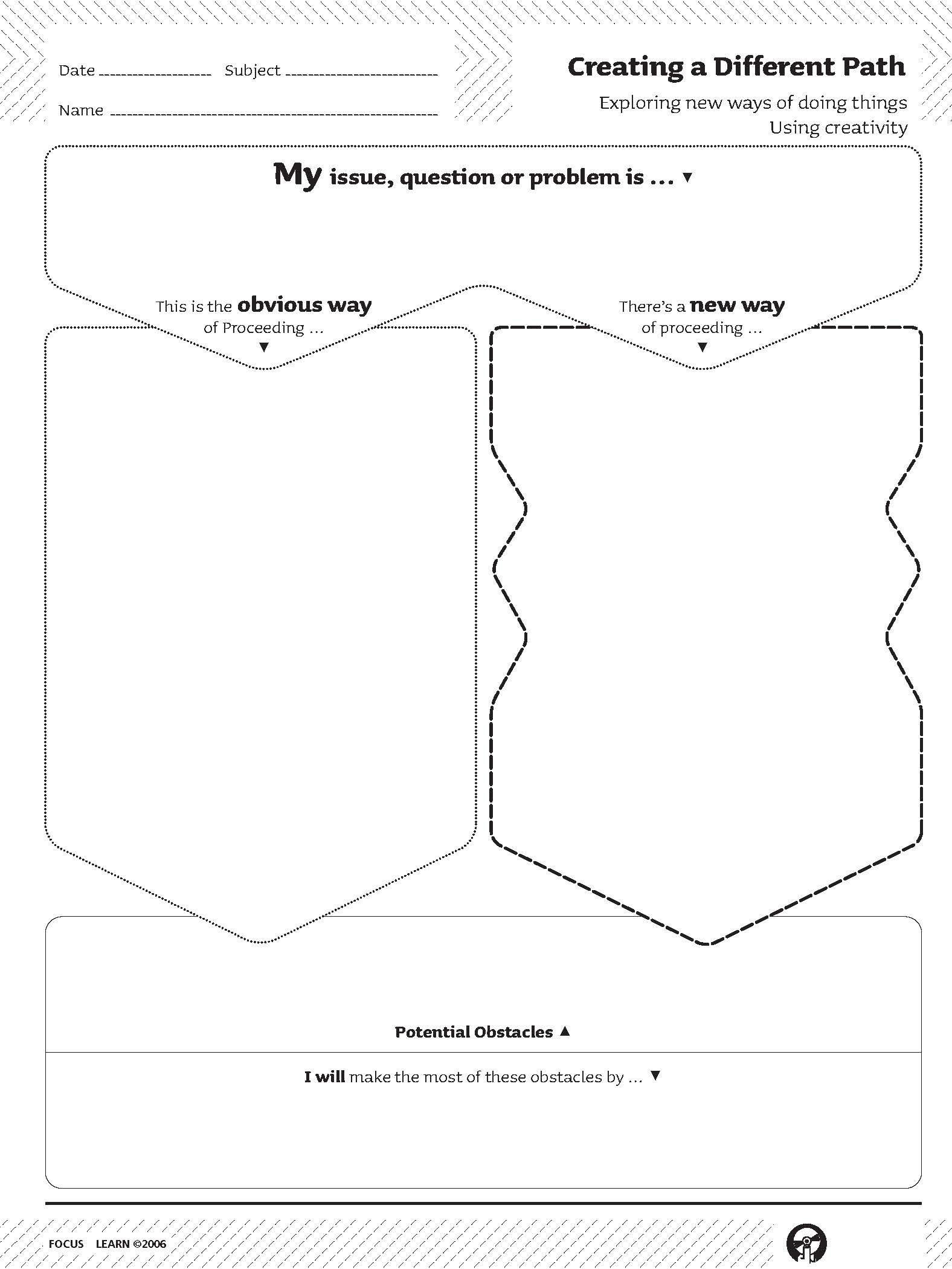 This organizer helps students envisage different ways of proceeding and asks them to identify how to turn obstacles into resources.
This organizer helps students envisage different ways of proceeding and asks them to identify how to turn obstacles into resources.
Key features: Becomes familiar with all the elements of a situation, Explores
CCC 4.4: Exploring Different Modes
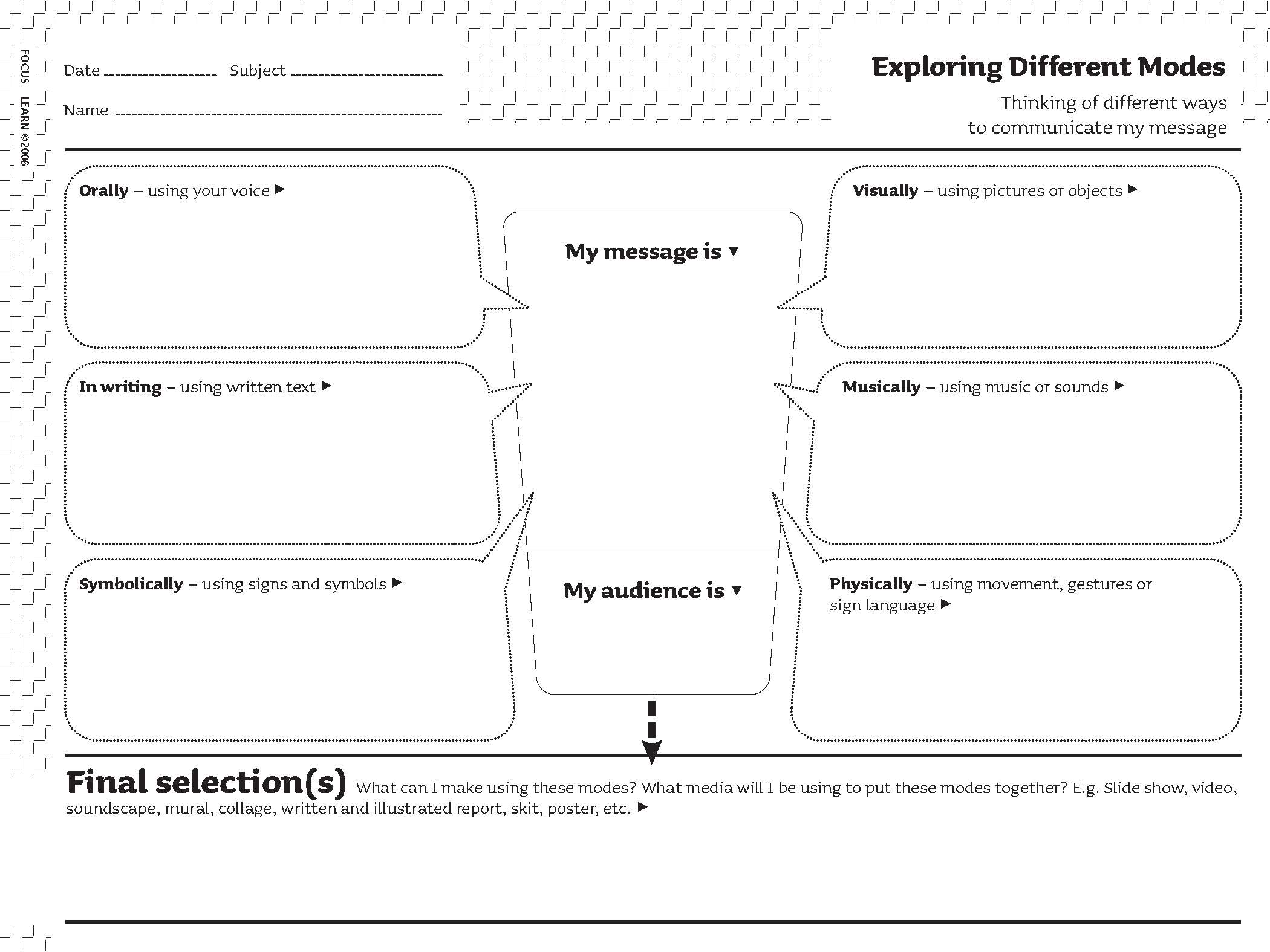 This organizer helps students choose the mode they will use to deliver their message by reflecting on the message, its different aspects and the audience.
This organizer helps students choose the mode they will use to deliver their message by reflecting on the message, its different aspects and the audience.
Key feature: Adopts a flexible mode of operation
CCC 4.5: Idea-Go-Round
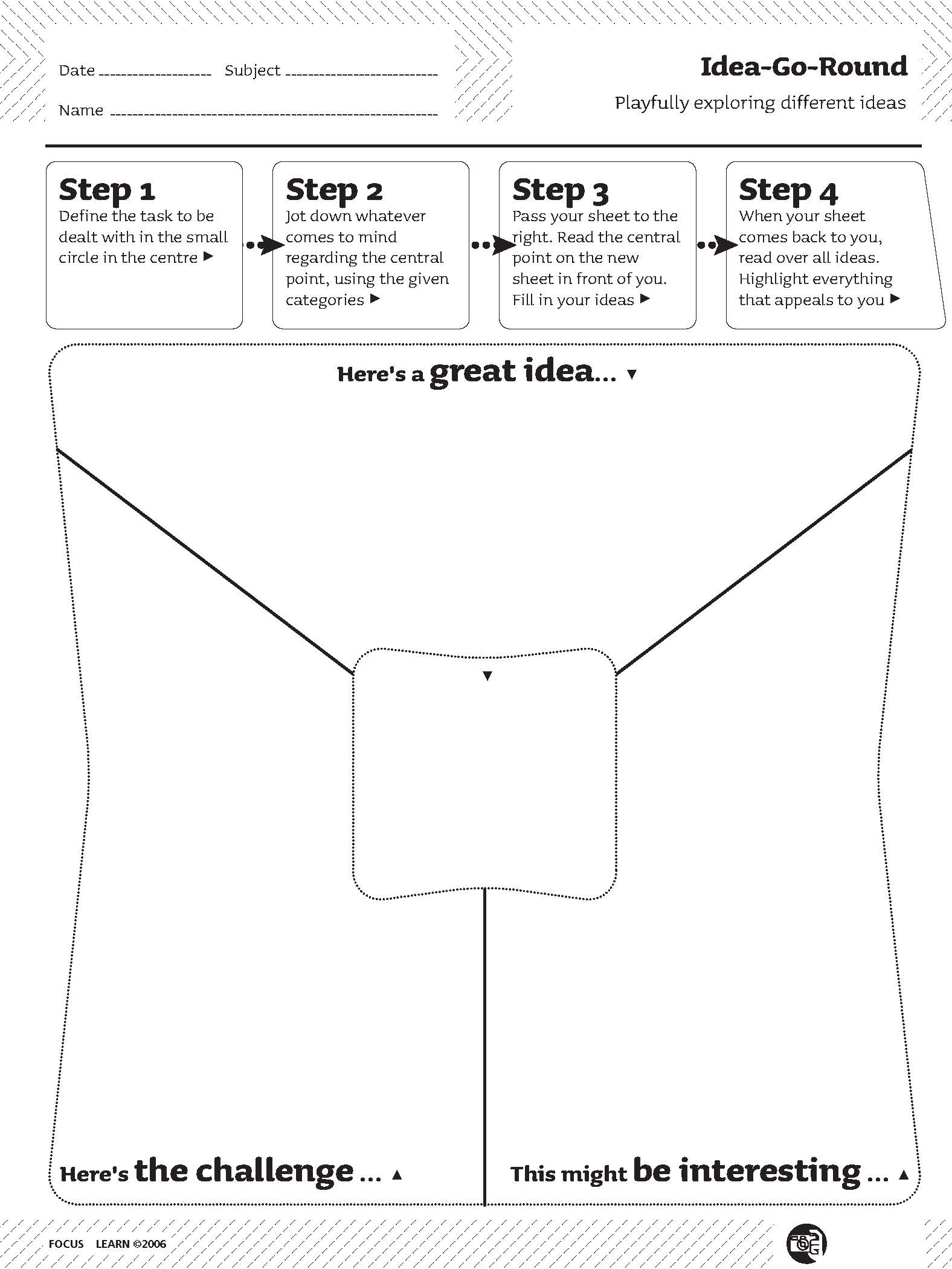 This organizer allows students to brainstorm and share different issues involved in a situation. It promotes looking at a situation in different ways.
This organizer allows students to brainstorm and share different issues involved in a situation. It promotes looking at a situation in different ways.
Key feature: Becomes familiar with all the elements of a situation
CCC 4.9: Thinking Outside the Box
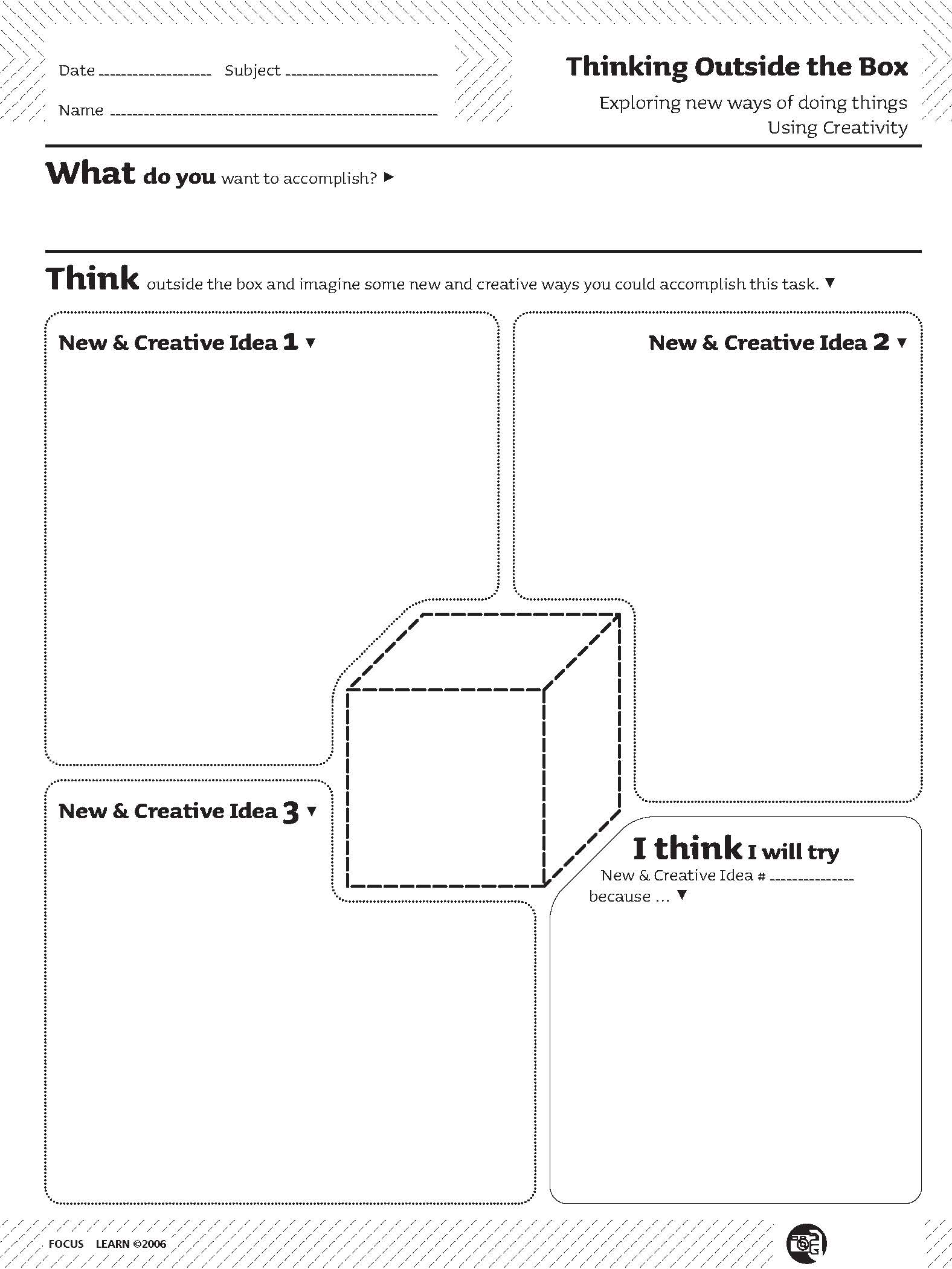 This organizer asks students to think outside the box by imagining new and creative ways of proceeding.
This organizer asks students to think outside the box by imagining new and creative ways of proceeding.
Key features: Explores, Adopts a flexible mode of operation
CCC8: Cooperates With Others
Key Features from the QEP | In the classroom? | Graphic Organizers |
|---|---|---|
| Contributes to team efforts - Assesses what sort of collaboration or cooperation a task lends itself to | Description: The student recognizes when and how it is best to work with others to accomplish a task. He or she participates actively in pairs, small groups, or larger teams. The student is aware of his or her own strengths and shares them with his or her teammates for the benefit of the group. He or she is able to accomplish tasks individually and with others, according to the plan set out by the team. When a conflict occurs, the student can negotiate to find a compromise that will be accepted and implemented by team members. | Our Team Agrees On... |
| Our Responsibilities | ||
| Our Strengths | ||
| We Disagree...Now What? (3- & 4-person group) | ||
| Uses teamwork effectively - Recognizes which tasks can be done more effectively by means of teamwork | Description: The student is able to determine which tasks to take on as a whole team and when to split the workload amongst teammates. The student realizes how he or she contributes to the group's efforts and how others' contributions have facilitated his or her learning. Throughout the task, the student reflects on his or her own participation and that of other team members and suggests changes to improve the team's process. | Coooperative Learning Peer Evaluation |
| Our Responsibilities | ||
| Taking Stock | ||
| To Do List | ||
| We Disagree...Now What? (3- & 4-person group) | ||
| Interacts with an open mind in various contexts - Accepts others as they are and recognizes their interests and needs | Description: The student works on accepting and respecting others in the team, recognizing that all points of view should be heard. He or she adapts his or her behaviour in order to create a positive and productive work environment and to meet teammates' needs. | Cooperative Learning Peer Evaluation |
| Our Team Agrees On | ||
| Taking Stock | ||
| We Disagree...Now What? (3- & 4-person group) |
CCC 8.2: Cooperative Learning Peer Evaluation
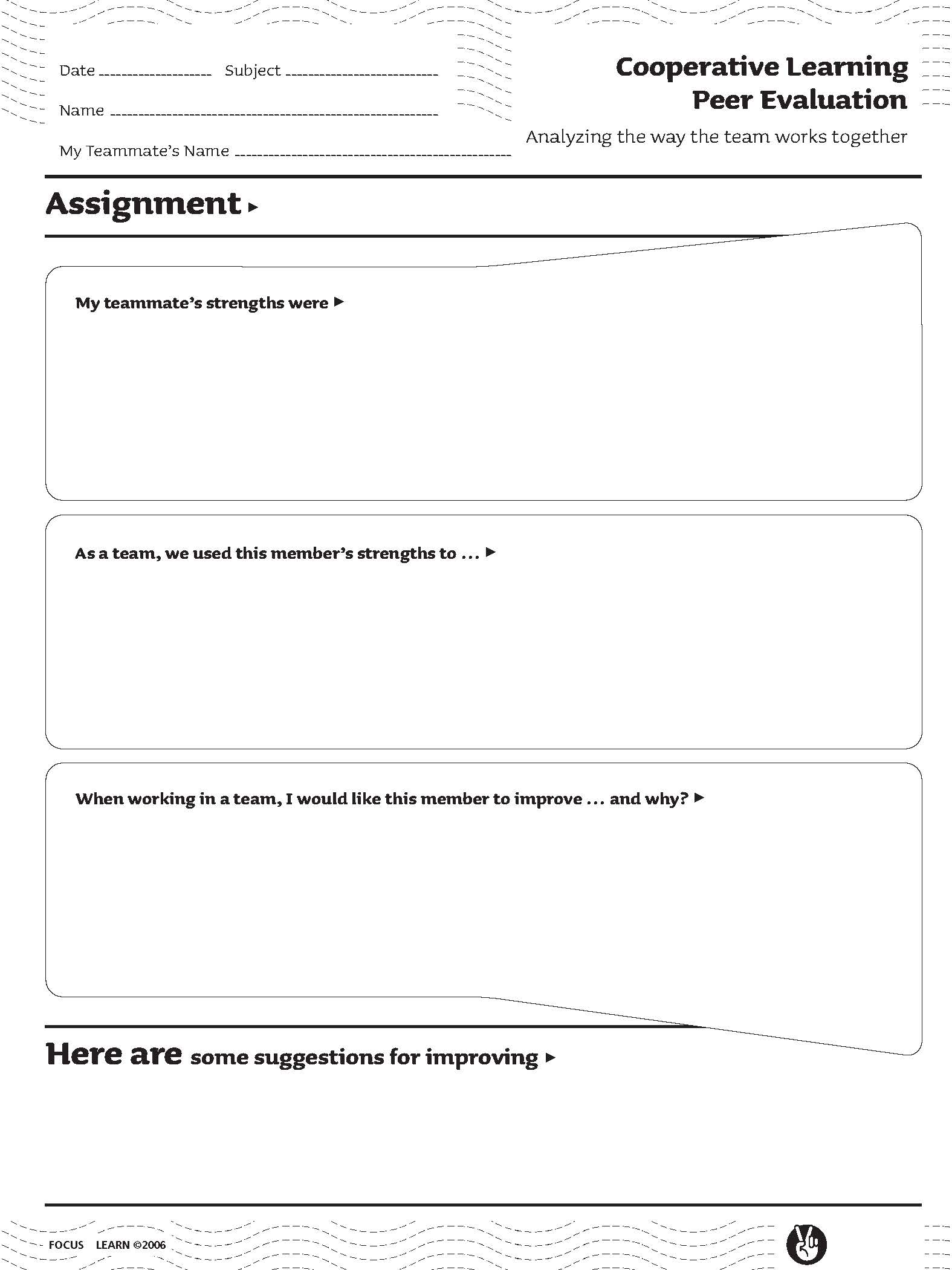 This organizer will ask the student to evaluate the contribution of his or her teammates to the group's efforts and to make suggestions for improvement.
This organizer will ask the student to evaluate the contribution of his or her teammates to the group's efforts and to make suggestions for improvement.
Key features: Uses teamwork effectively, Interacts with an open mind in various contexts
CCC 8.4: Our Responsibilities
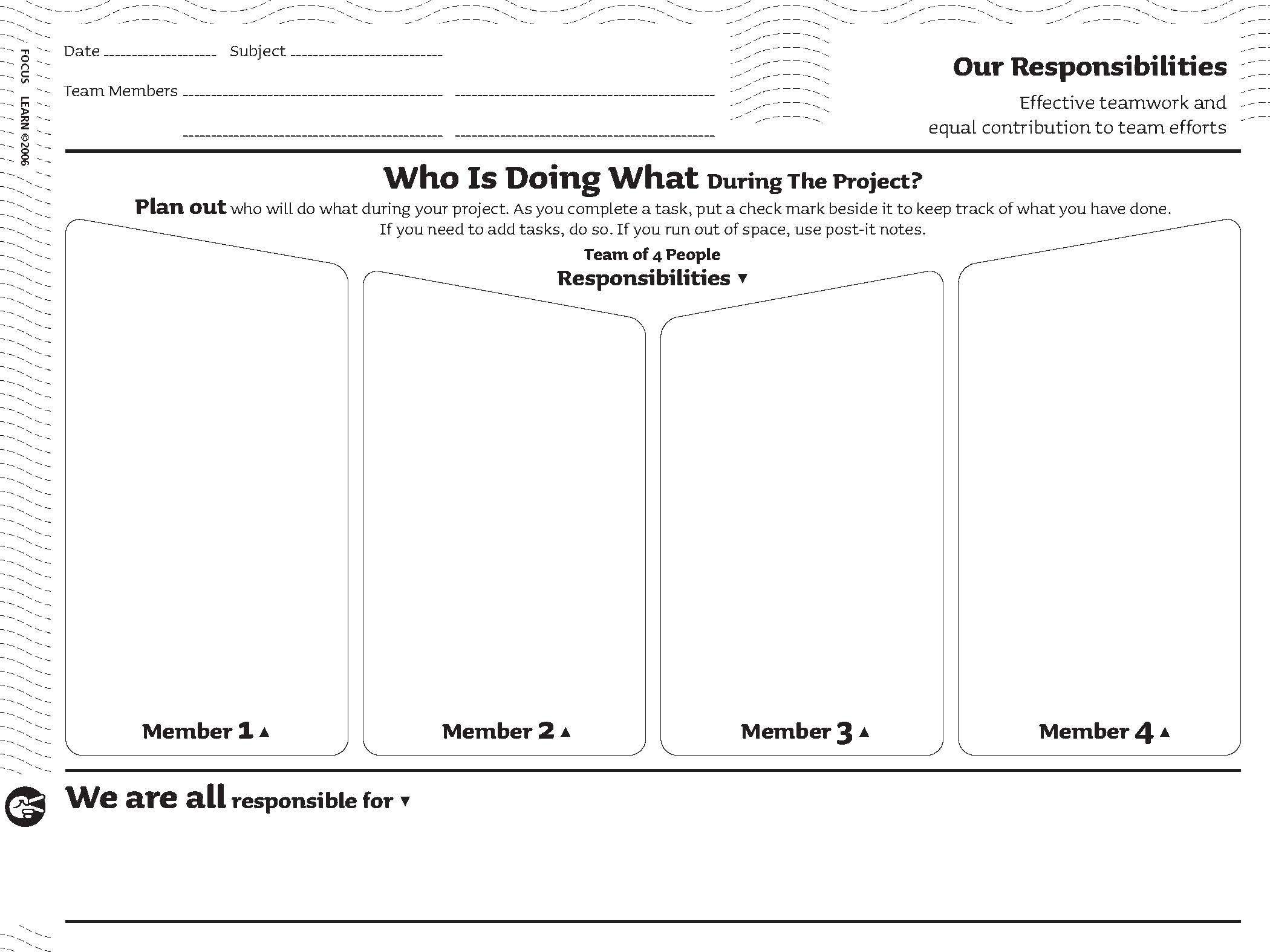 This organizer helps students to identify which tasks to take on as a team and which to divide amongst members. It asks students to assign specific tasks to each team member and encourages them to keep track of their progress.
This organizer helps students to identify which tasks to take on as a team and which to divide amongst members. It asks students to assign specific tasks to each team member and encourages them to keep track of their progress.
Key features: Contributes to team efforts, Uses teamwork effectively
CCC 8.5: Our Strengths
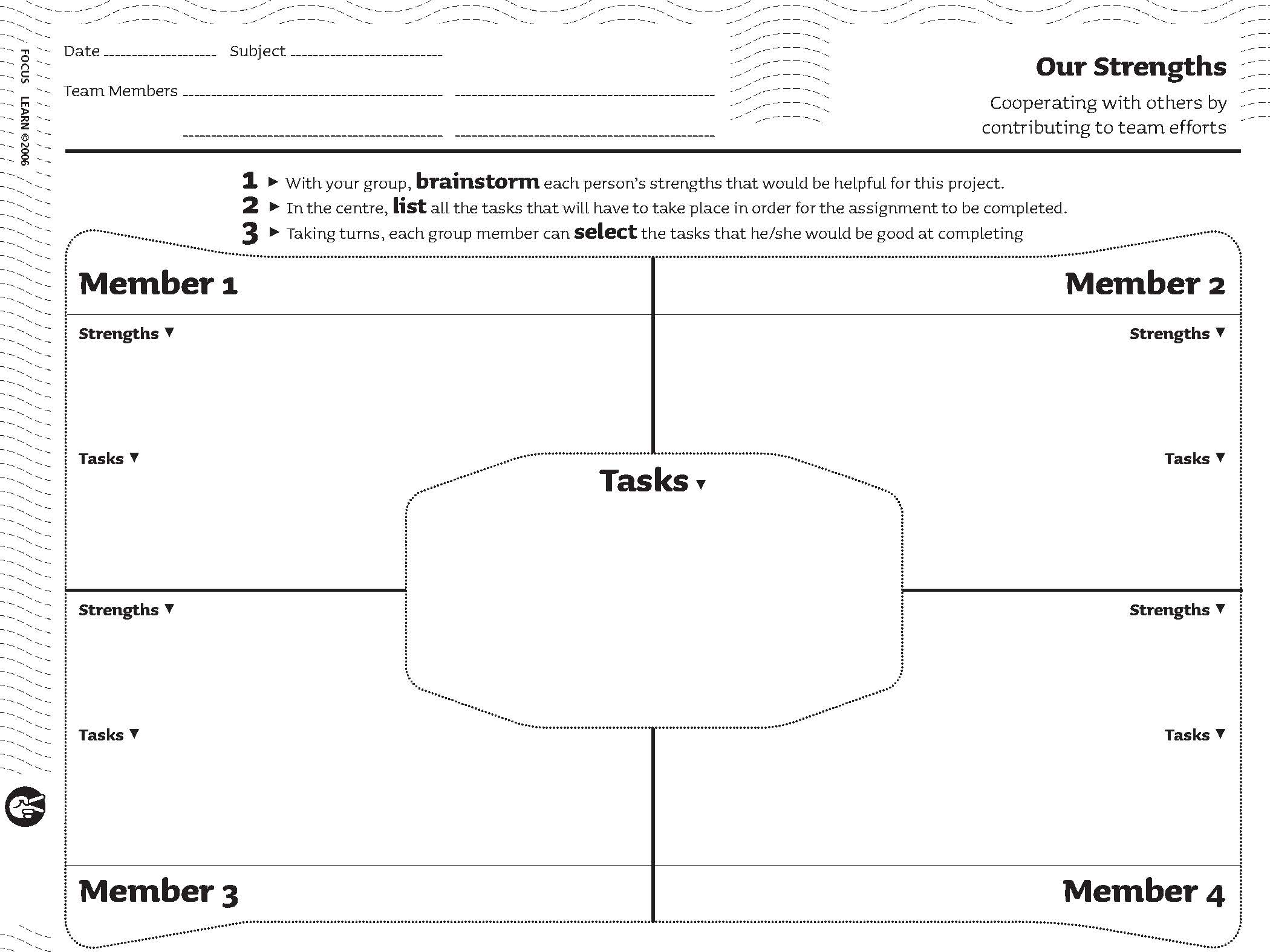 This organizer asks students to identify the strengths of each team member then selects tasks based on their aptitudes.
This organizer asks students to identify the strengths of each team member then selects tasks based on their aptitudes.
Key feature: Contributes to team efforts
CCC 8.6: Our Team Agrees On ...
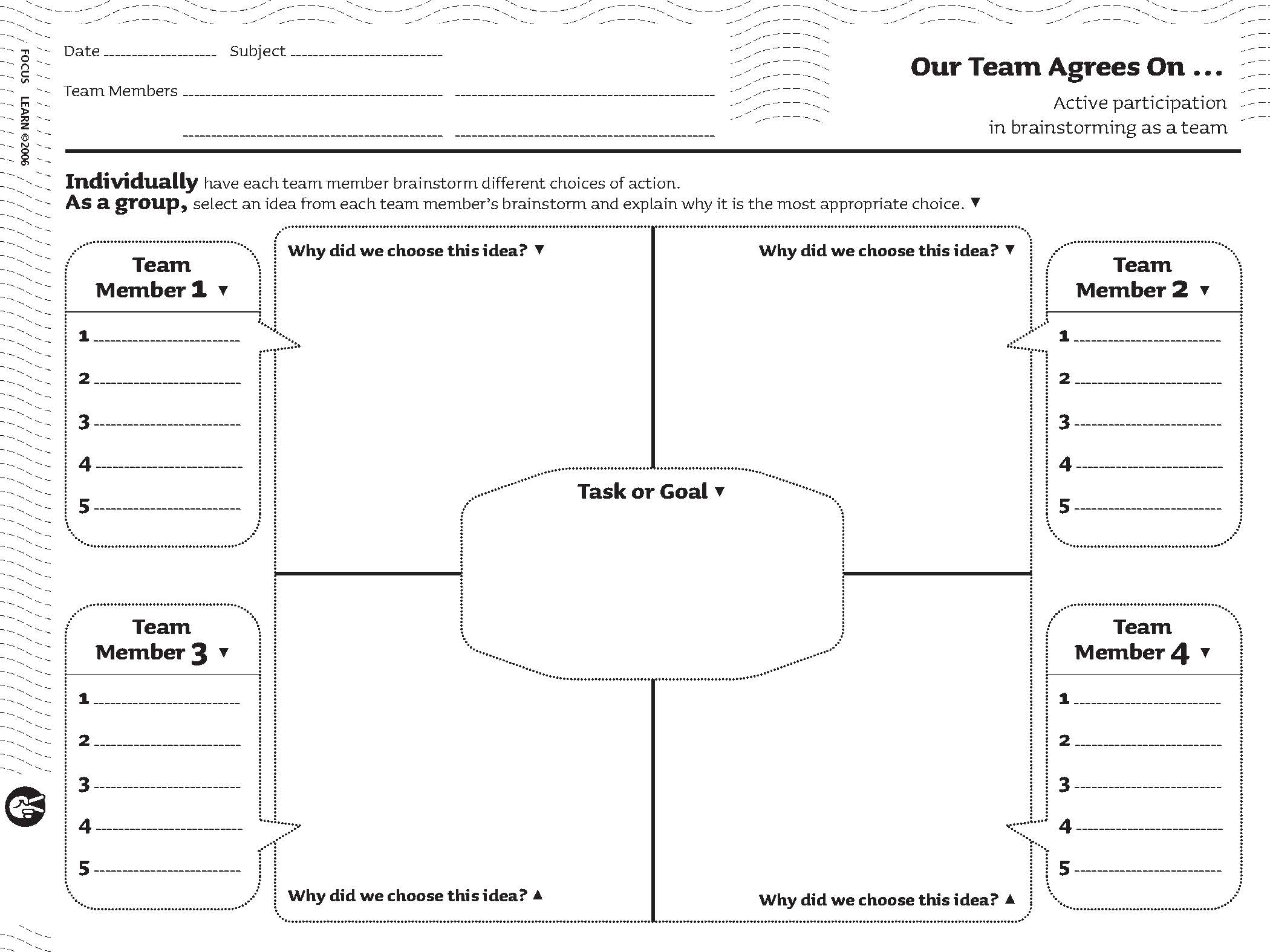 This organizer allows all team members to participate in establishing a procedure and carrying out the task.
This organizer allows all team members to participate in establishing a procedure and carrying out the task.
Key features: Contributes to team efforts, Interacts with an open mind in various contexts
CCC 8.8: Taking Stock
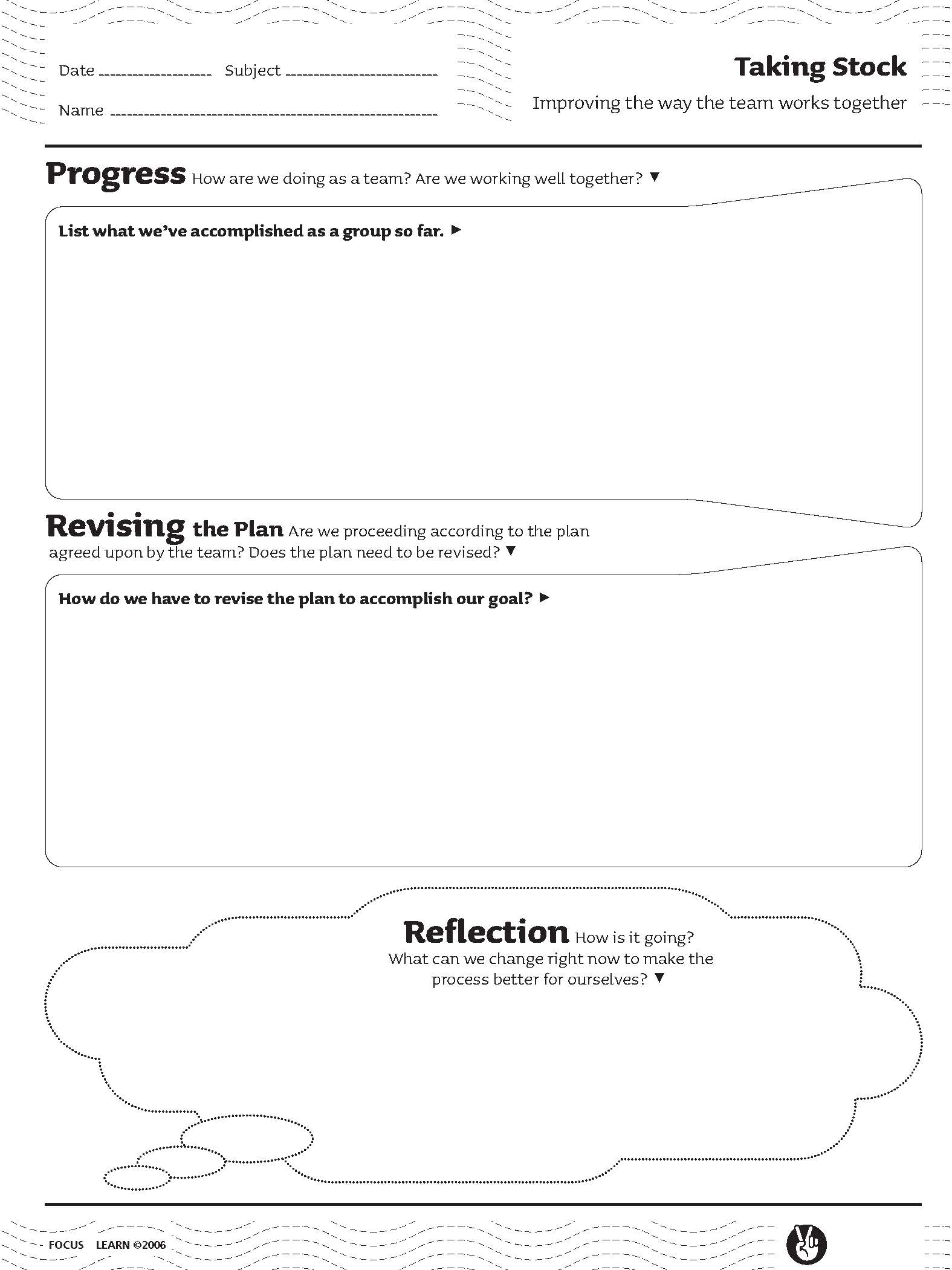 This organizer is designed to help students evaluate their progress and adjust their strategies as required throughout the collaborative process.
This organizer is designed to help students evaluate their progress and adjust their strategies as required throughout the collaborative process.
Key features: Uses teamwork effectively, Interacts with an open mind in various contexts
CCC 8.10: To Do List
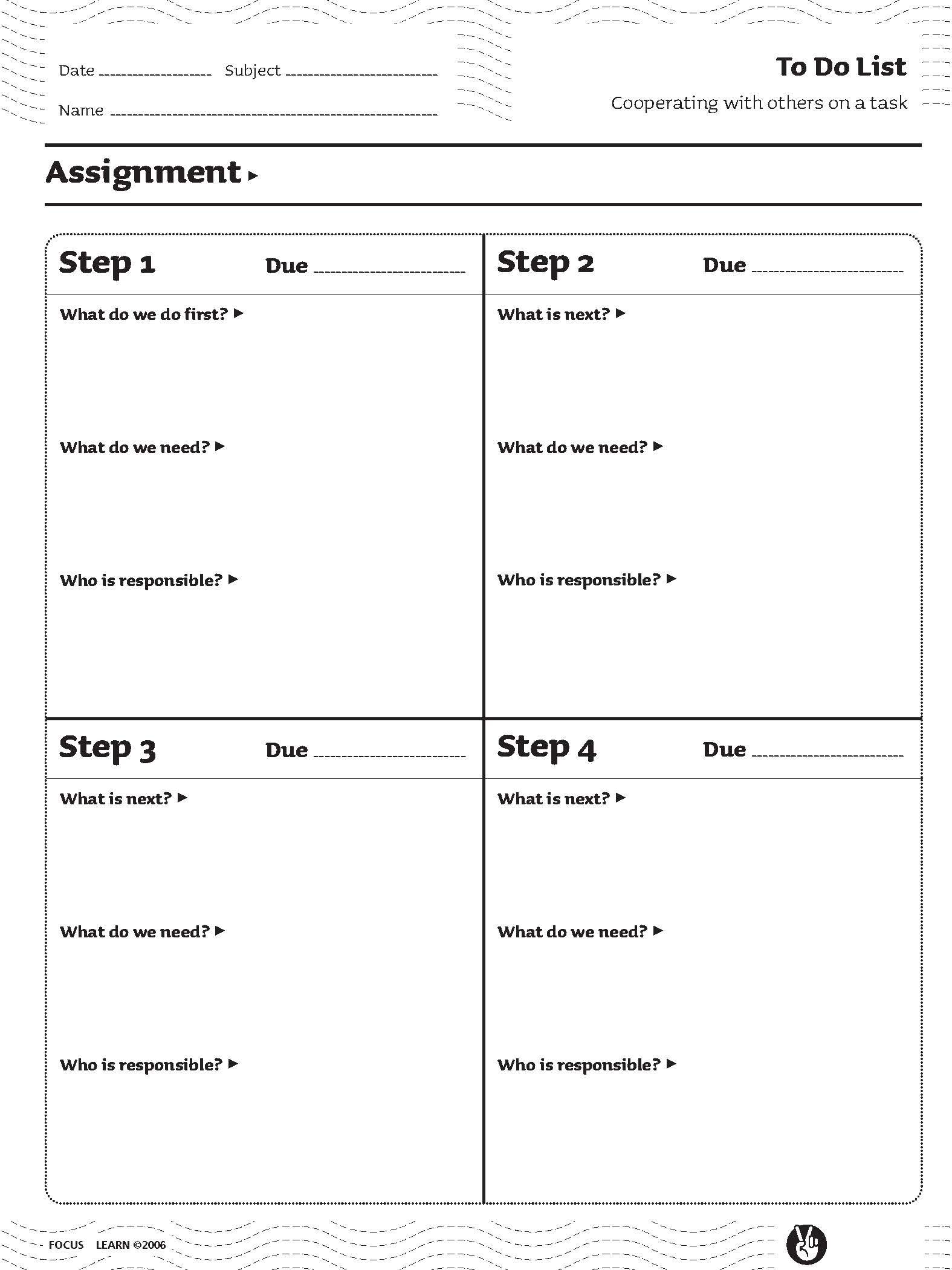 This organizer helps teams plan different tasks by identifying the required resources and which member will be responsible for which task.
This organizer helps teams plan different tasks by identifying the required resources and which member will be responsible for which task.
Key feature: Uses teamwork effectively
CCC 8.11: We Disagree...Now What? (Resolving conflict in a 3-person group)
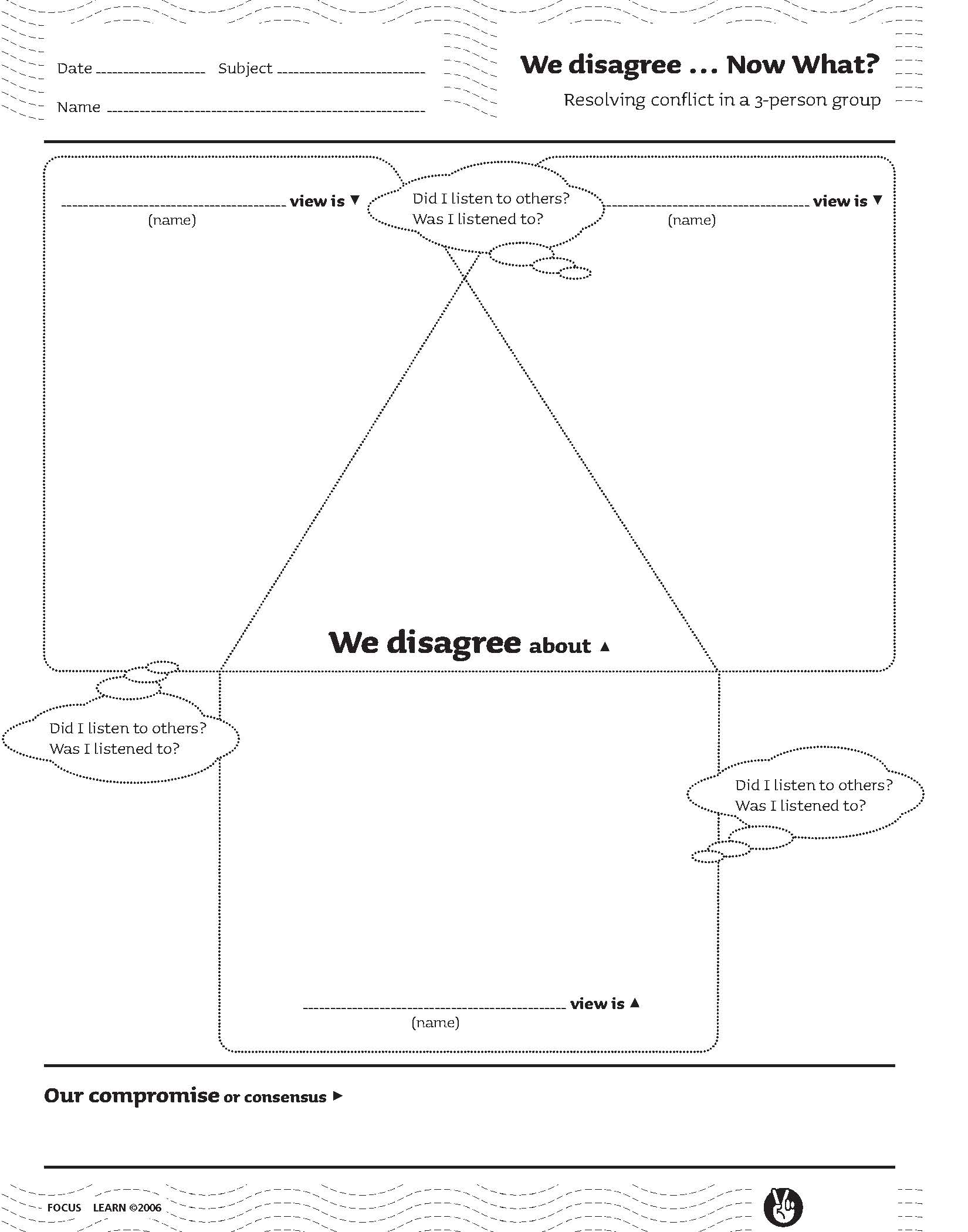 This organizer helps students resolve a conflict in a three-person group. Each student has the opportunity to express, in writing, what they disagree about and the group must come to a compromise and consensus.
This organizer helps students resolve a conflict in a three-person group. Each student has the opportunity to express, in writing, what they disagree about and the group must come to a compromise and consensus.
Key features: Contributes to team efforts, Uses teamwork effectively, Interacts with an open mind in various contexts
CCC 8.12: We Disagree...Now What? (Resolving conflict in a 4-person group)
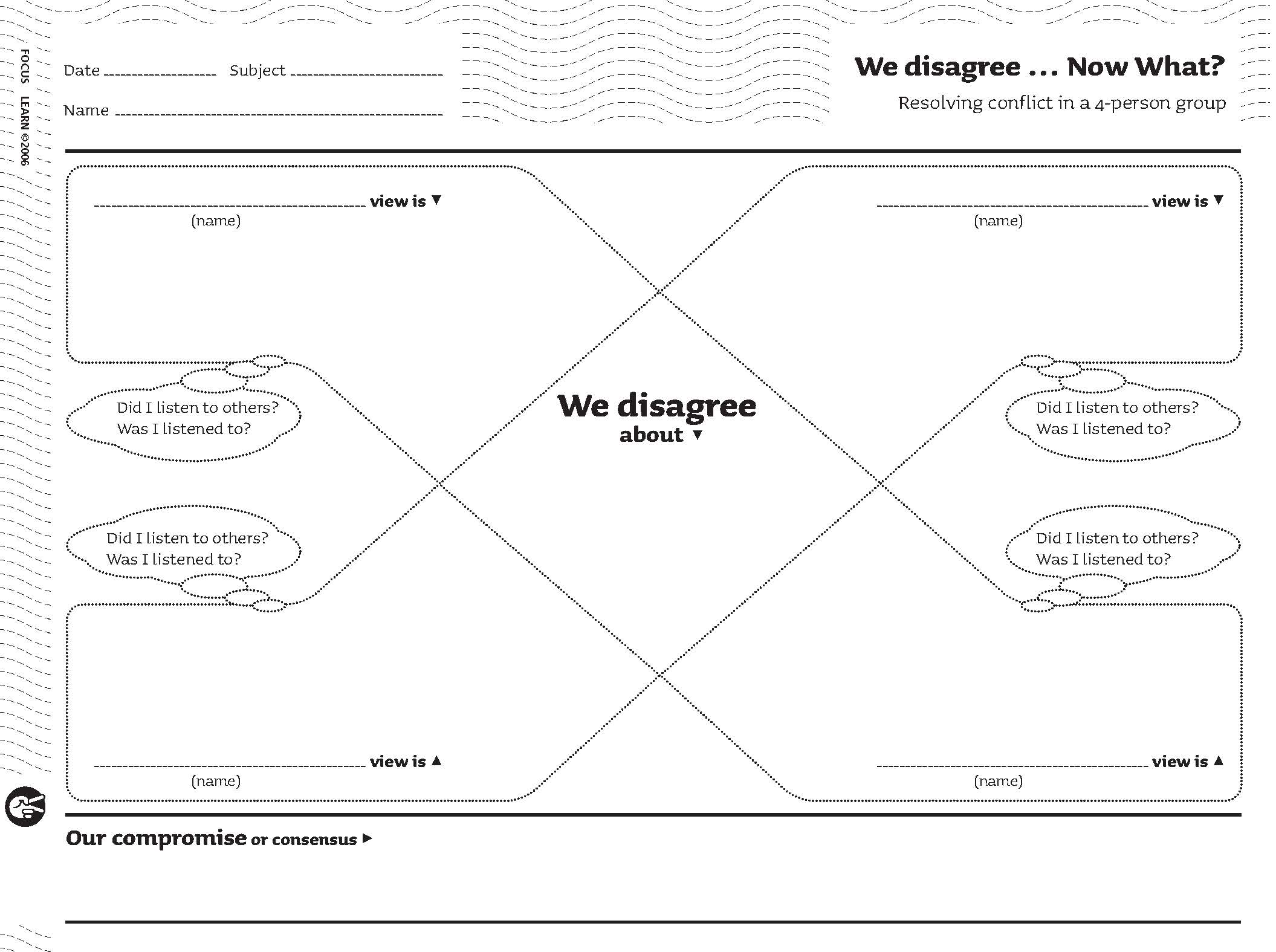 This organizer helps students resolve a conflict in a four-person group. Each student has the opportunity to express, in writing, what they disagree about, and the croup must come to a compromise or consensus.
This organizer helps students resolve a conflict in a four-person group. Each student has the opportunity to express, in writing, what they disagree about, and the croup must come to a compromise or consensus.
Key features: Contributes to team efforts, Uses teamwork effectively, Interacts with an open mind in various contexts
CCC5: Adopts Effective Work Methods
Key Features from the QEP | In the classroom? | Graphic Organizers |
|---|---|---|
| Considers all aspects of a task - Adopts the objective and evaluates its complexity | Description: The students understands the task and the requirements of carrying it out effectively. He or she can list the resources that can be drawn upon to complete the task. After considering different approaches, the student decides jon the most appropriate means to reach his or her goal. Finally, the student is able to develop a plan that will help him or her to manage the process. | Breaking It Down |
| Detailed Timeline | ||
| Information Resouces List | ||
| Project Planner | ||
| Project Timeline | ||
| Adjusts his/her approach - Employs the necessary resources: people, materials, time, etc. | Description: During the course of his or her work, the student demonstrates the ability to assess his or her progress and make the necessary adjustments. | Information Resources List |
| Project Timeline | ||
| Taking Stock | ||
| Analyzes his/her procedure - Examines the procedure used | Description: The student reflects on his/her process and determines what worked, what did not, and what could be improved in future tasks. | Plus, Minus, Interesting |
| Reflecting on my Work Methods | ||
| Taking Stock |
CCC 5.1: A Detailed Timeline
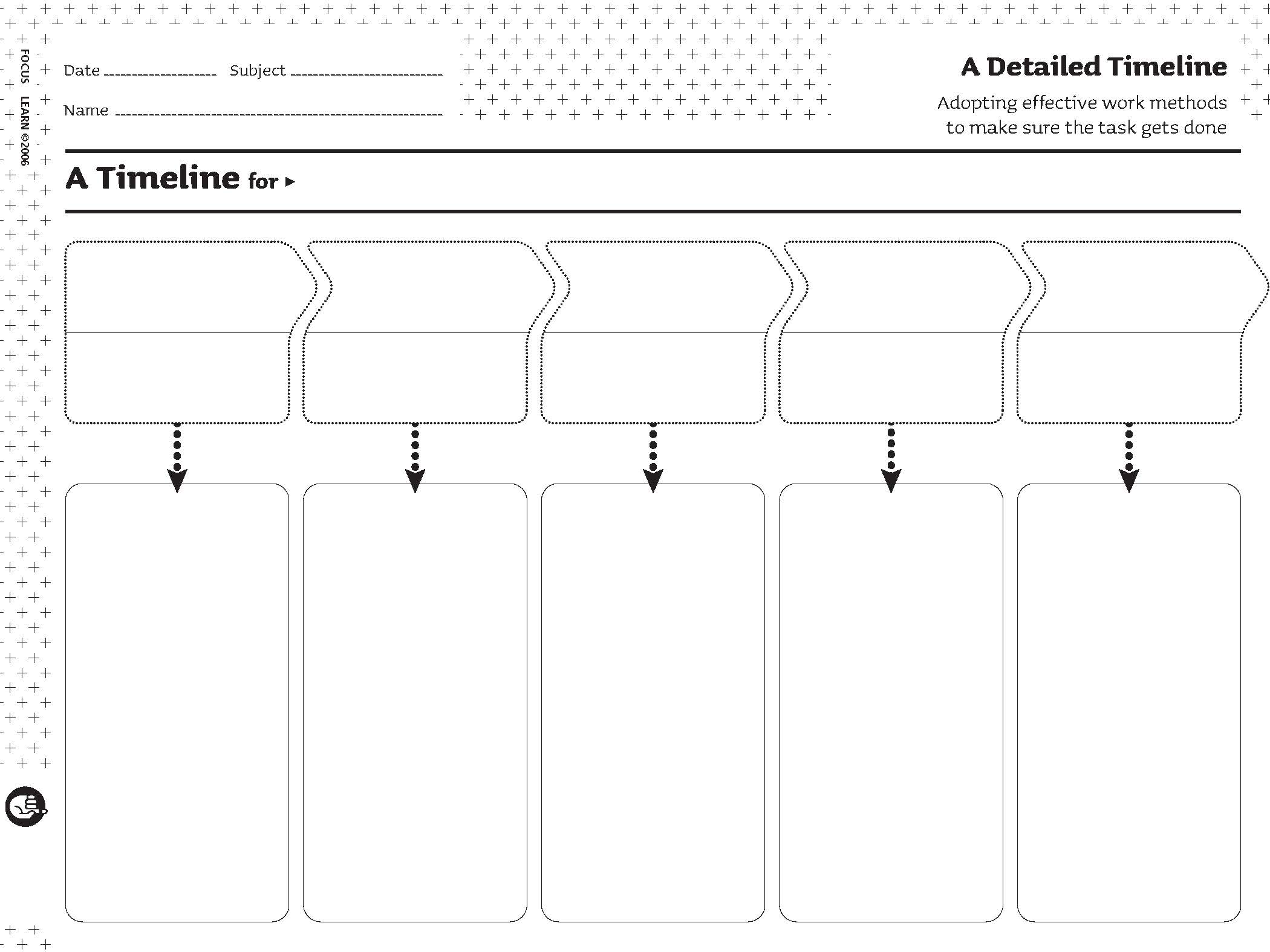 This organizer is designed to help students plan how to carry out an assignment by charting different tasks on a timeline.
This organizer is designed to help students plan how to carry out an assignment by charting different tasks on a timeline.
Key feature: Consider all aspects of a task
CCC 5.2: Breaking It Down
 This organizer helps students plan, set deadlines, detail the components of their assignment, and keep track of their work.
This organizer helps students plan, set deadlines, detail the components of their assignment, and keep track of their work.
Key feature: Consider all aspects of a task
CCC 5.5: Information Resources List
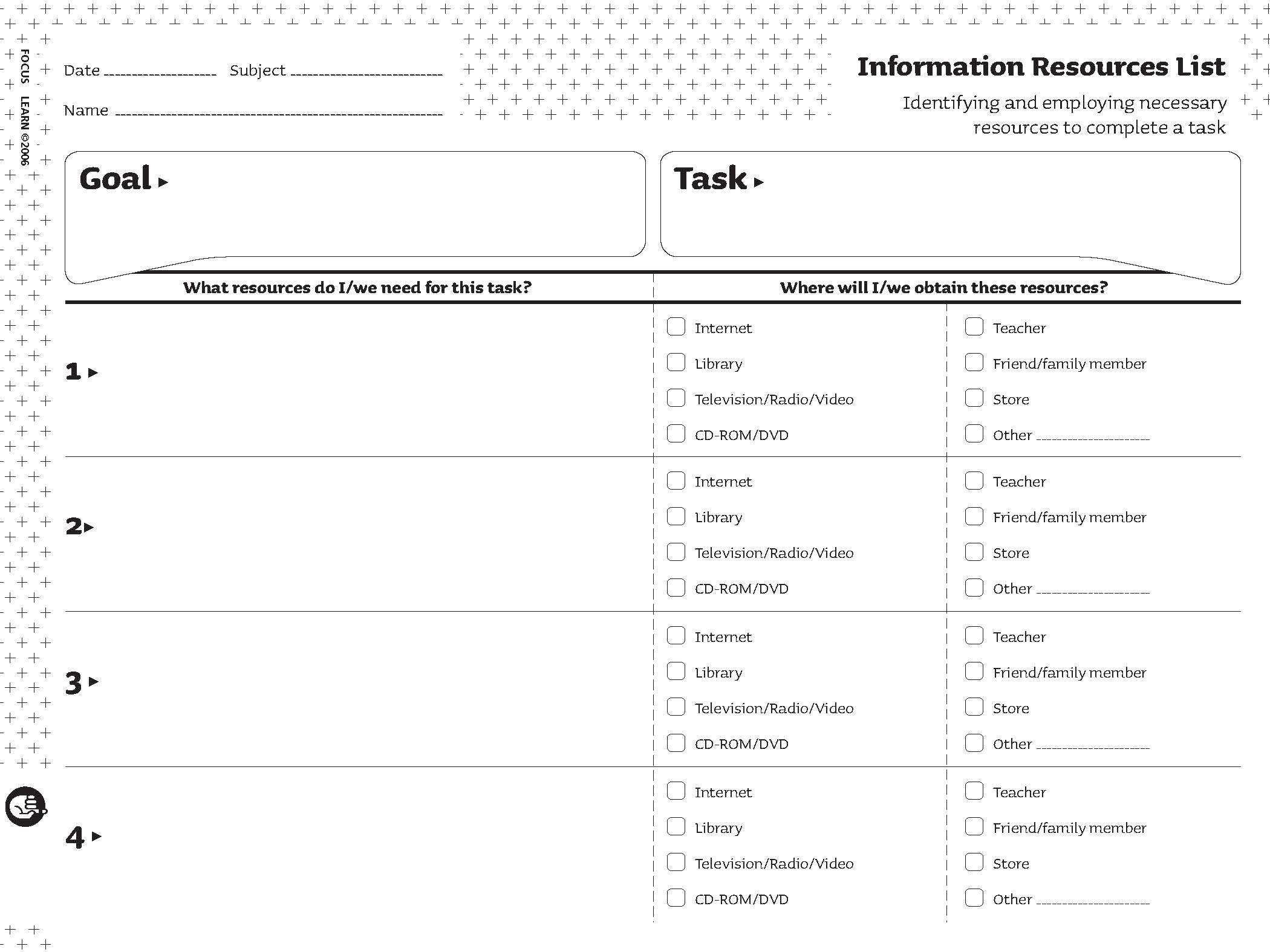 This organizer is designed to help students identify the resources that they will need for a certain task.
This organizer is designed to help students identify the resources that they will need for a certain task.
Key features: Consider all aspects of a task, Adjusts his/her approach
CCC 5.7: Plus, Minus, Interesting
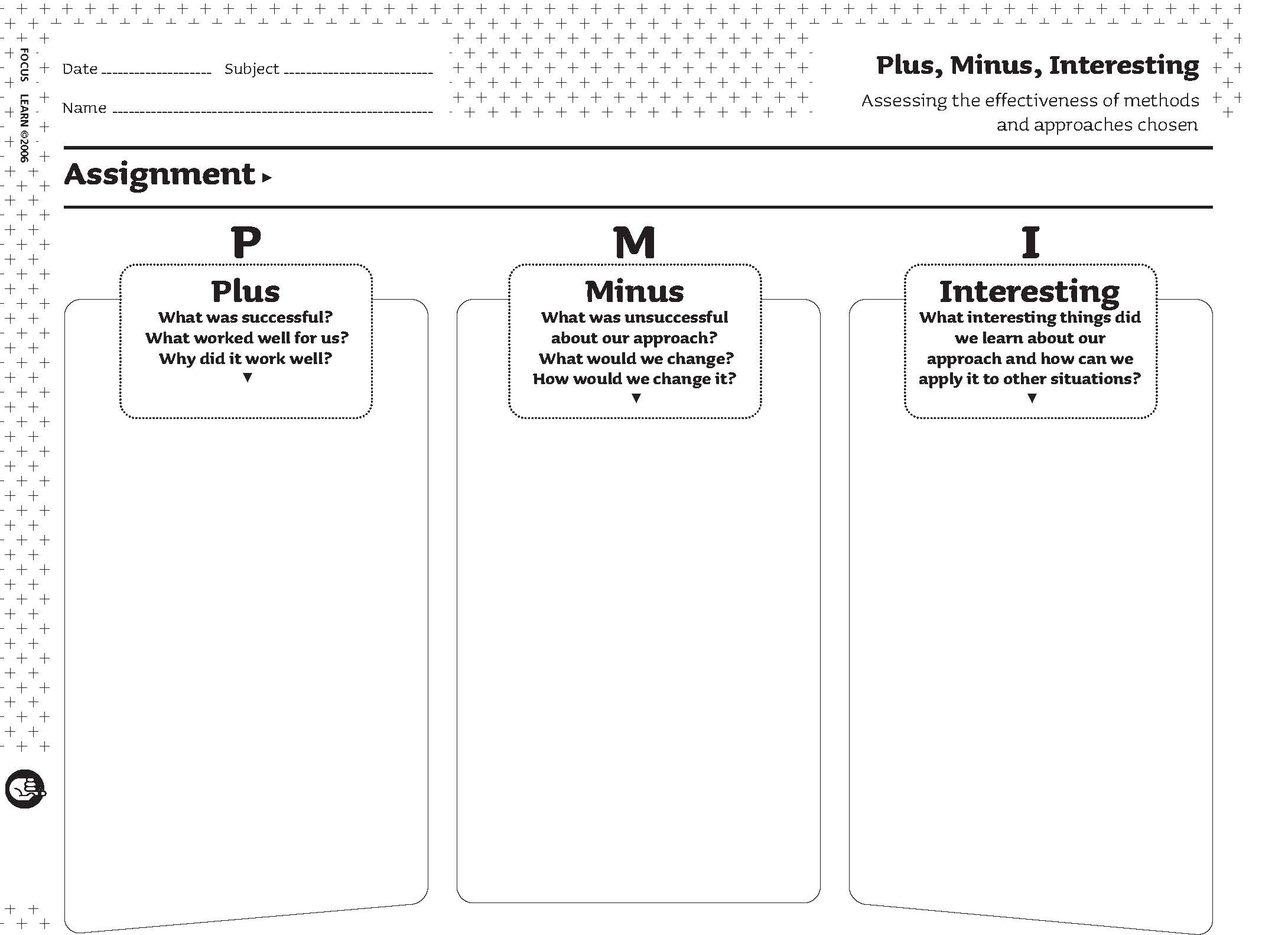 This organizer allows students to reflect on their approach by examining their successes and difficulties. Students are also asked to reflect on what they learned from their approach and to imagine contexts where the approach could be reapplied.
This organizer allows students to reflect on their approach by examining their successes and difficulties. Students are also asked to reflect on what they learned from their approach and to imagine contexts where the approach could be reapplied.
Key feature: Analyzes his/her procedure
CCC 5.8: Project Planner
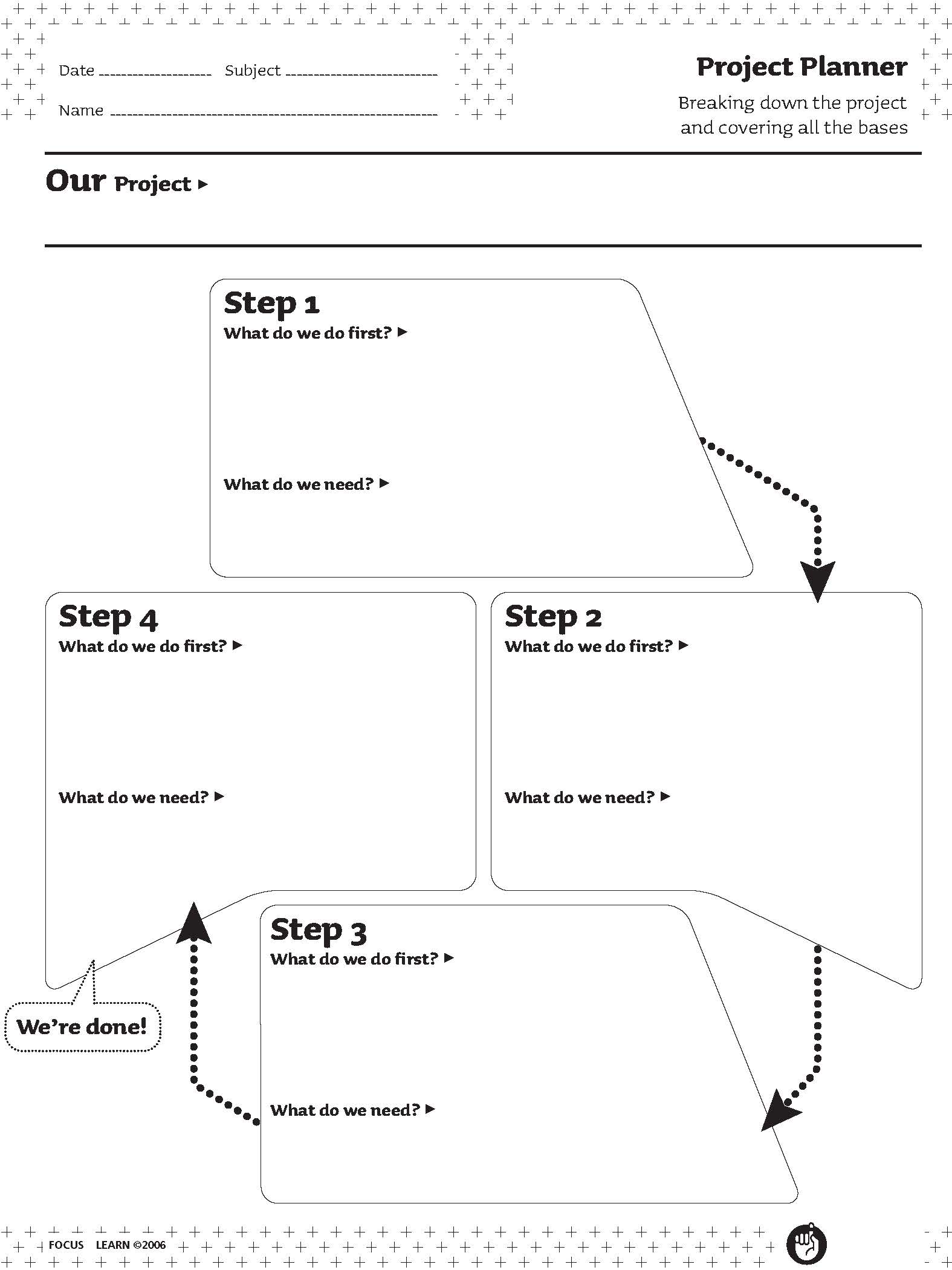 This organizer helps students to break down and identify the steps of a proposed project and to reflect on subsequent steps. The steps/phases are recursive to allow students to make necessary changes.
This organizer helps students to break down and identify the steps of a proposed project and to reflect on subsequent steps. The steps/phases are recursive to allow students to make necessary changes.
Key feature: Consider all aspects of a task
CCC 5.9: Project Timeline
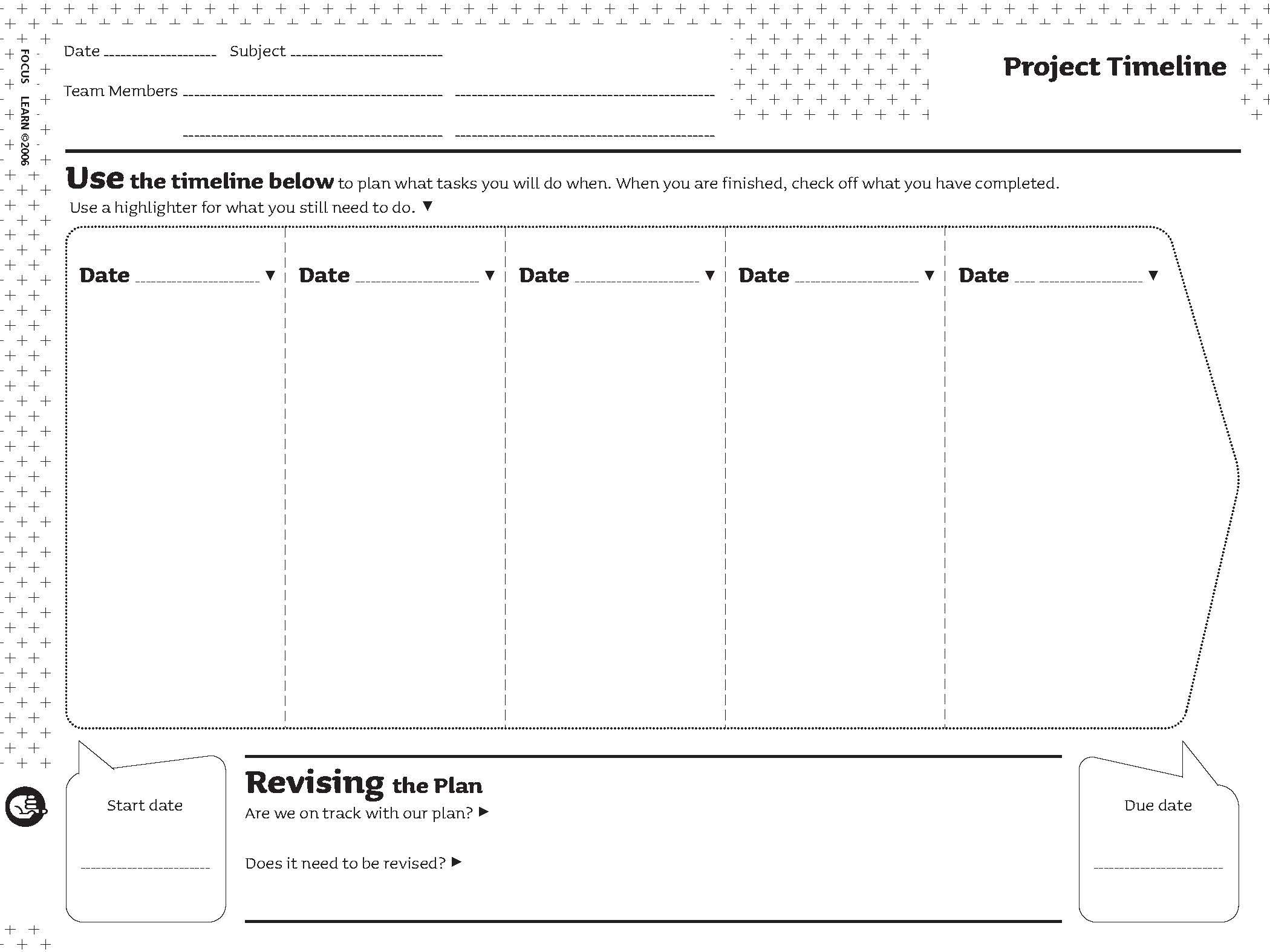 This organizer guides a team's project with a visual plan of what is to be completed and when. Students reflect on whether or not they are on track.
This organizer guides a team's project with a visual plan of what is to be completed and when. Students reflect on whether or not they are on track.
Key features: Consider all aspects of a task, Adjusts his/her approach
CCC 5.10: Reflecting on My Work Methods
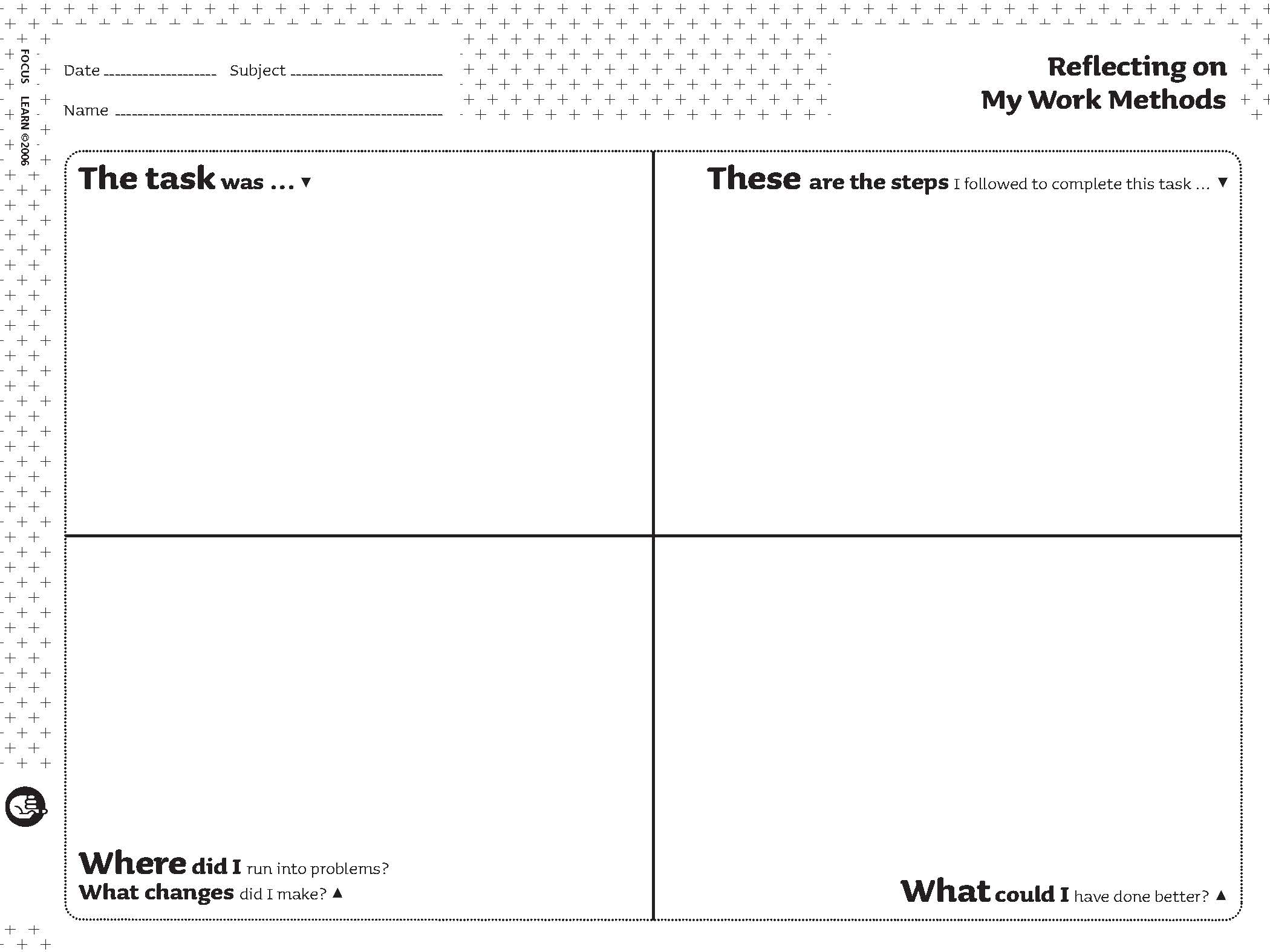 This organizer allows students to reflect on their work methods and evaluate what worked well and what they would do differently.
This organizer allows students to reflect on their work methods and evaluate what worked well and what they would do differently.
Key feature: Analyzes his/her procedure
CCC 5.11: Reflecting on My Work Methods
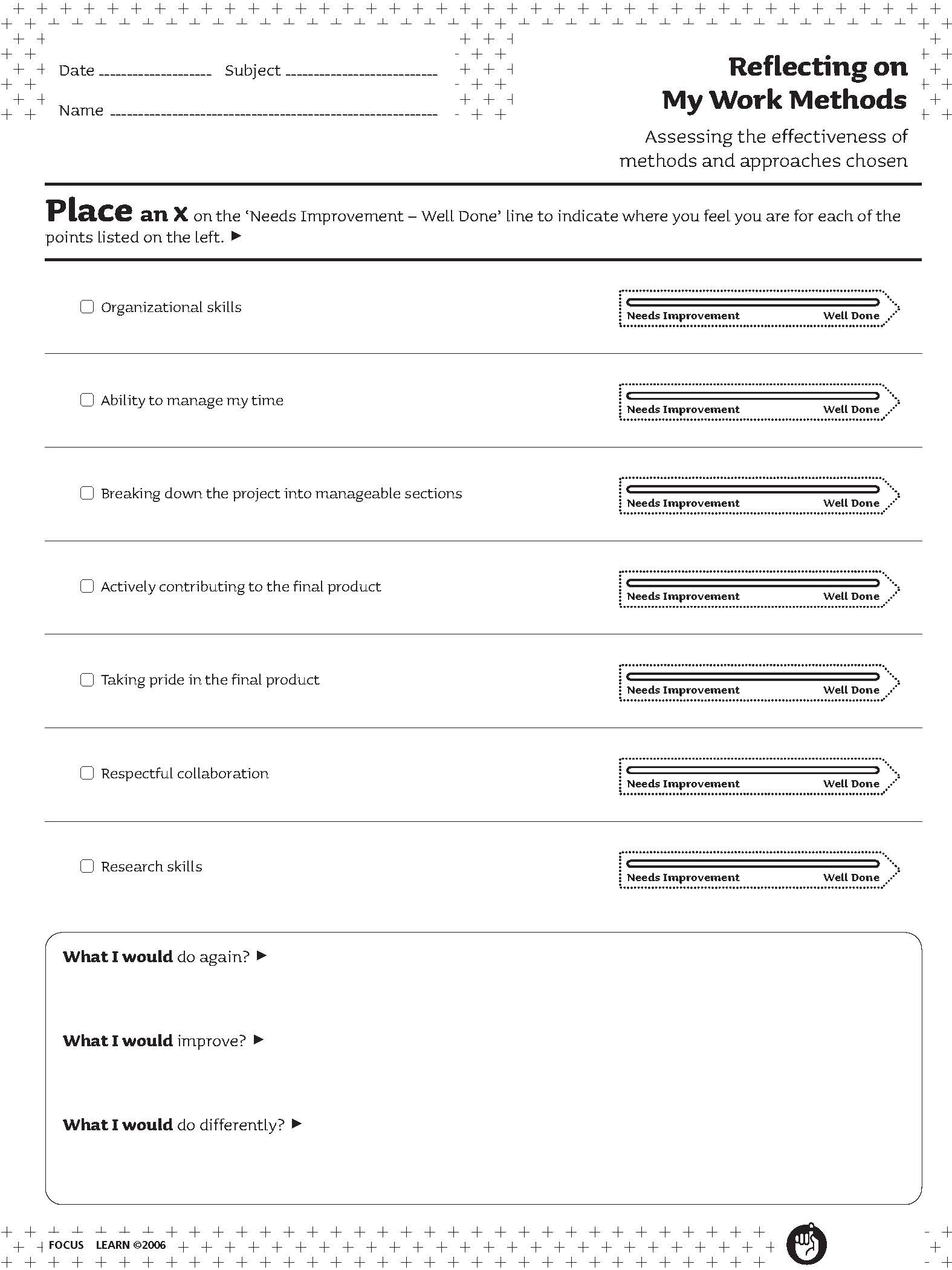 This organizer allows students to reflect on their work methods and evaluate what worked well and what they would do differently.
This organizer allows students to reflect on their work methods and evaluate what worked well and what they would do differently.
Key feature: Analyzes his/her procedure
CCC6: Uses ICT
Key Features from the QEP | In the classroom? | Graphic Organizers |
|---|---|---|
| Uses appropriate technologies - Carries out various tasks using technological resources | Description: After selecting the most suitable tools for the situation, the student is able to use technology to accomplish a variety of tasks. The student learns basic troubleshooting skills and how to effectively describe problems to peers and teachers. | ICT Blueprint |
| ICT Toolbox | ||
| Takes full advantage of these technologies - Diversifies his/her use of ICT | Description: The student makes appropriate and effective use of software and peripherals, such as scanners and digital cameras, for a variety of purposes and adapts his or her use of ICT to new situations and projects across the curriculum. By citing sources and following proper procedures, he or she respects copyright, intellectual property, and netiquette (online courtesy and protocol). | ICT Toolbox |
| My ICT Learning Goals | ||
| Using My ICT Strengths | ||
| Evaluates his/her use of this technology - Compares his/her ways of using ICT with those of others | Description: Working with peers, the student learns to identify his or her strengths and weaknesses using ICT. He or she improves through practice and experimentation and by seeking advice when needed. The student assessses the usefulness of the tecchnological resources that were employed and their function in his or her work. | My ICT Learning Goals |
| Using ICT | ||
| Using my ICT Strengths |
CCC 6.2: ICT Blueprint
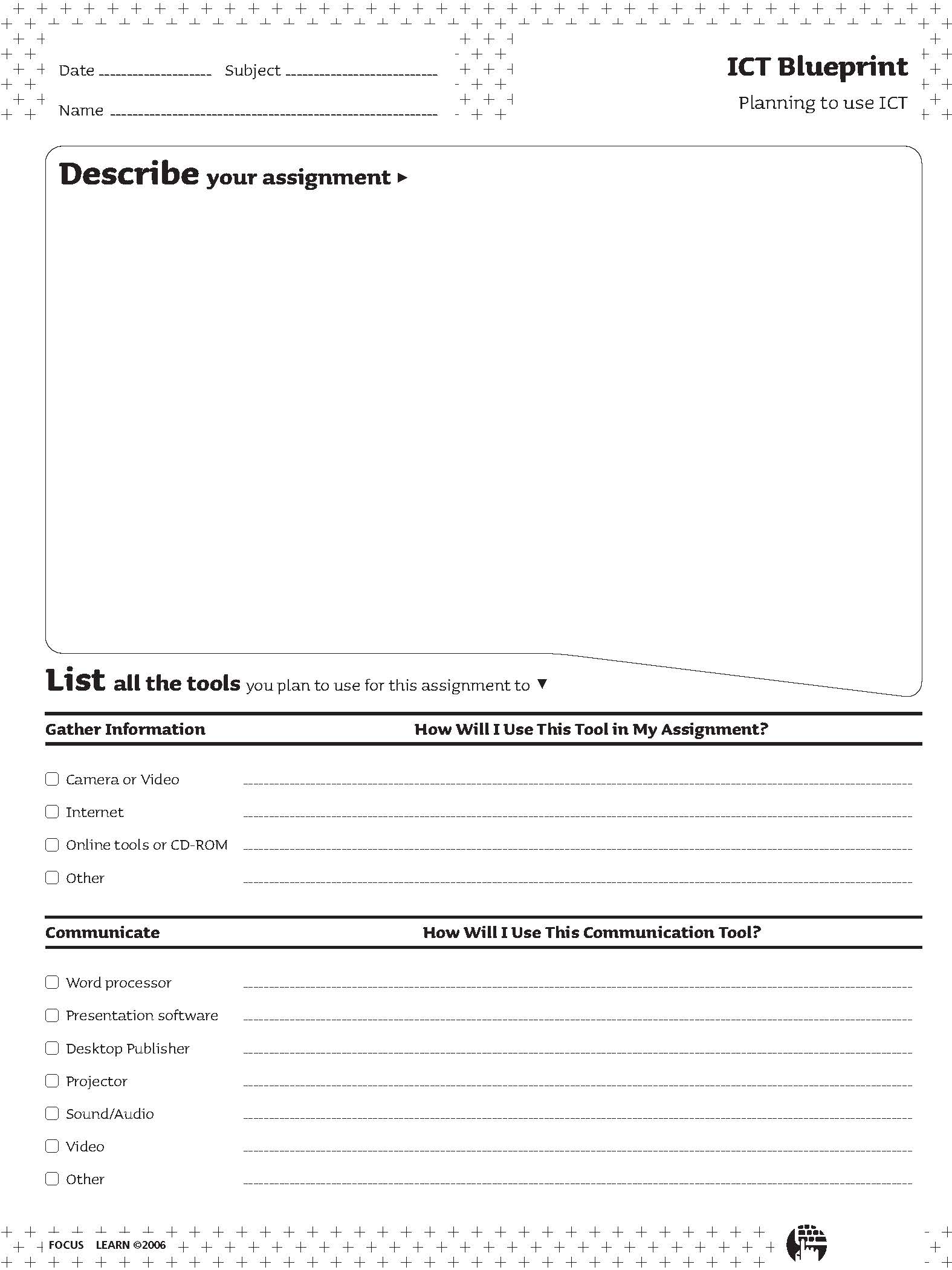 This organizer helps students select the most suitable ICT tools for their task. Students are guided to select tools to help them gather information and communicate.
This organizer helps students select the most suitable ICT tools for their task. Students are guided to select tools to help them gather information and communicate.
Key feature: Uses appropriate technologies
CCC 6.3: ICT Toolbox
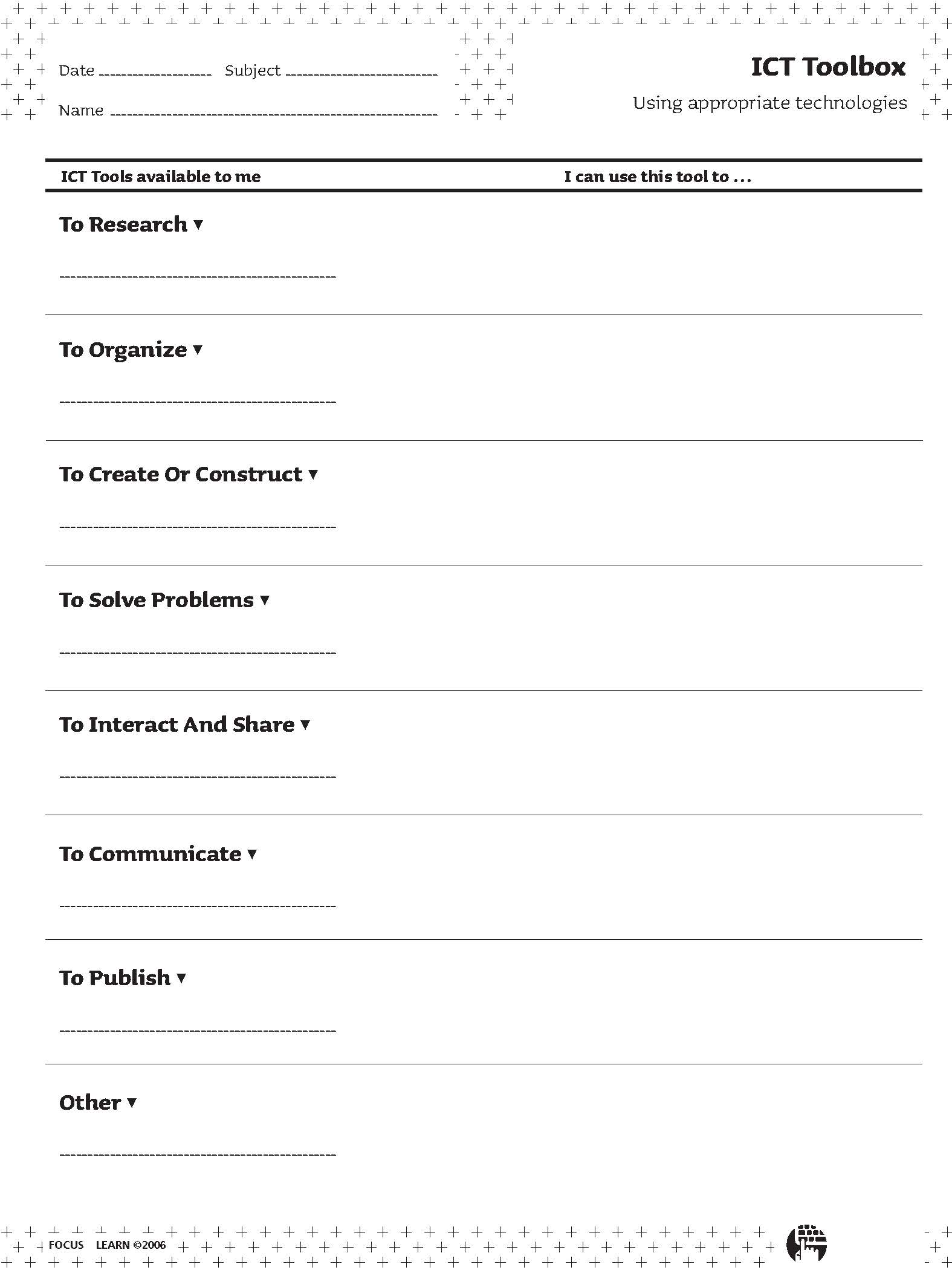 This organizer is designed to help students identify the ICT tools available to them as they plan their work.
This organizer is designed to help students identify the ICT tools available to them as they plan their work.
Key feature: Uses appropriate technologies, Takes full advantage of these technologies
CCC 6.4: My ICT Learning Goals
 This is a personal ICT goal-setting organizer that asks students to identify learning goals and to determine how they will reach their target.
This is a personal ICT goal-setting organizer that asks students to identify learning goals and to determine how they will reach their target.
Key features: Takes full advantage of these technologies, Evaluates his/her use of this technology
CCC 6.8: Using ICTs
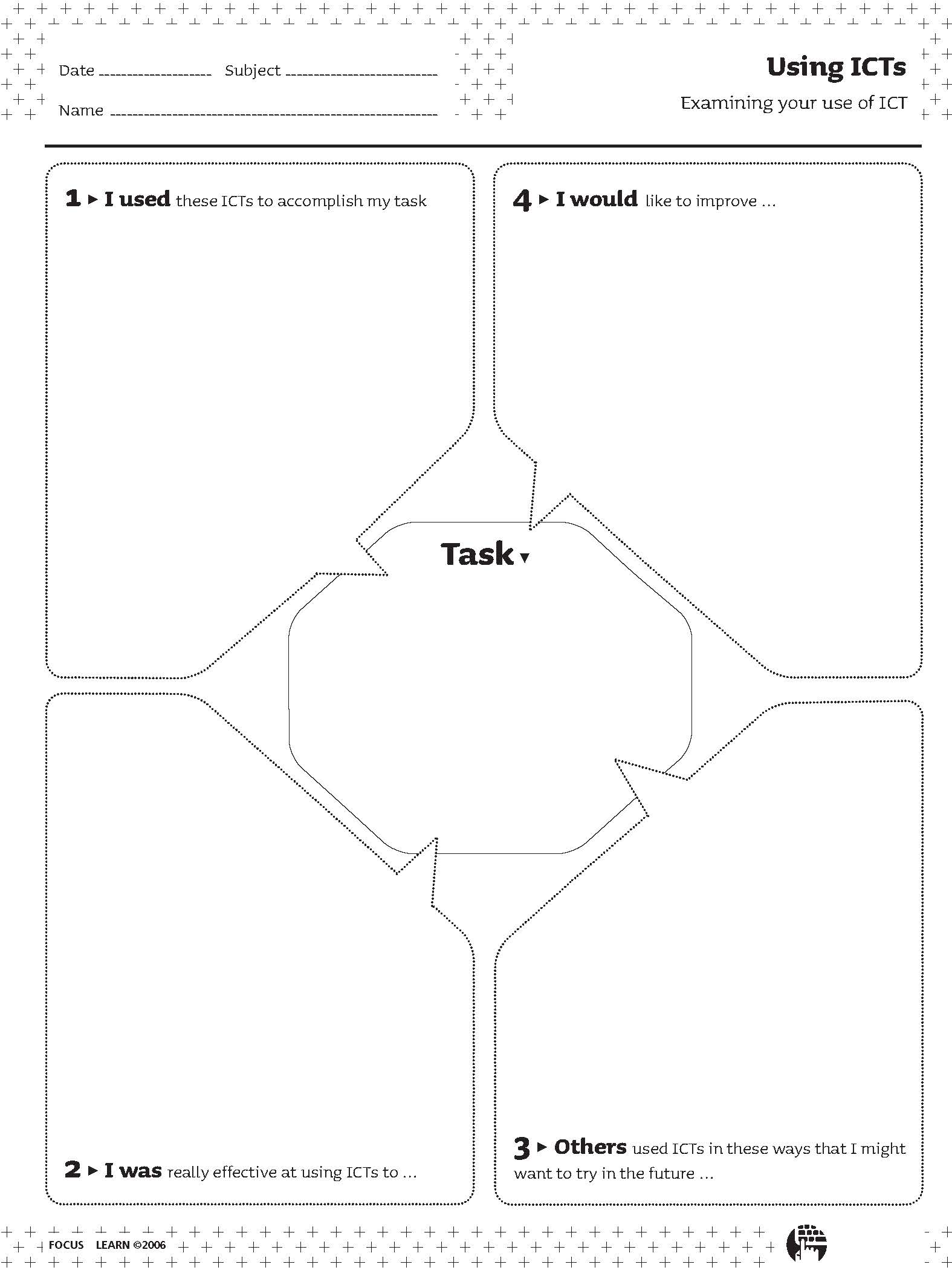 This organizer asks students to reflect on their use of ICT and to identify their strengths and areas for improvement.
This organizer asks students to reflect on their use of ICT and to identify their strengths and areas for improvement.
Key feature: Evaluates his/her use of this technology
CCC7: Uses His/Her Potential
Key Features from the QEP | In the classroom? | Graphic Organizers |
|---|---|---|
| Recognizes his/her personal characteristics - Identifies his/her feelings, thoughts, vaues, cultural frame of reference and options | Description: The student is gaining a sense of self and is becoming aware of the roles that he or she may take on in society. The student is developing a sense of his or her strengths and weaknesses, aptitudes, and interests. He or she is increasingly able to see the positive and negative aspects of the choices made on a daily basis and to recognize the impact of these actions on his or her life. The student is able to assess his or her own growth and potential as a learner. | Different Perspectives |
| Discussing With Others | ||
| Goal and Action Plan | ||
| Things About Me | ||
| Takes his/her place among others - Recognizes that he/she is part of a community | Description: The student sees him or herself as an individual who belongs to a larger social and cultural group. He or she recognizes the influence that these groups may have on his or her identity. The student can express his or her thoughts and feelings without trying to impose his or her views on others. | Common Ground |
| Different Perspectives | ||
| Discussing with Others | ||
| From Goals to Action | ||
| Makes good use of his/her personal resources - Establishes short- and long-term goals | Description: With some guidance, the student is able to set personal and academic goals based on criteria that he or she has established as a measure of success. He or she takes ownership and responsibility for achieving these goals and does not give up when faced with difficulties. | From Goals to Actions |
| From Values to Actions | ||
| Goal and Action Plan | ||
| Spheres of Influence | ||
| Things About Me |
CCC 7.1: Common Ground
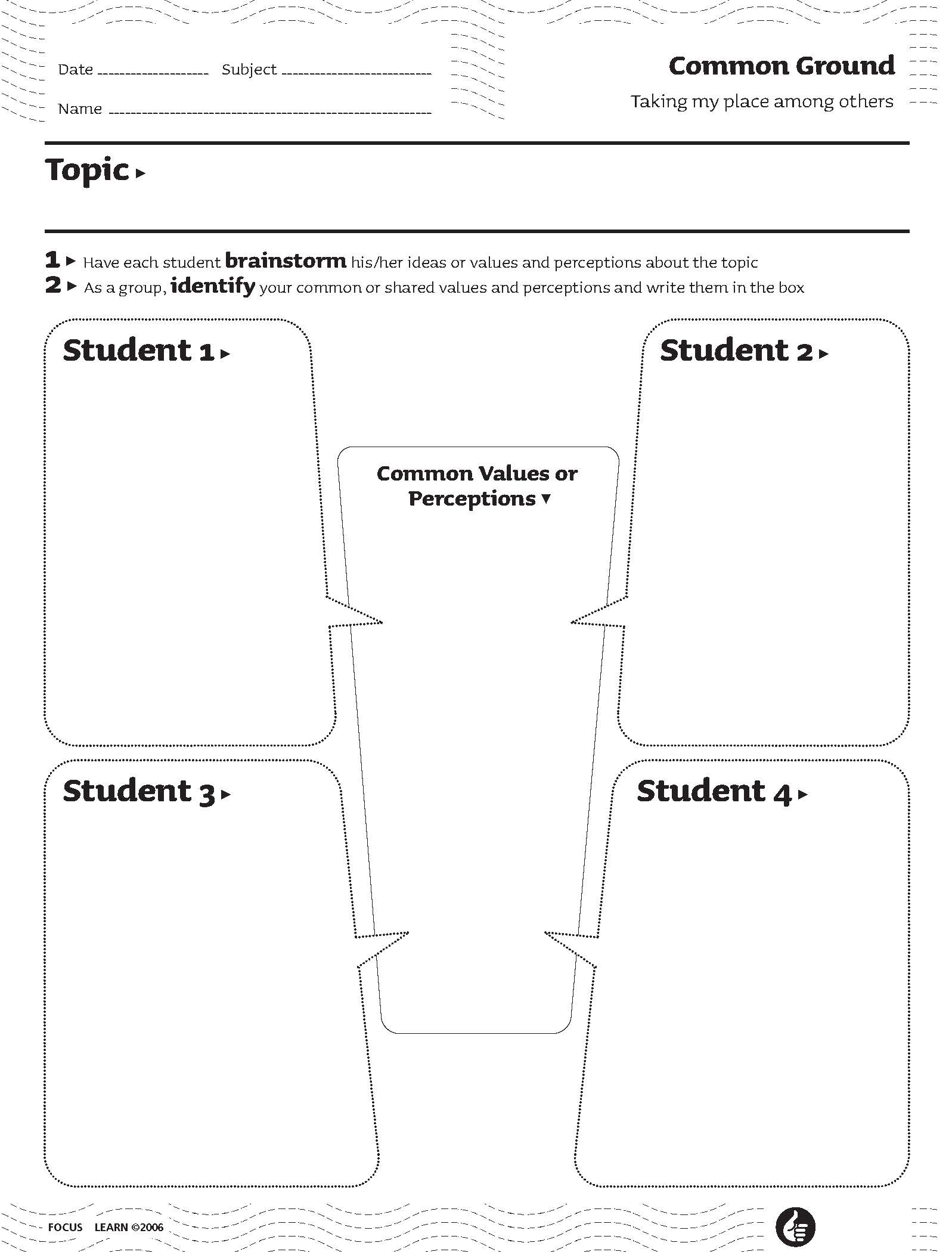 This organizer allows students to share their values or perceptions with their team members and then identify their shared values.
This organizer allows students to share their values or perceptions with their team members and then identify their shared values.
Key feature: Takes his/her place among others
CCC 7.3: Different Perspectives
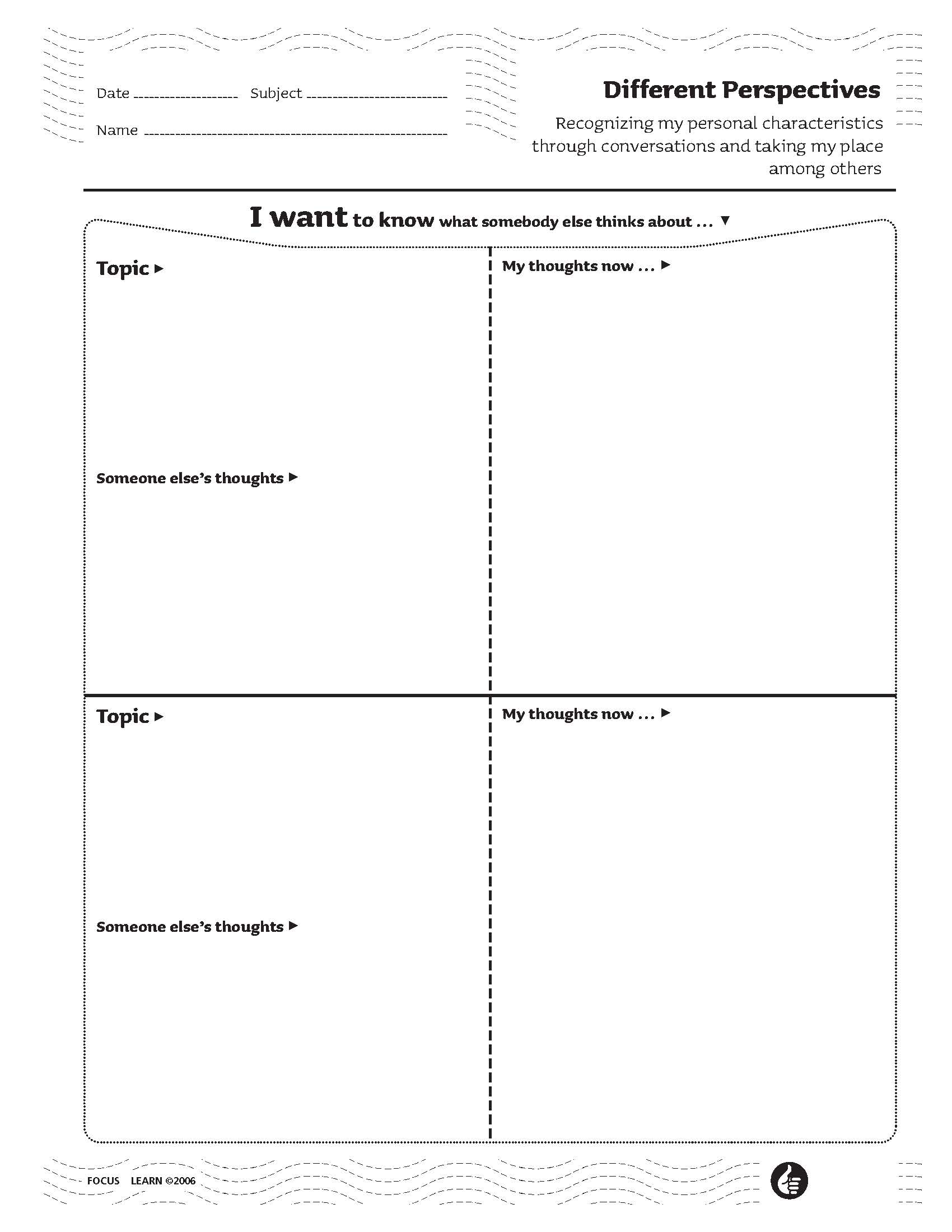 This organizer is designed to help students share their feelings and values and compare their views with the views of others.
This organizer is designed to help students share their feelings and values and compare their views with the views of others.
Key features: Recognizes his/her personal characteristics, Takes his/her place among others
CCC 7.4: Discussing with Others
 This organizer is an excellent individual follow-up to a group discussion and encourages students to reflect on the influence of others on his/her viewpoint.
This organizer is an excellent individual follow-up to a group discussion and encourages students to reflect on the influence of others on his/her viewpoint.
Key features: Recognizes his/her personal characteristics, Takes his/her place among others
CCC 7.5: From Goals to Actions
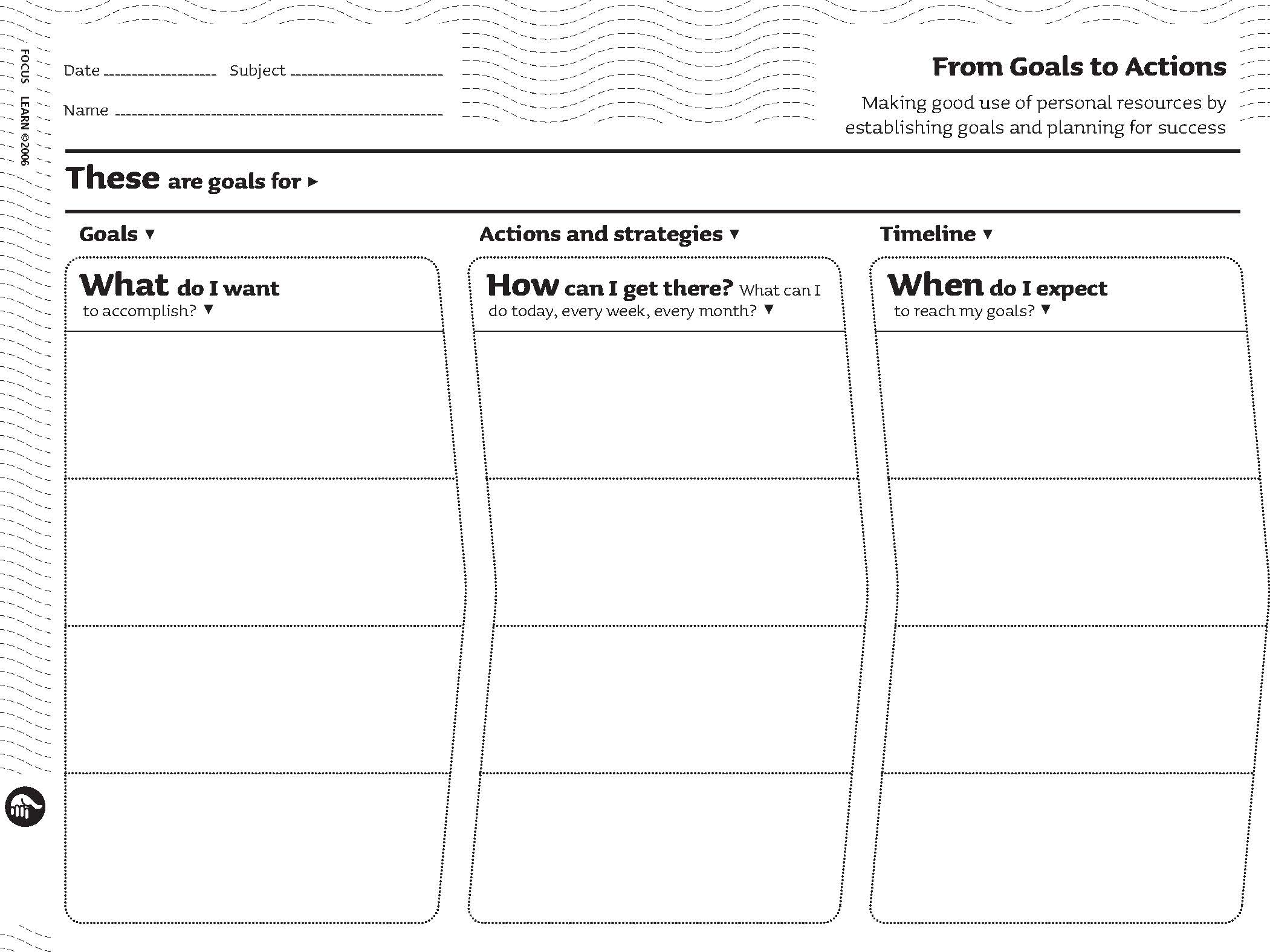 This organizer helps students to concretely note the goals they wish to accomplish. It allows them to visualize their proposed plan of action and the timeframe in which the goal will be reached.
This organizer helps students to concretely note the goals they wish to accomplish. It allows them to visualize their proposed plan of action and the timeframe in which the goal will be reached.
Key feature: Makes good use of his/her personal resources
CCC 7.6: From Values to Actions
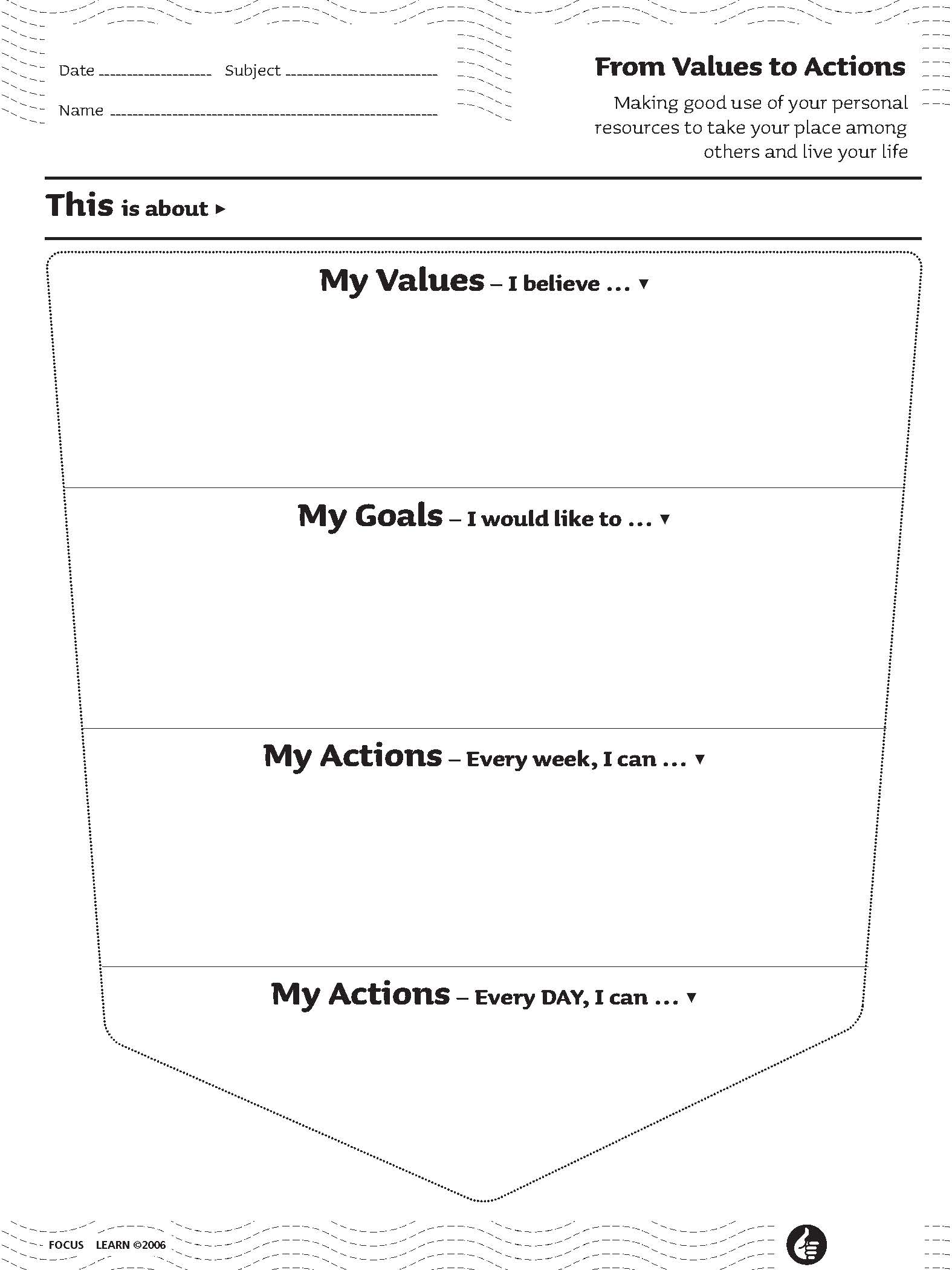 This organizer facilitates planning and assists students in establishing goals and evaluating their choices of action and achievements based on the values they hold.
This organizer facilitates planning and assists students in establishing goals and evaluating their choices of action and achievements based on the values they hold.
Key feature: Makes good use of his/her personal resources
CCC 7.7: Goal and Action Plan
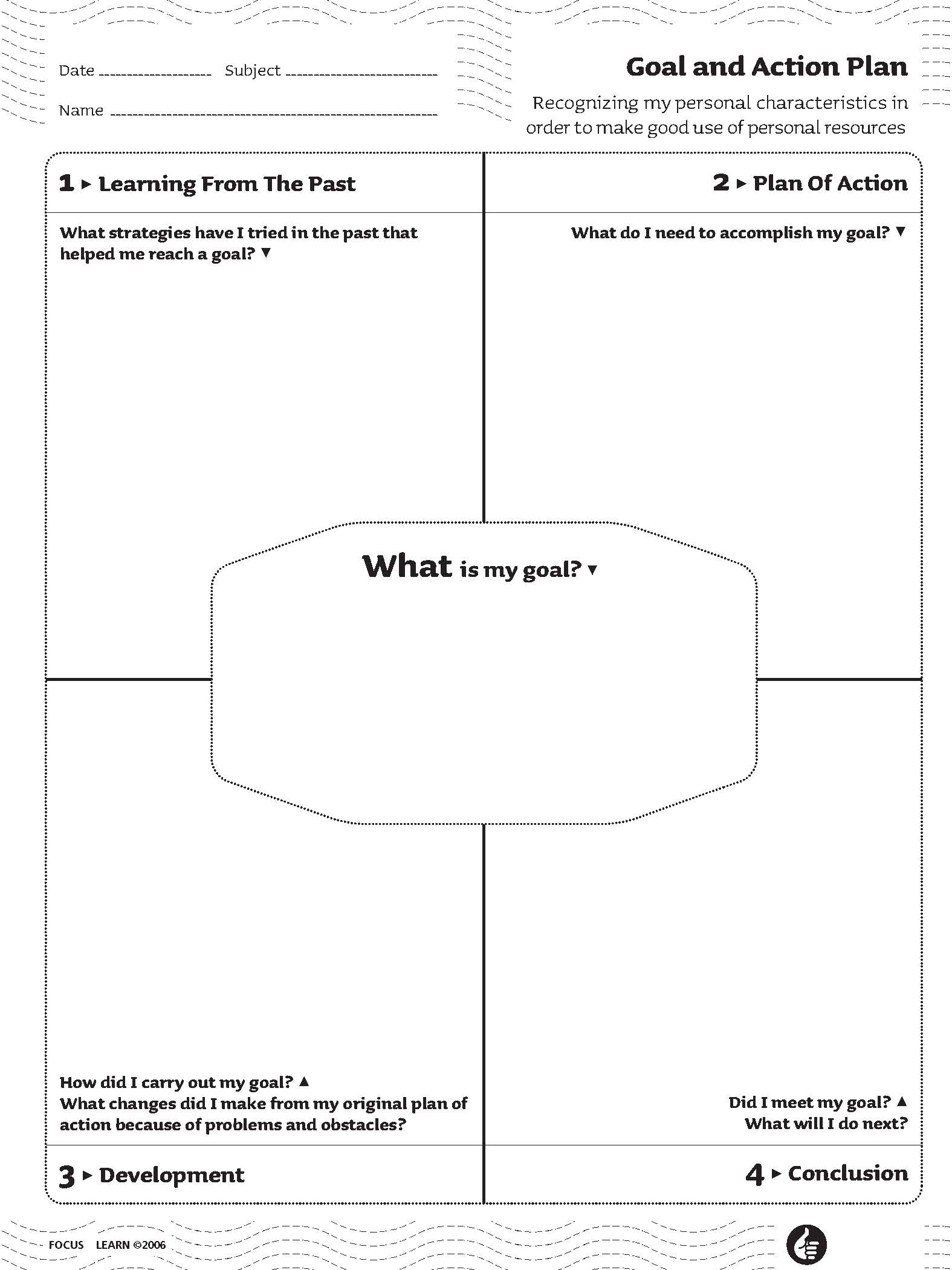 This organizer facilitates goal-setting and planning and assists student in establishing goals and evaluating their choices of action and achievements.
This organizer facilitates goal-setting and planning and assists student in establishing goals and evaluating their choices of action and achievements.
Key features: Recognizes his/her personal characteristics, Makes good use of his/her personal resources
CCC 7.10: Spheres of Influence
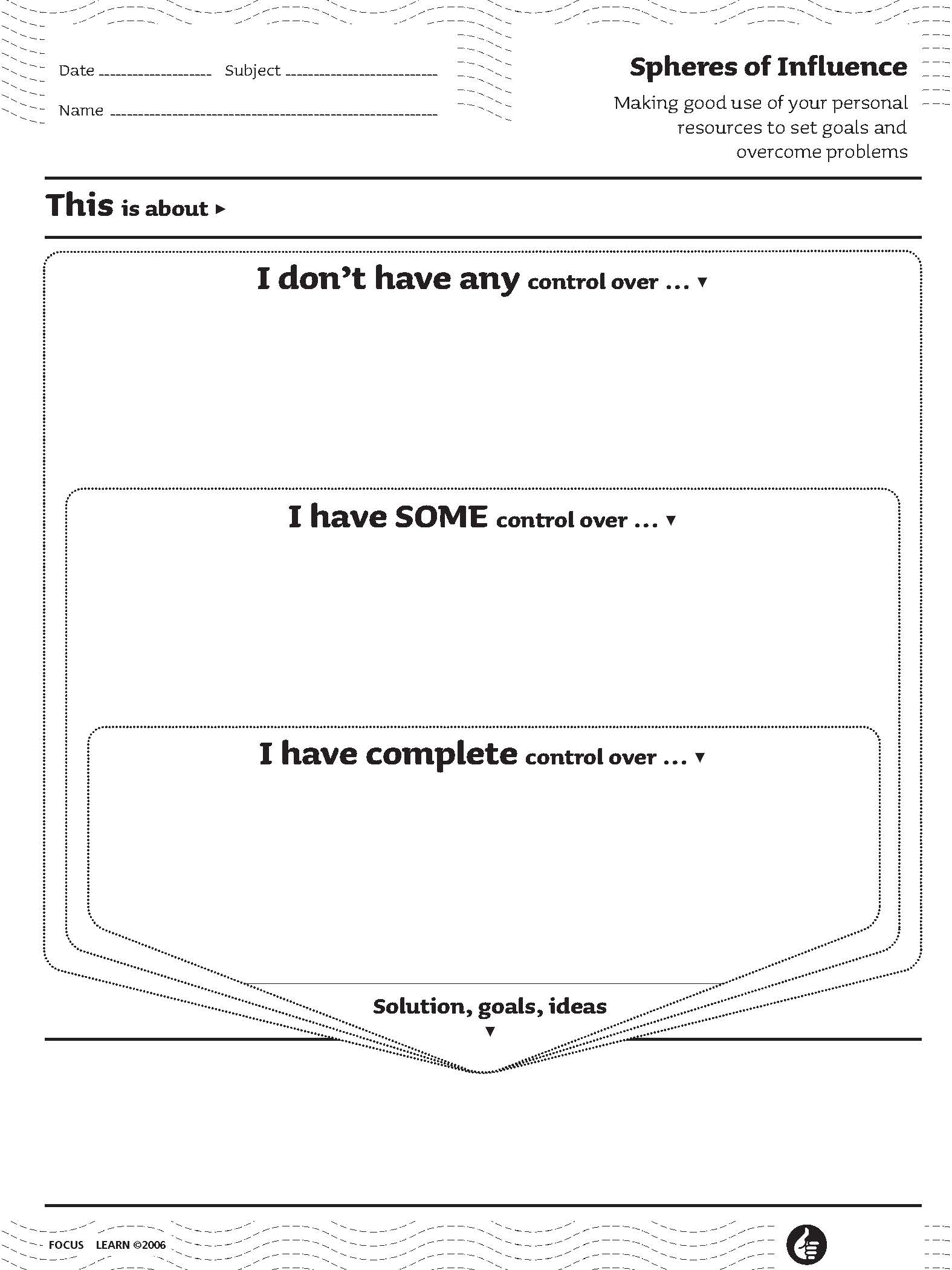 This organizer helps students take notice of how much control they have over a given situation. It guides them to focus on the areas where they can have the most impact in order to formulate goals, ideas, and solutions.
This organizer helps students take notice of how much control they have over a given situation. It guides them to focus on the areas where they can have the most impact in order to formulate goals, ideas, and solutions.
Key feature: Makes good use of his/her personal resources
CCC 7.11: Things About
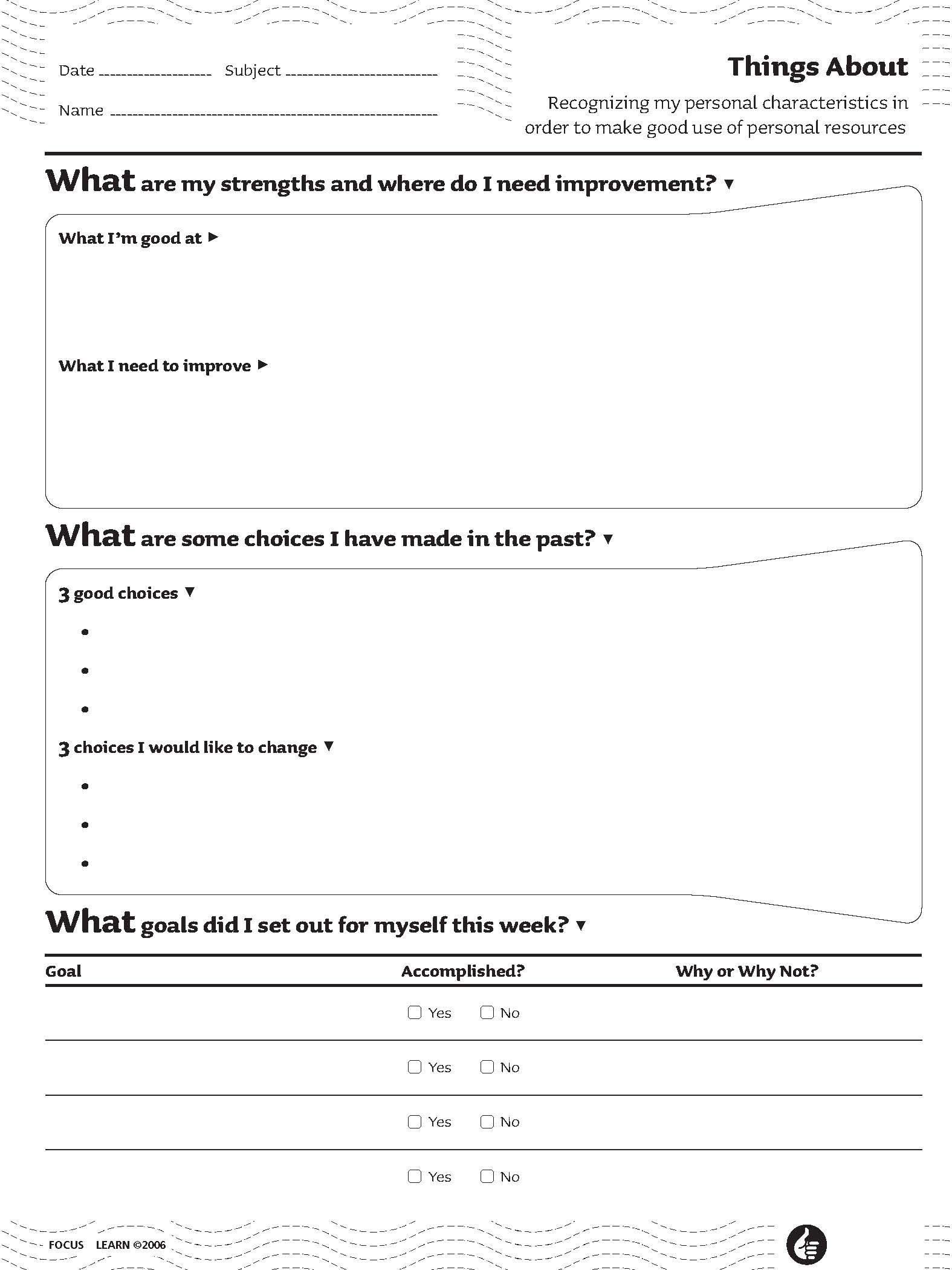 This organizer is designed to help students gain self-awareness by identifying their strengths and areas where they need improvement and to reflect on some of the choices they made in the past. It also encourages student to keep track of the goals they have set for themselves and to evaluate their progress.
This organizer is designed to help students gain self-awareness by identifying their strengths and areas where they need improvement and to reflect on some of the choices they made in the past. It also encourages student to keep track of the goals they have set for themselves and to evaluate their progress.
Key features: Recognizes his/her personal characteristics, Makes good use of his/er personal resources
CCC8: Cooperates With Others
Key Features from the QEP | In the classroom? | Graphic Organizers |
|---|---|---|
| Contributes to team efforts - Assesses what sort of collaboration or cooperation a task lends itself to | Description: The student recognizes when and how it is best to work with others to accomplish a task. He or she participates actively in pairs, small groups, or larger teams. The student is aware of his or her own strengths and shares them with his or her teammates for the benefit of the group. He or she is able to accomplish tasks individually and with others, according to the plan set out by the team. When a conflict occurs, the student can negotiate to find a compromise that will be accepted and implemented by team members. | Our Team Agrees On... |
| Our Responsibilities | ||
| Our Strengths | ||
| We Disagree...Now What? (3- & 4-person group) | ||
| Uses teamwork effectively - Recognizes which tasks can be done more effectively by means of teamwork | Description: The student is able to determine which tasks to take on as a whole team and when to split the workload amongst teammates. The student realizes how he or she contributes to the group's efforts and how others' contributions have facilitated his or her learning. Throughout the task, the student reflects on his or her own participation and that of other team members and suggests changes to improve the team's process. | Coooperative Learning Peer Evaluation |
| Our Responsibilities | ||
| Taking Stock | ||
| To Do List | ||
| We Disagree...Now What? (3- & 4-person group) | ||
| Interacts with an open mind in various contexts - Accepts others as they are and recognizes their interests and needs | Description: The student works on accepting and respecting others in the team, recognizing that all points of view should be heard. He or she adapts his or her behaviour in order to create a positive and productive work environment and to meet teammates' needs. | Cooperative Learning Peer Evaluation |
| Our Team Agrees On | ||
| Taking Stock | ||
| We Disagree...Now What? (3- & 4-person group) |
CCC 8.2: Cooperative Learning Peer Evaluation
 This organizer will ask the student to evaluate the contribution of his or her teammates to the group's efforts and to make suggestions for improvement.
This organizer will ask the student to evaluate the contribution of his or her teammates to the group's efforts and to make suggestions for improvement.
Key features: Uses teamwork effectively, Interacts with an open mind in various contexts
CCC 8.4: Our Responsibilities
 This organizer helps students to identify which tasks to take on as a team and which to divide amongst members. It asks students to assign specific tasks to each team member and encourages them to keep track of their progress.
This organizer helps students to identify which tasks to take on as a team and which to divide amongst members. It asks students to assign specific tasks to each team member and encourages them to keep track of their progress.
Key features: Contributes to team efforts, Uses teamwork effectively
CCC 8.5: Our Strengths
 This organizer asks students to identify the strengths of each team member then selects tasks based on their aptitudes.
This organizer asks students to identify the strengths of each team member then selects tasks based on their aptitudes.
Key feature: Contributes to team efforts
CCC 8.6: Our Team Agrees On ...
 This organizer allows all team members to participate in establishing a procedure and carrying out the task.
This organizer allows all team members to participate in establishing a procedure and carrying out the task.
Key features: Contributes to team efforts, Interacts with an open mind in various contexts
CCC 8.8: Taking Stock
 This organizer is designed to help students evaluate their progress and adjust their strategies as required throughout the collaborative process.
This organizer is designed to help students evaluate their progress and adjust their strategies as required throughout the collaborative process.
Key features: Uses teamwork effectively, Interacts with an open mind in various contexts
CCC 8.10: To Do List
 This organizer helps teams plan different tasks by identifying the required resources and which member will be responsible for which task.
This organizer helps teams plan different tasks by identifying the required resources and which member will be responsible for which task.
Key feature: Uses teamwork effectively
CCC 8.11: We Disagree...Now What? (Resolving conflict in a 3-person group)
 This organizer helps students resolve a conflict in a three-person group. Each student has the opportunity to express, in writing, what they disagree about and the group must come to a compromise and consensus.
This organizer helps students resolve a conflict in a three-person group. Each student has the opportunity to express, in writing, what they disagree about and the group must come to a compromise and consensus.
Key features: Contributes to team efforts, Uses teamwork effectively, Interacts with an open mind in various contexts
CCC 8.12: We Disagree...Now What? (Resolving conflict in a 4-person group)
 This organizer helps students resolve a conflict in a four-person group. Each student has the opportunity to express, in writing, what they disagree about, and the croup must come to a compromise or consensus.
This organizer helps students resolve a conflict in a four-person group. Each student has the opportunity to express, in writing, what they disagree about, and the croup must come to a compromise or consensus.
Key features: Contributes to team efforts, Uses teamwork effectively, Interacts with an open mind in various contexts
CCC9: Communicates Responsibly
Key Features from the QEP | In the classroom? | Graphic Organizers |
|---|---|---|
| Becomes familiar with various modes of communication - Knows and observes usage, rules, codes, and conventions associated with different modes of communication | Description: The student is at ease with various modes of communication - verbal, visual, musical, gestural, symbolic, or media-related. He or she uses them appropriately to express his or her ideas, thoughts, and feelings across the curriculum. The student explores the resources available for different modes of communication in a variety of subject areas. | Preparing for Communication |
| Representing Information | ||
| Uses teamwork effectively - Chooses one or more modes of communication suited to the context and purpose of communication | Description: The student chooses the modes of communication that are best suited to his or her purpose and is then able to design a message that is adapted to the intended audience, e.g. younger students, peers, or adults | Knowing Your Audience |
| Preparing for Communication | ||
| Representing Information | ||
| The Process of Communication | ||
| Manages the communication process - Takes into account factors that may facilitate or hinder communication | Description: The student can set criteria for successful communication. He or she considers audience feedback and revises his or her message if needed. The student understands the communication process and can evaluate the quality of his or her productions. | Communication: Peer Feedback |
| Mission...Accomplished |
CCC 9.1: Communication: Peer Feedback
 This organizer allows students to provide a peer with feedback on their communication. It asks the student to evaluate the effectiveness of their peer's communication strategies.
This organizer allows students to provide a peer with feedback on their communication. It asks the student to evaluate the effectiveness of their peer's communication strategies.
Key feature: Manages the communication process
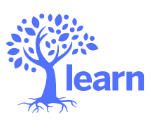
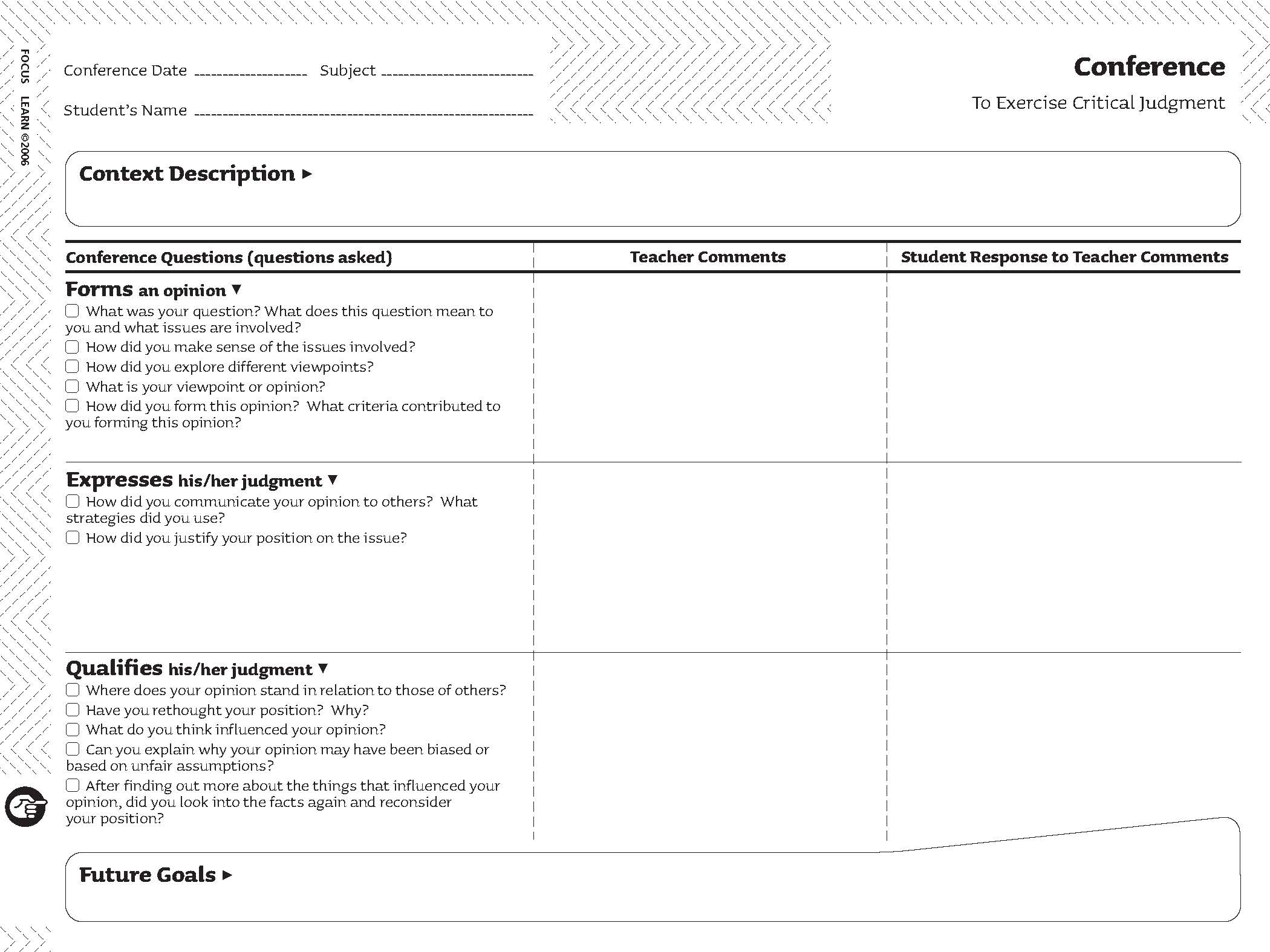
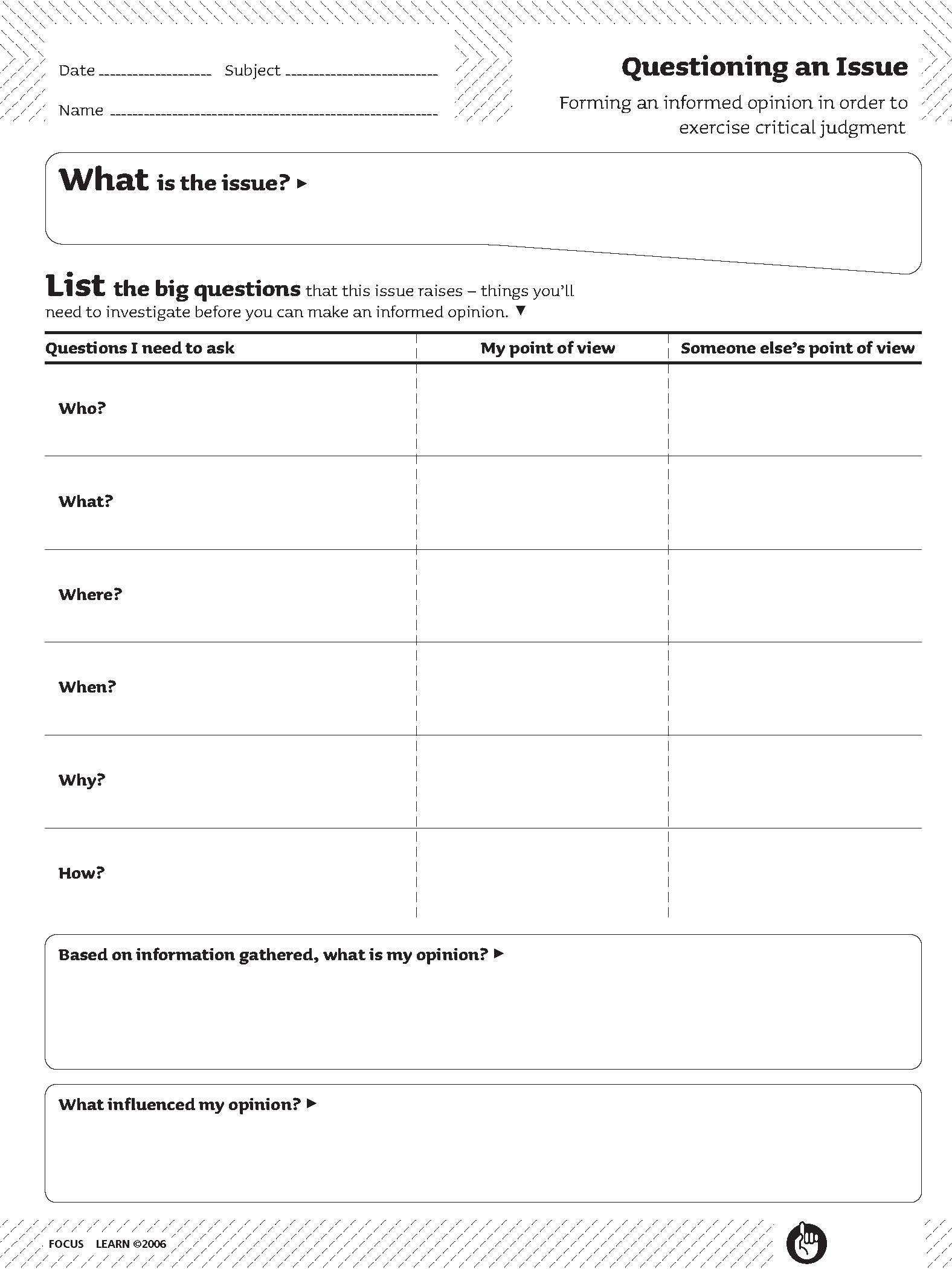

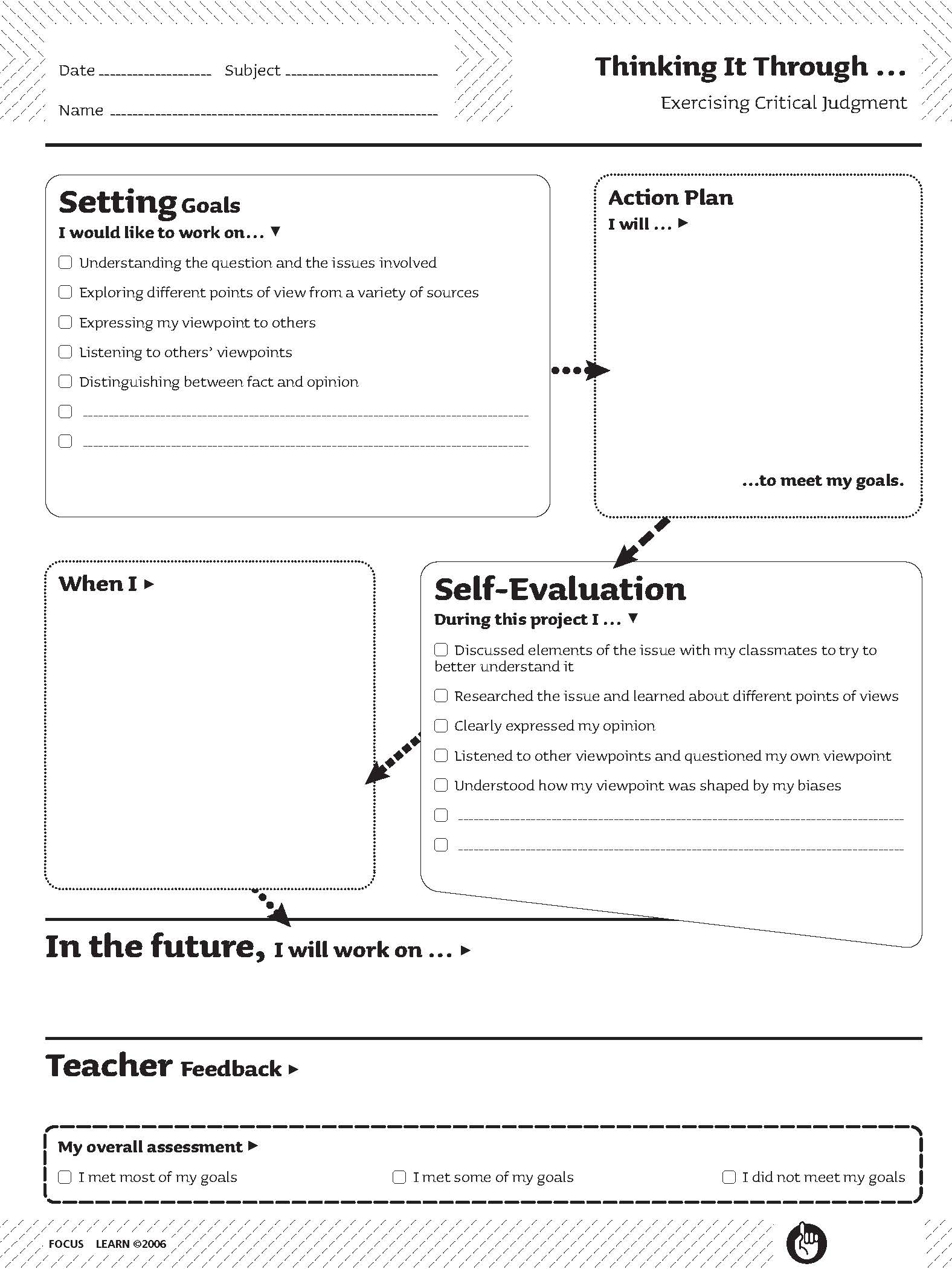
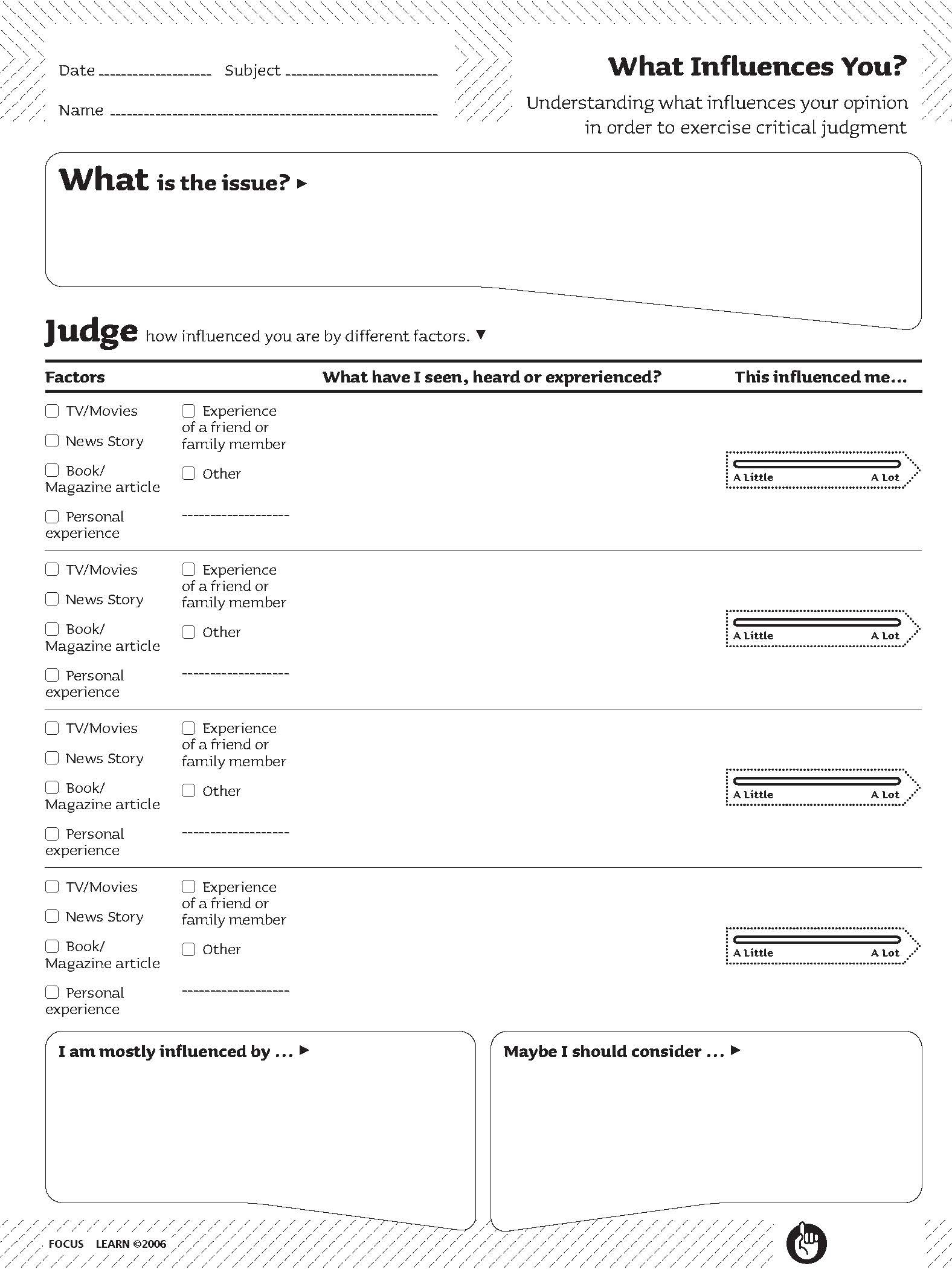
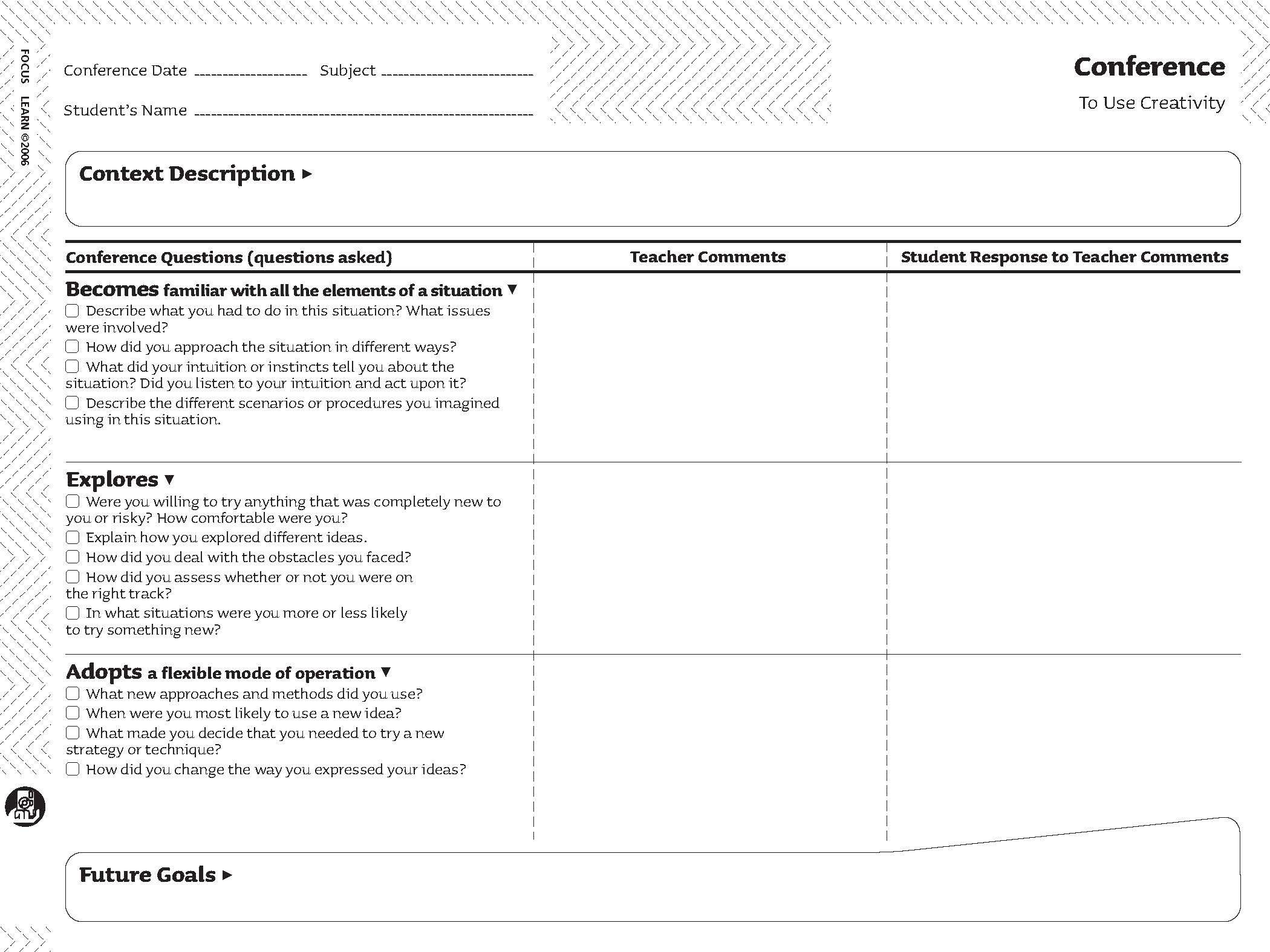
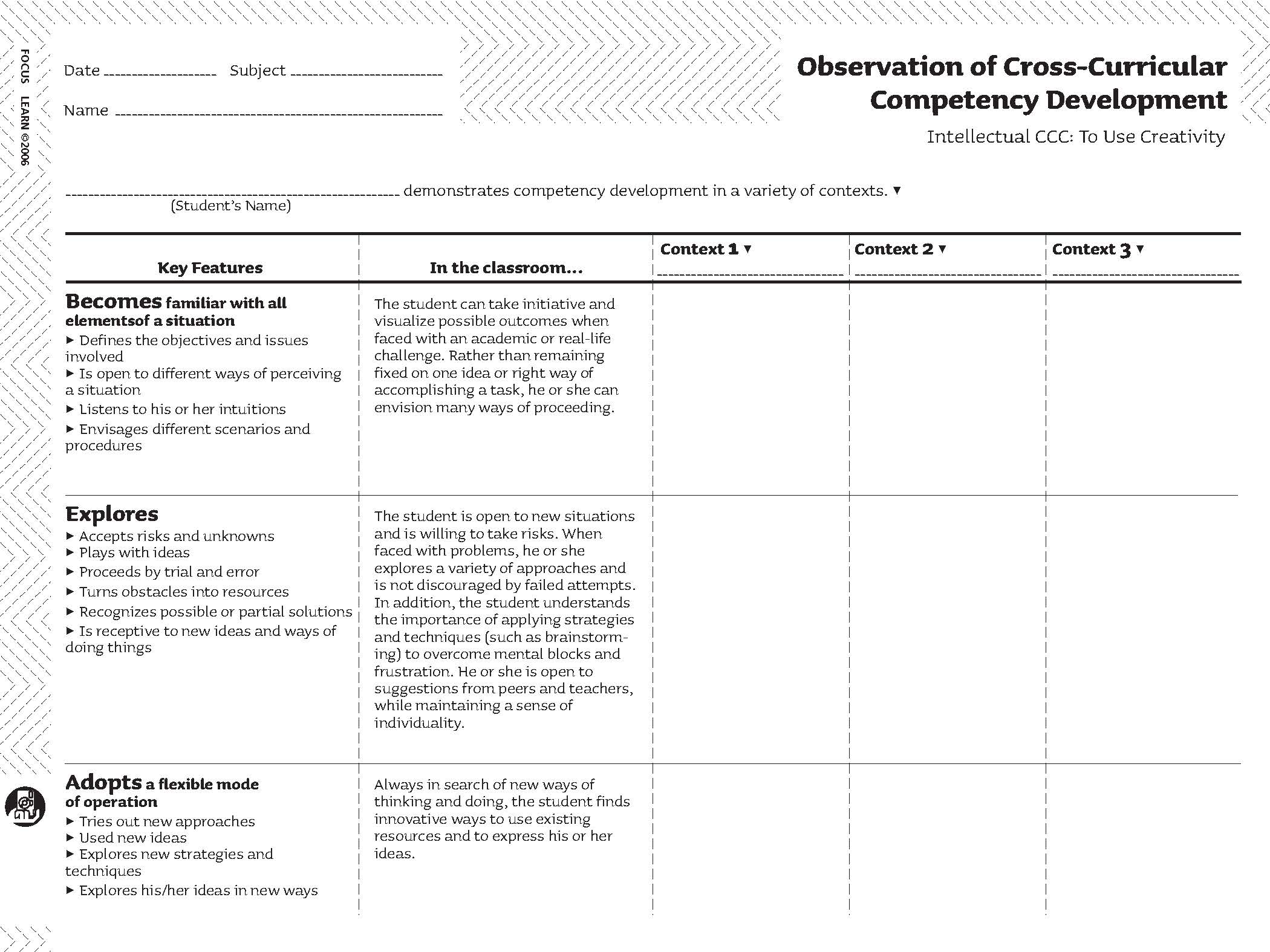
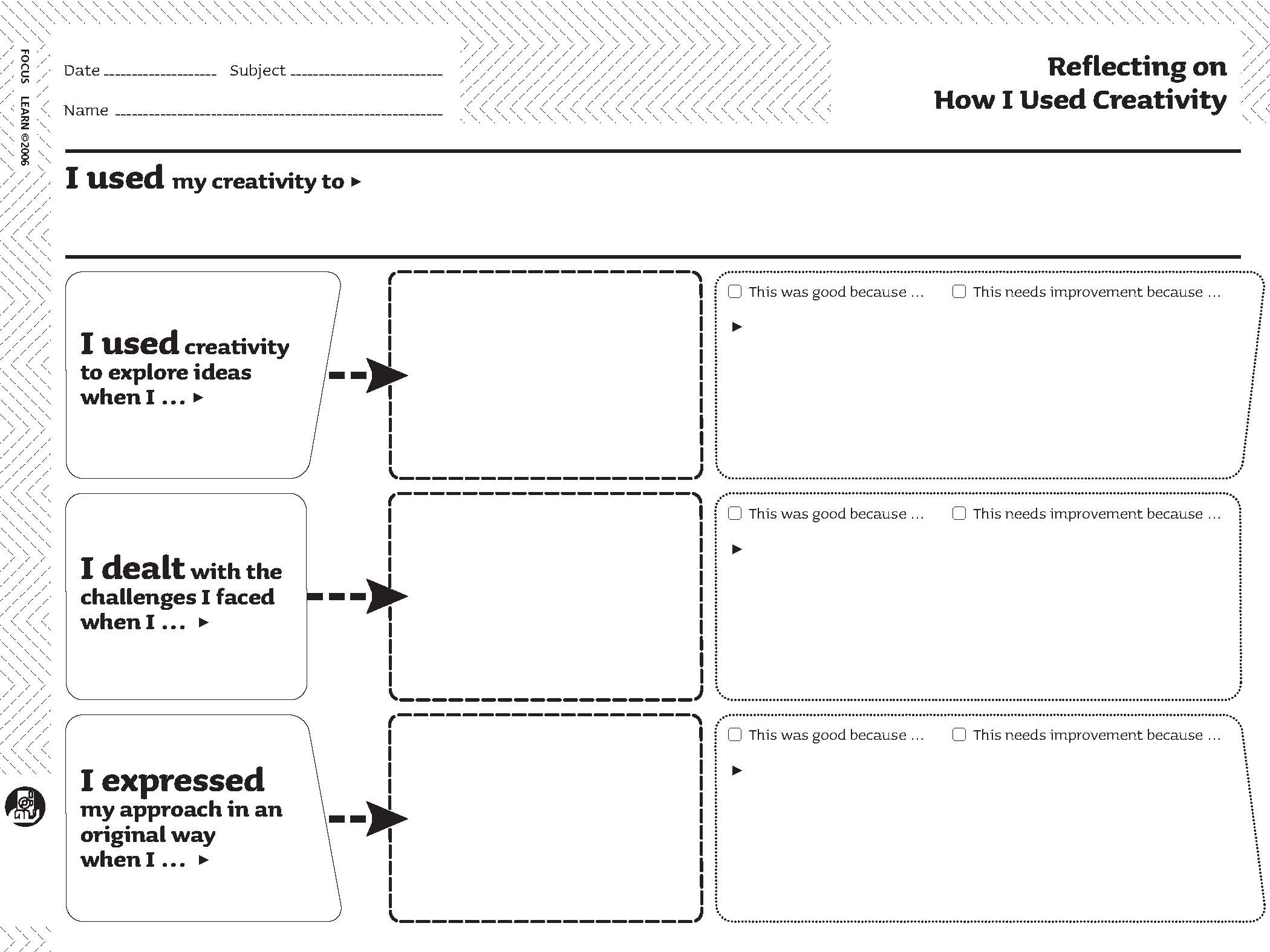
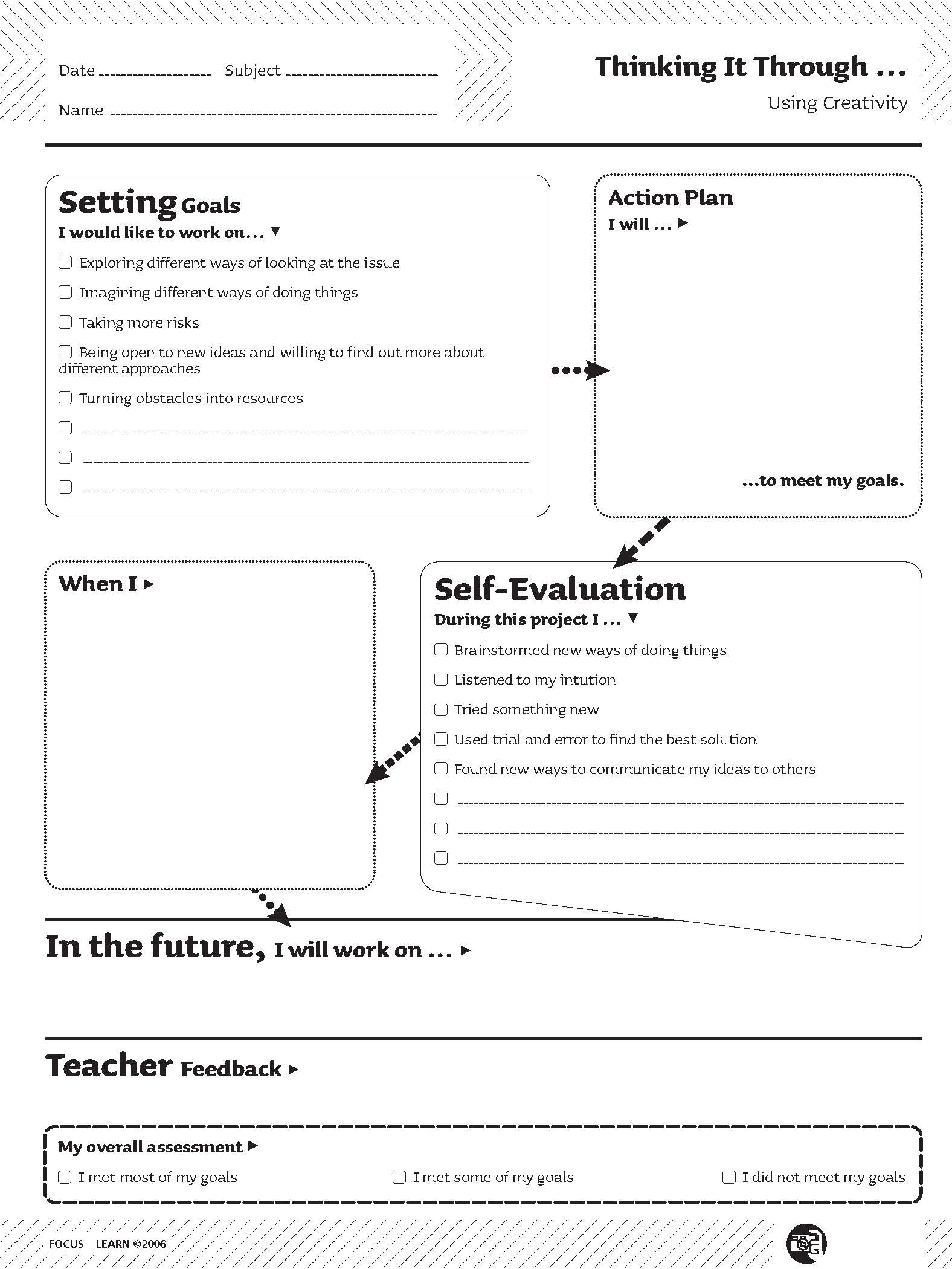
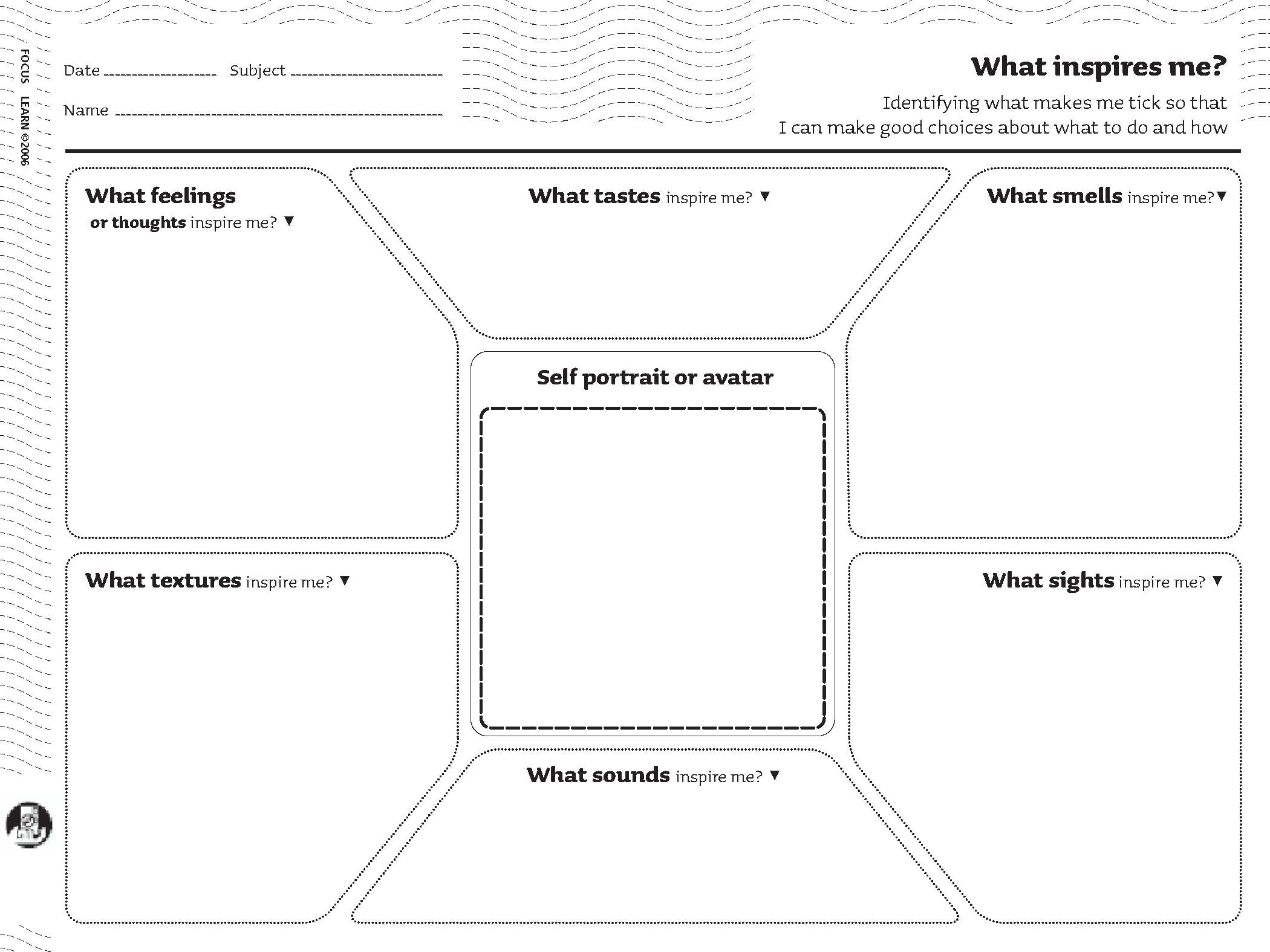

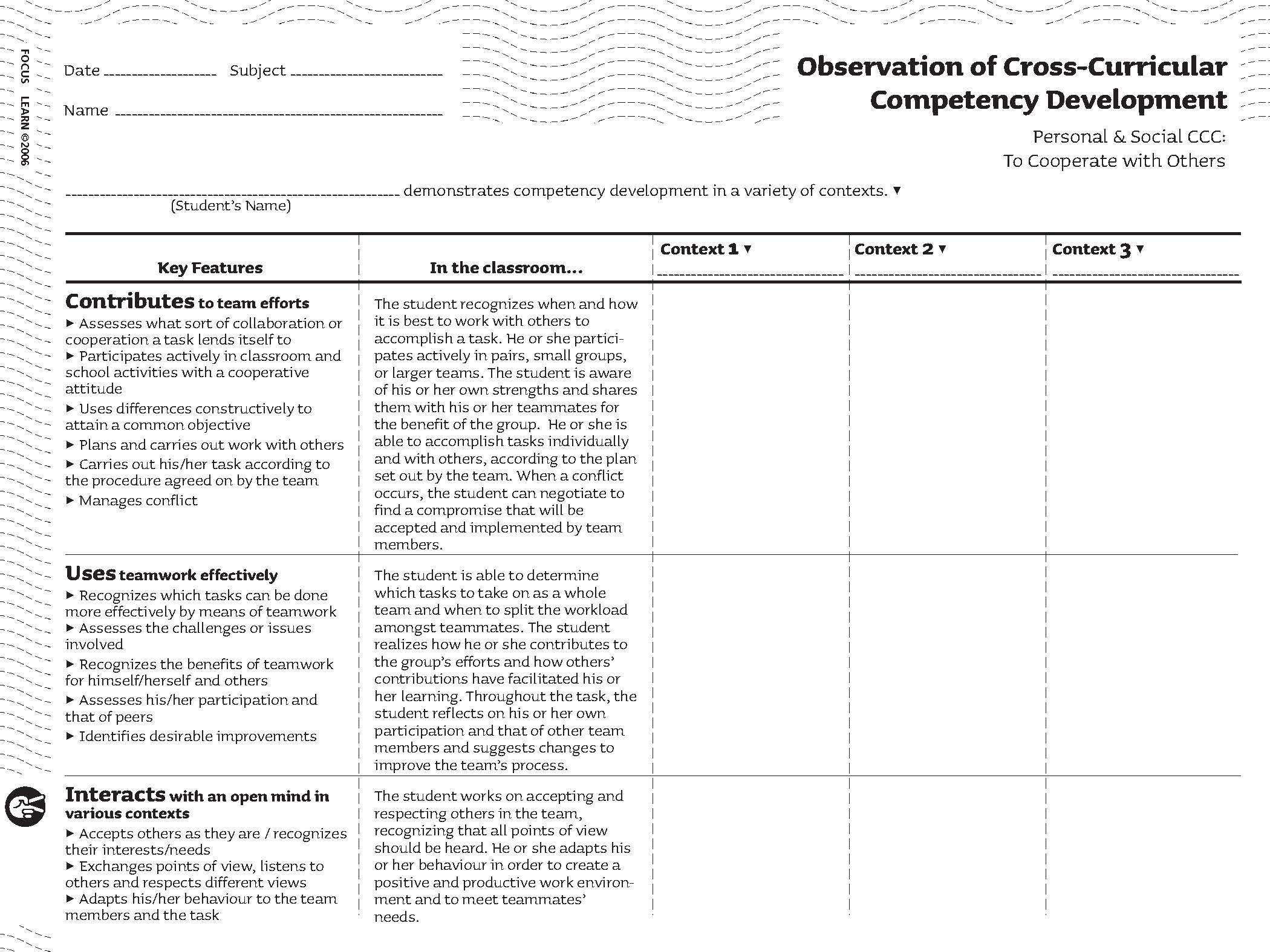
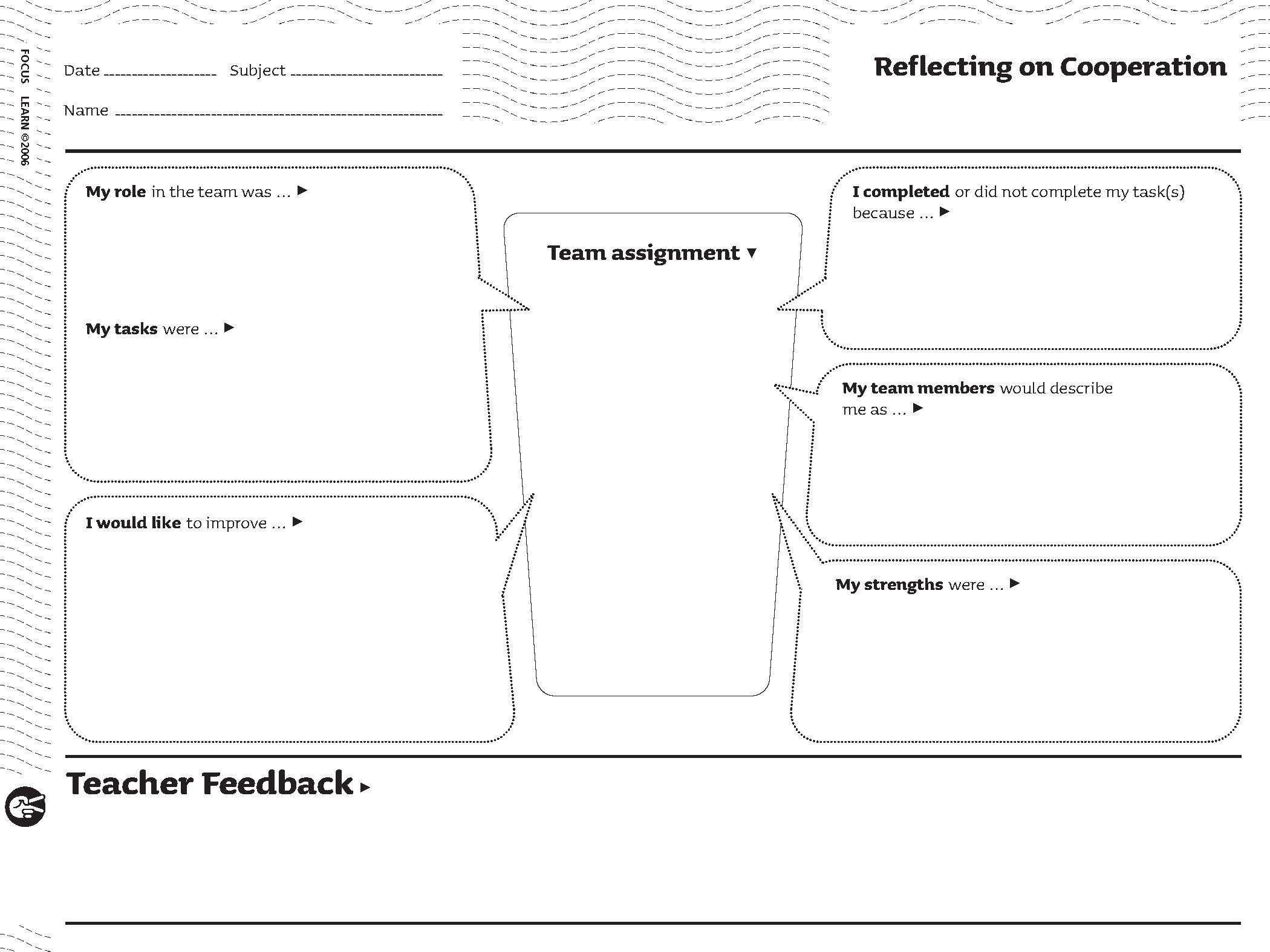
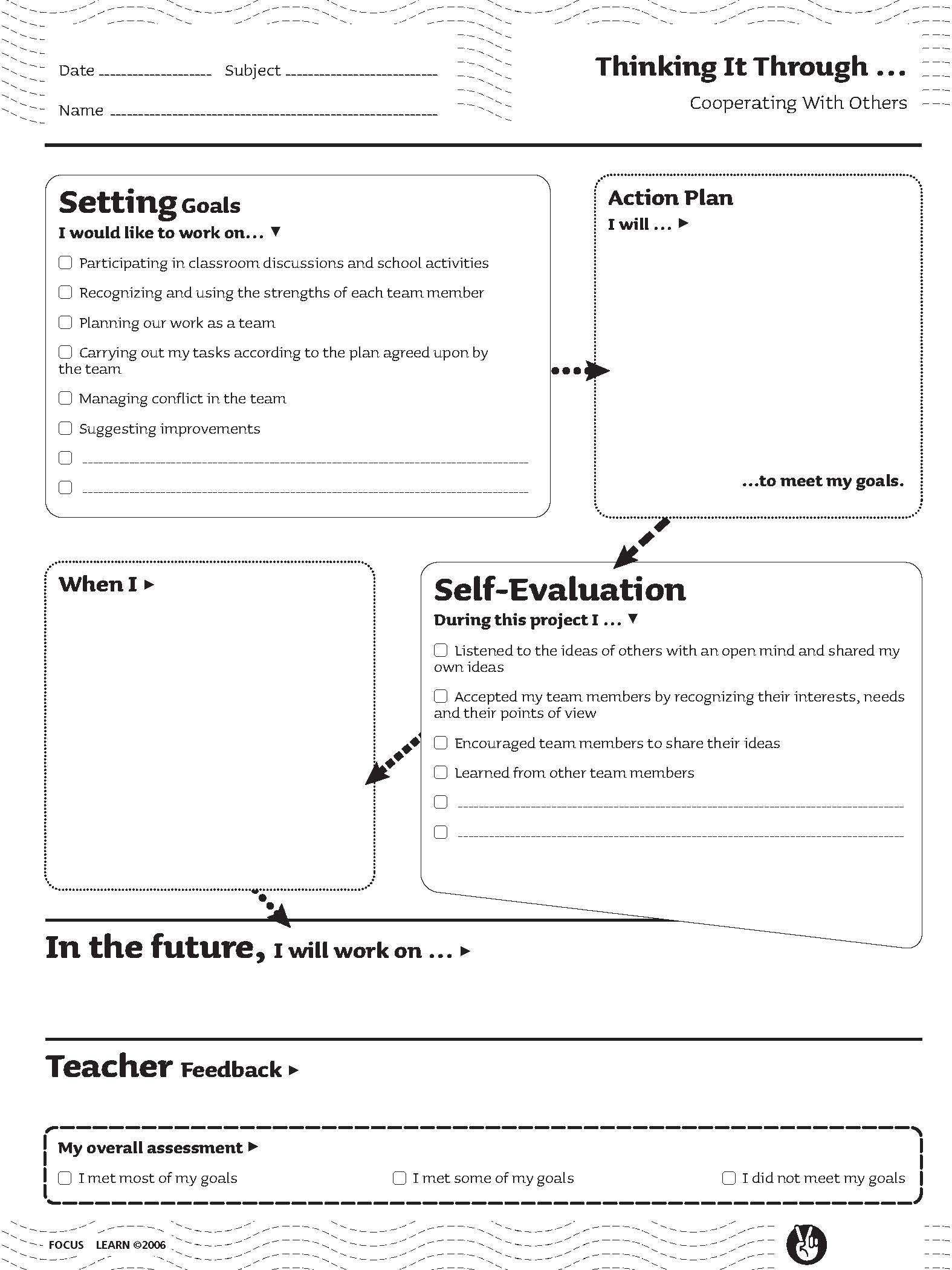


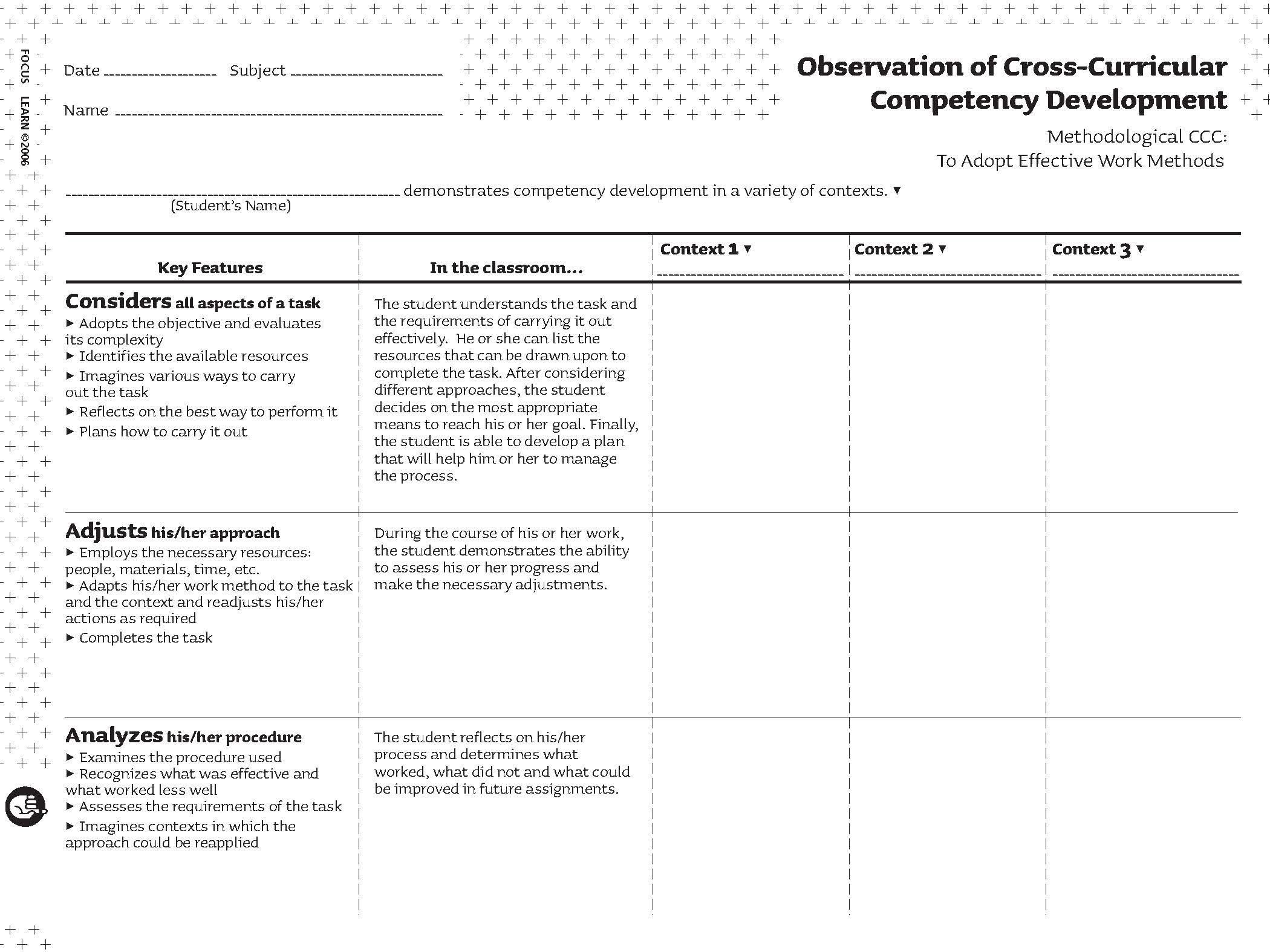
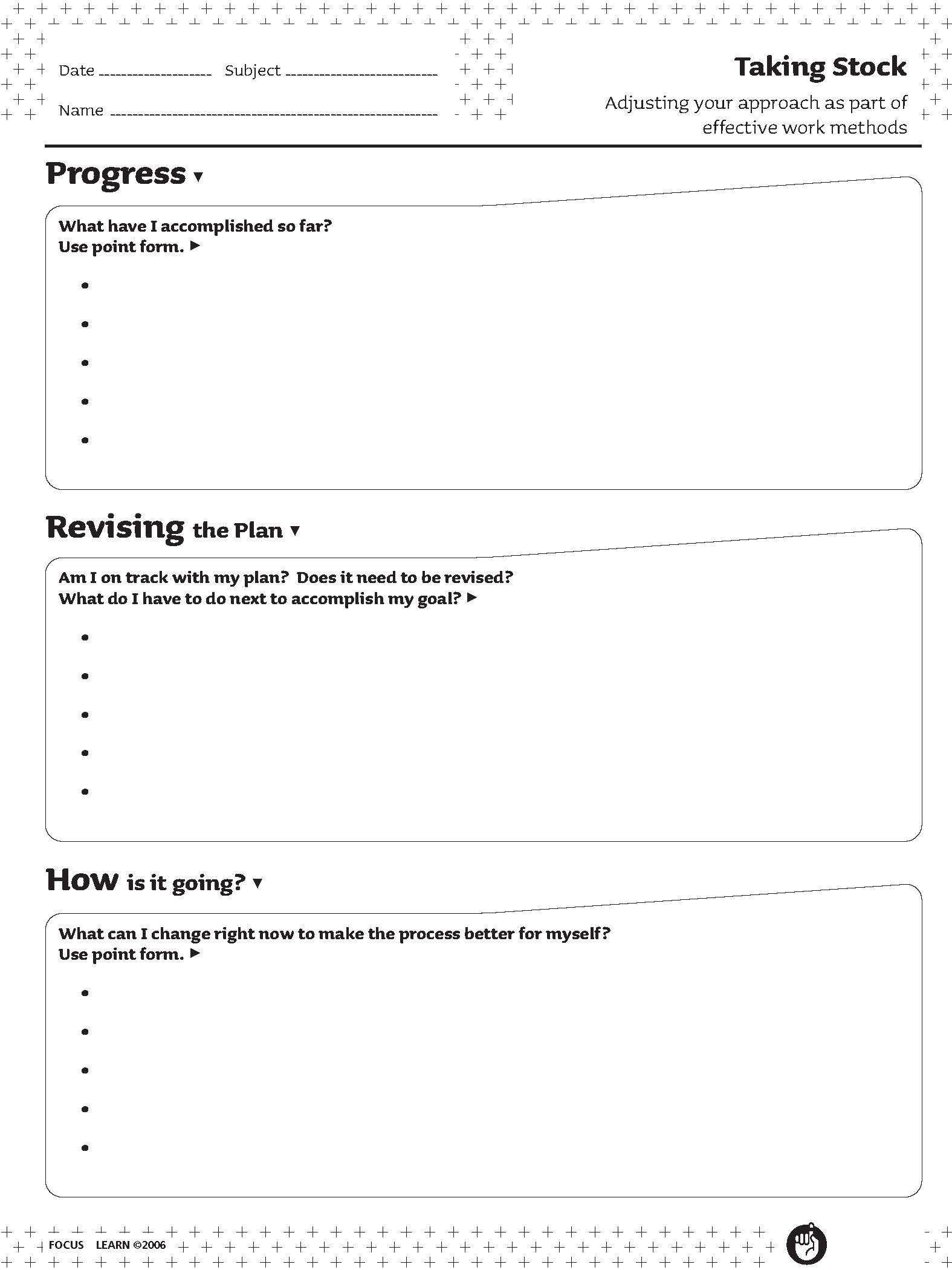
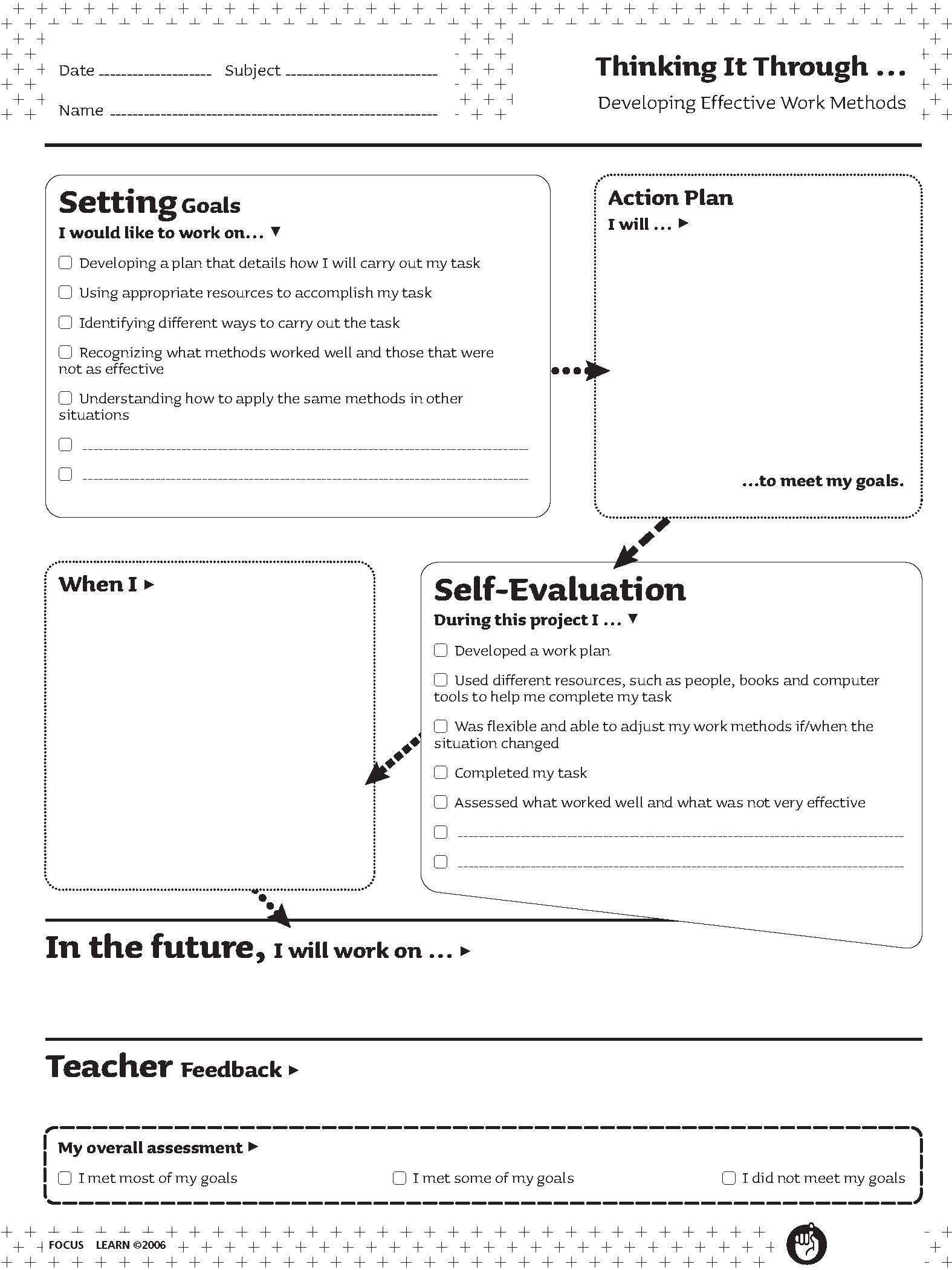
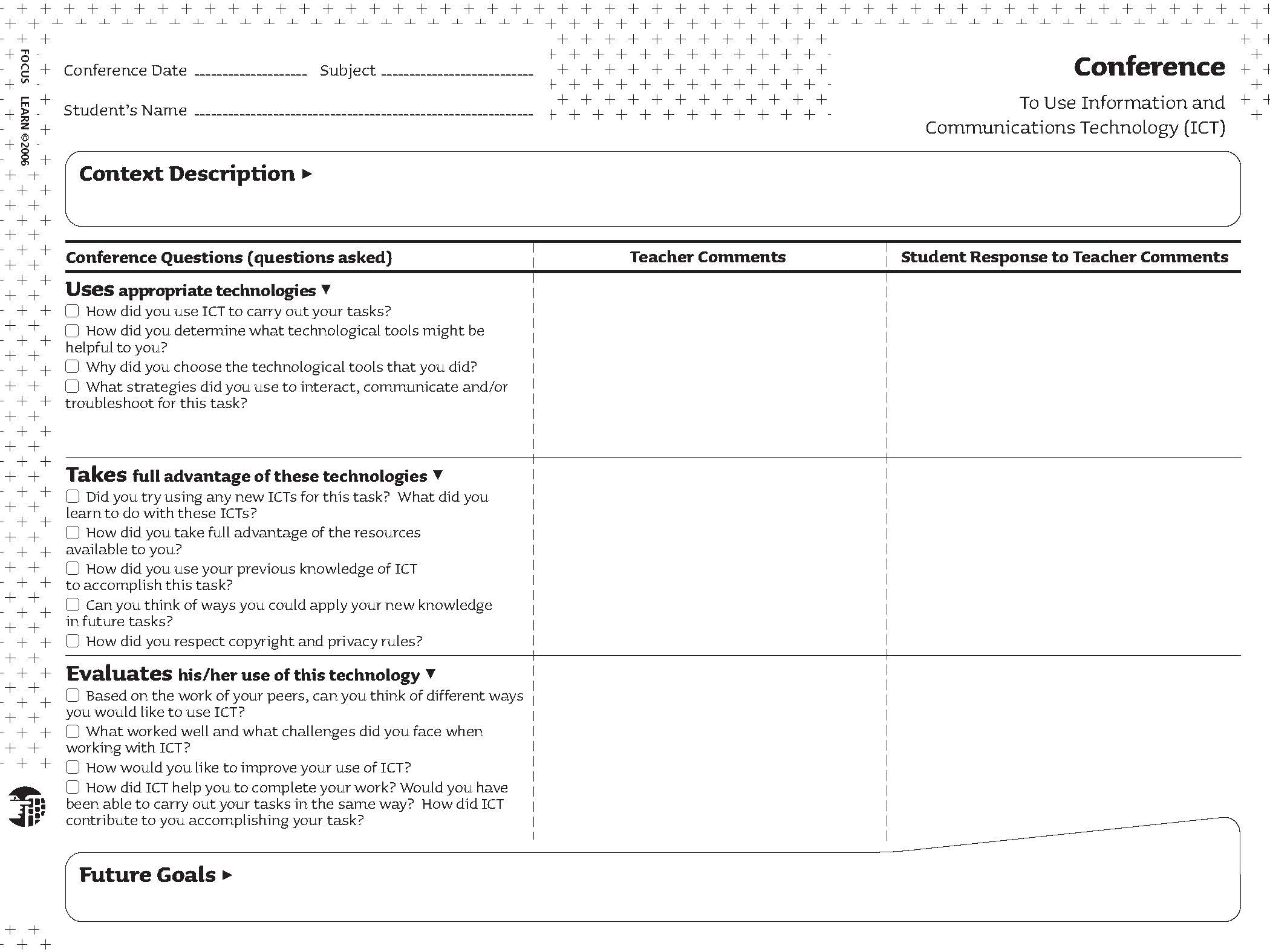
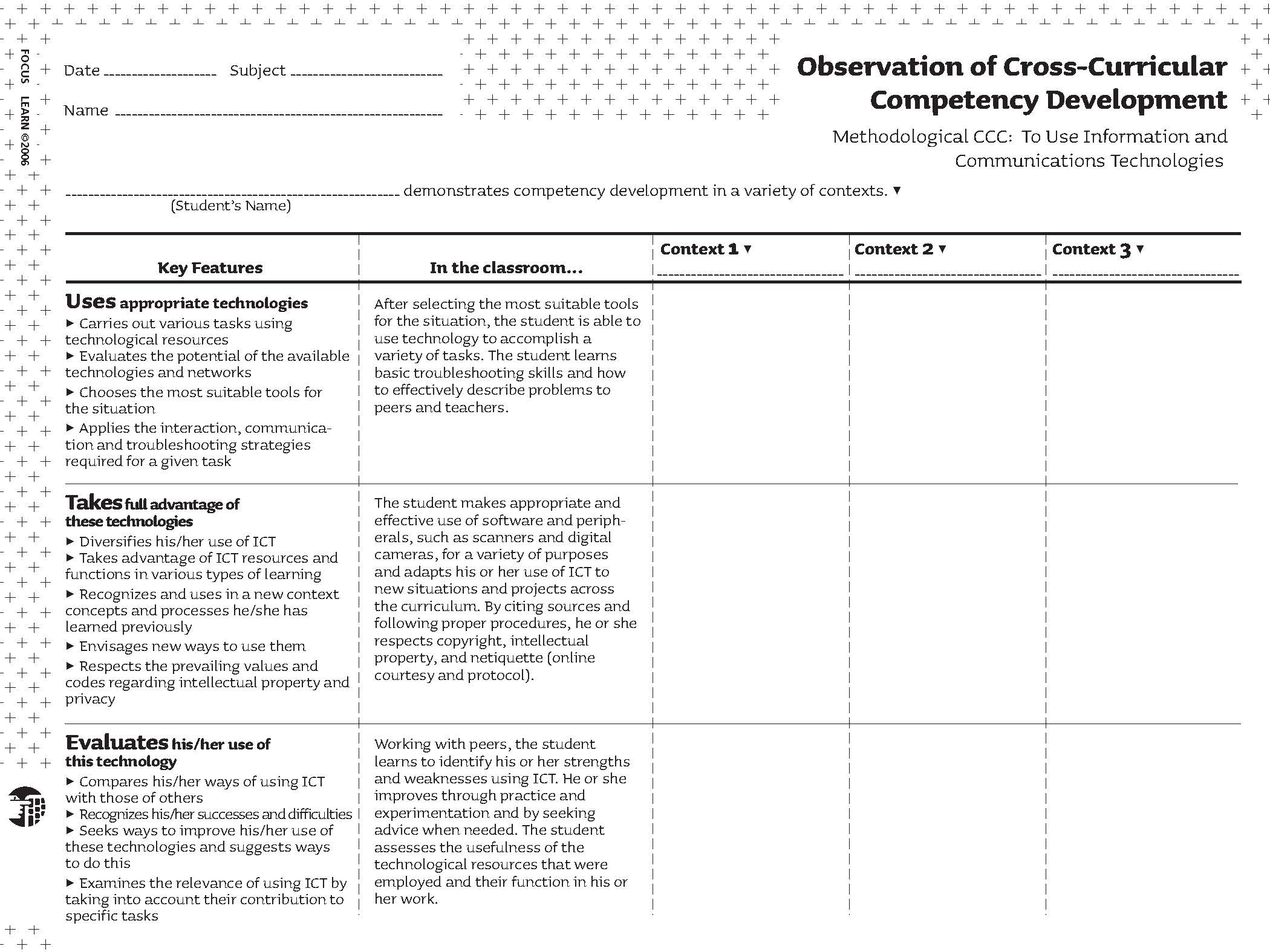
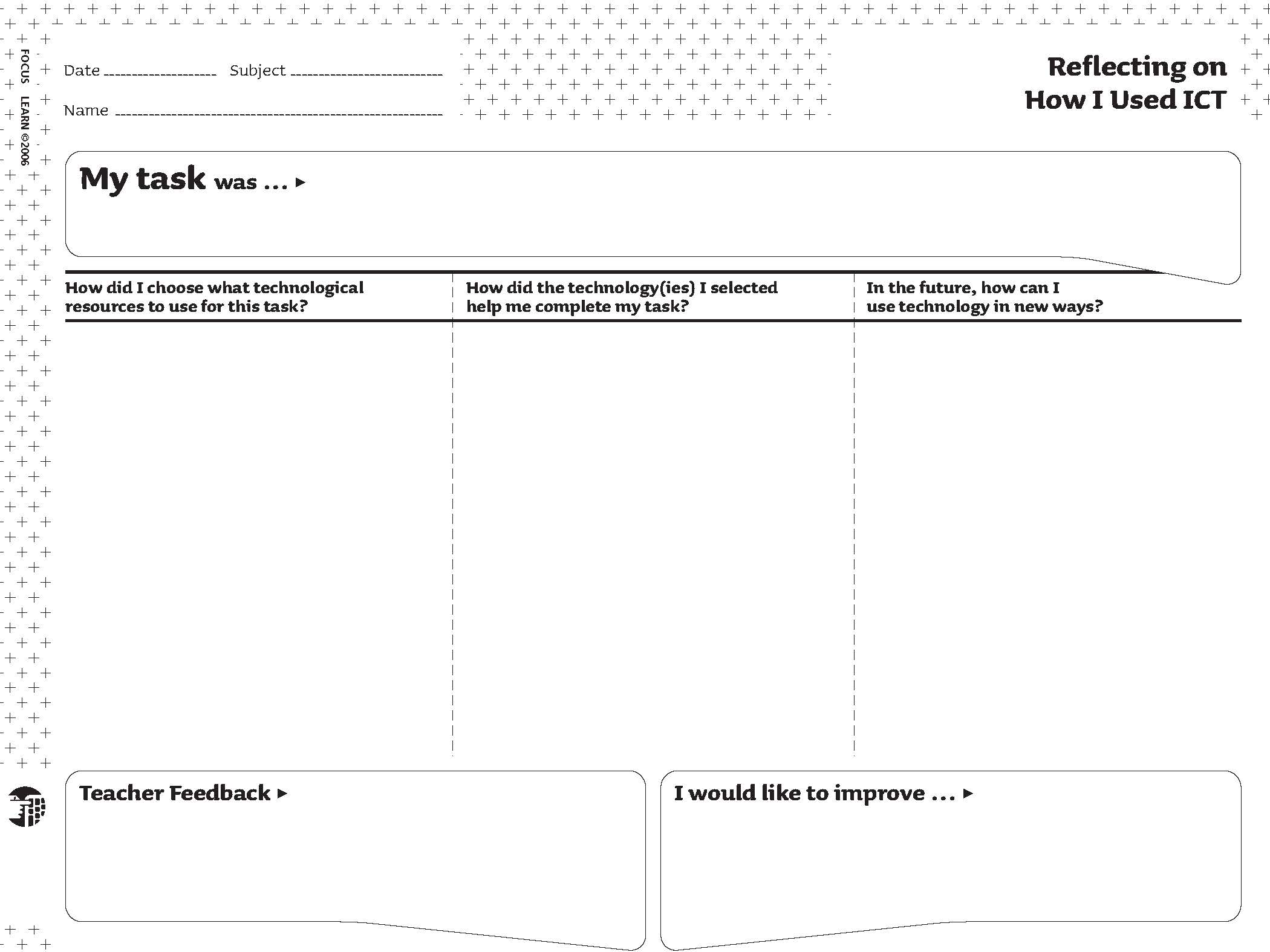
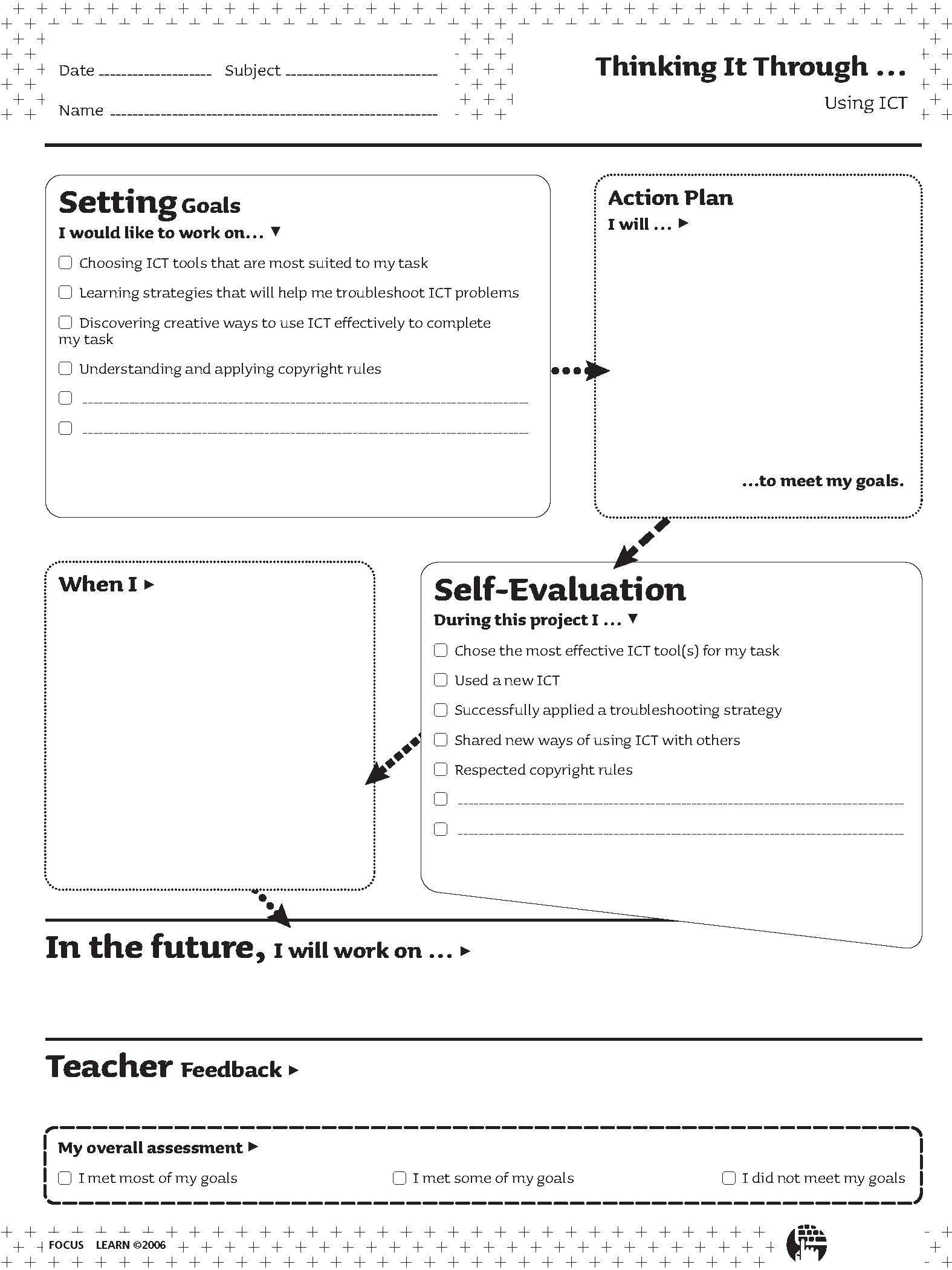
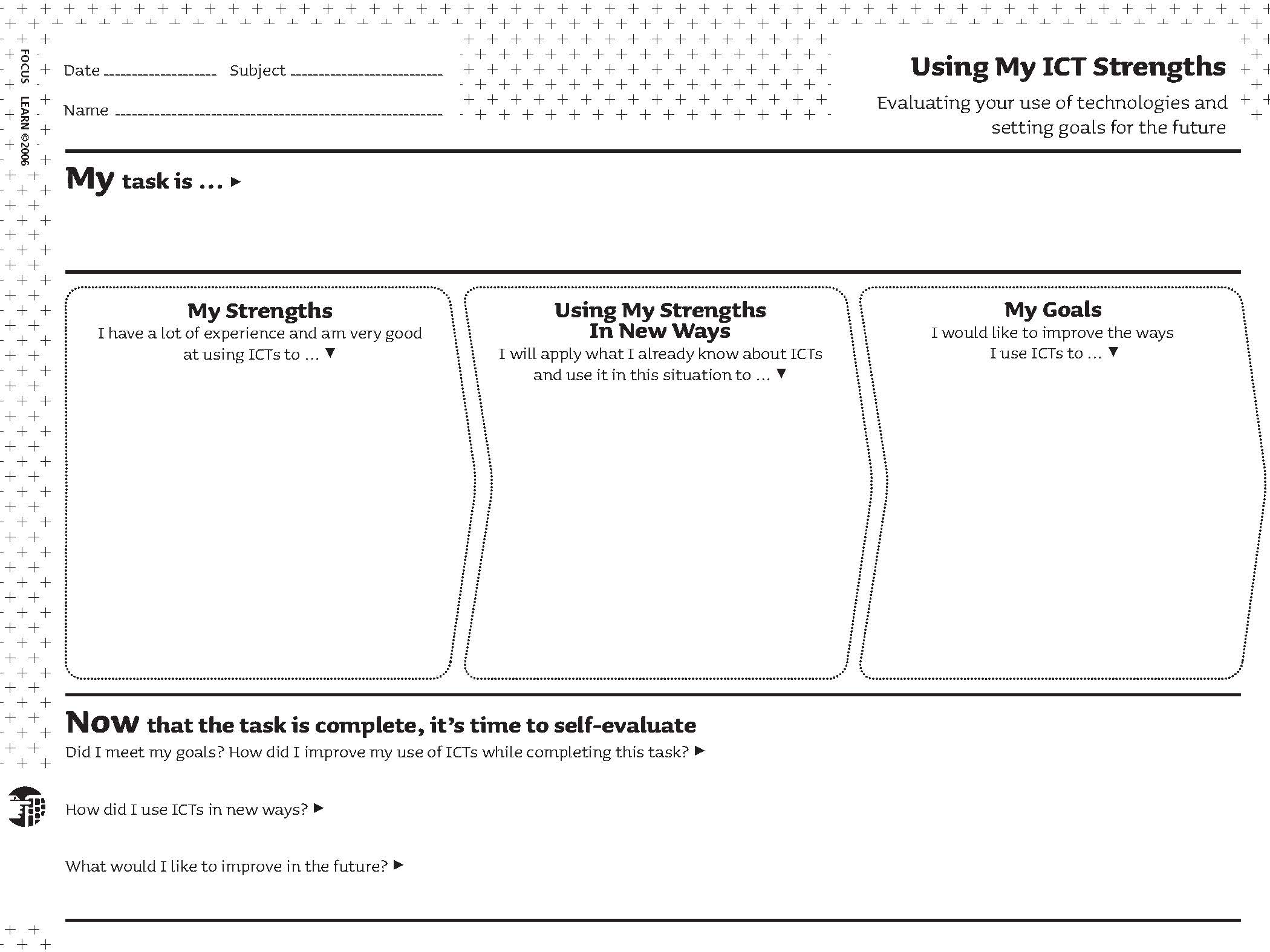
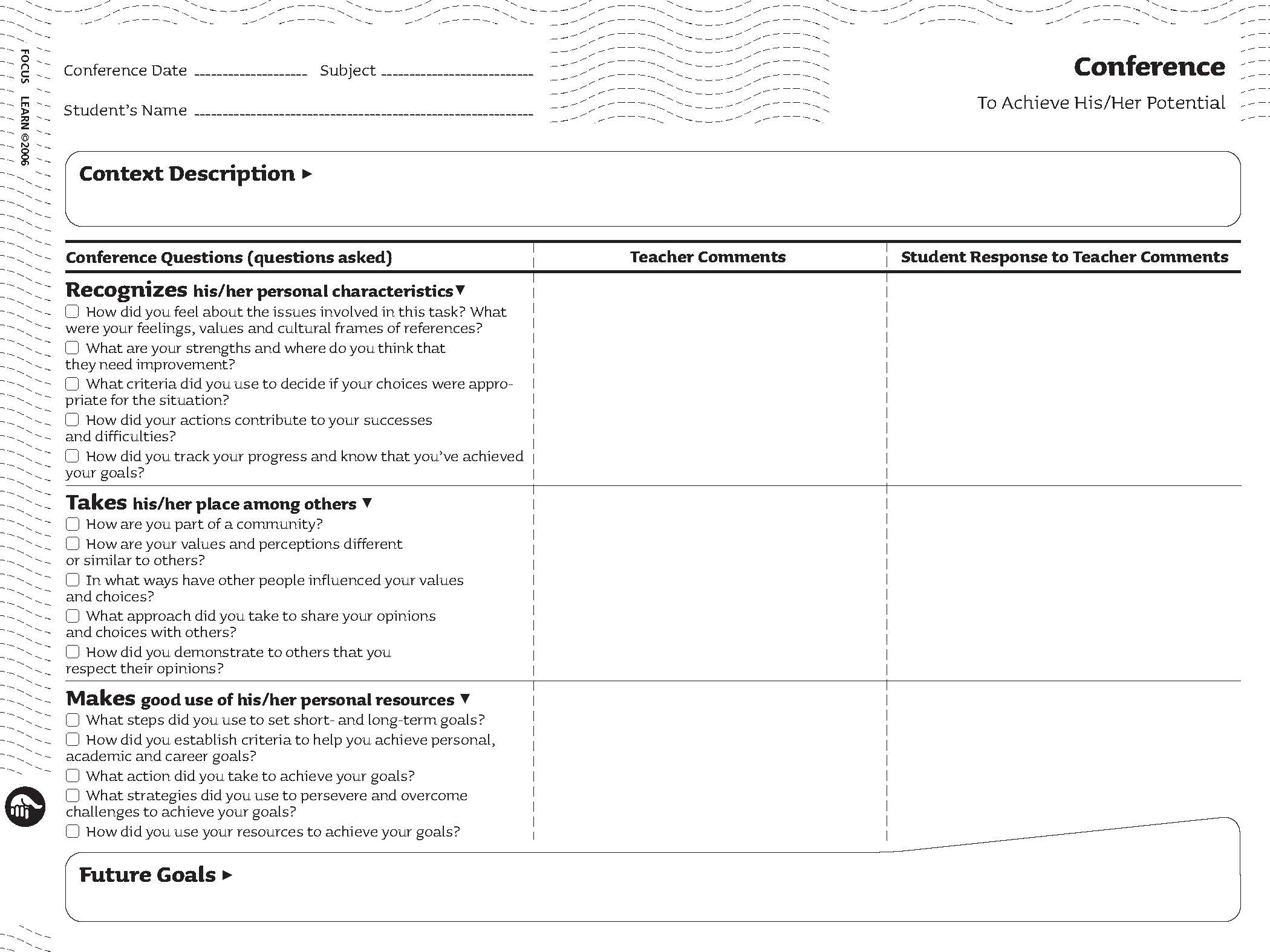
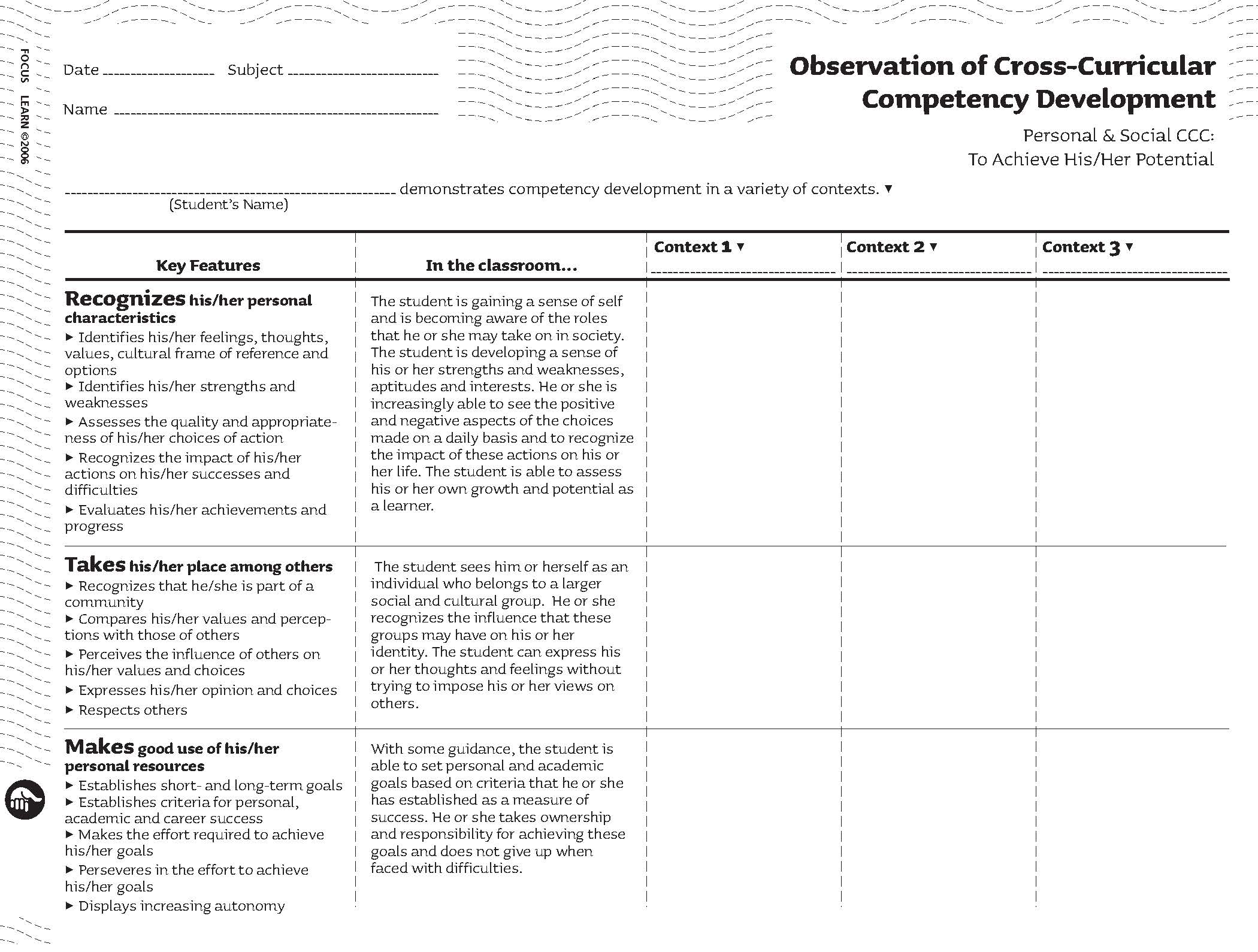
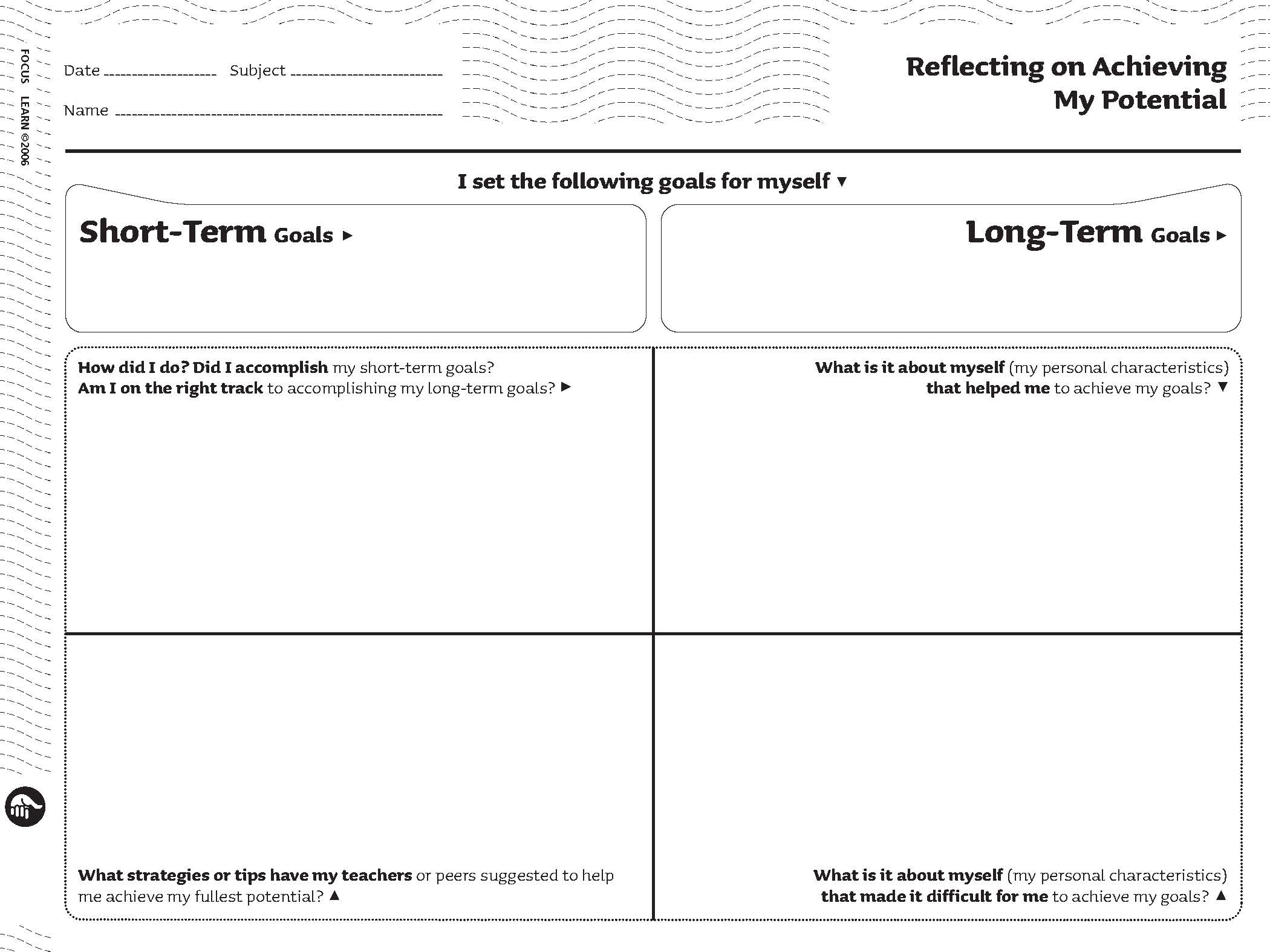
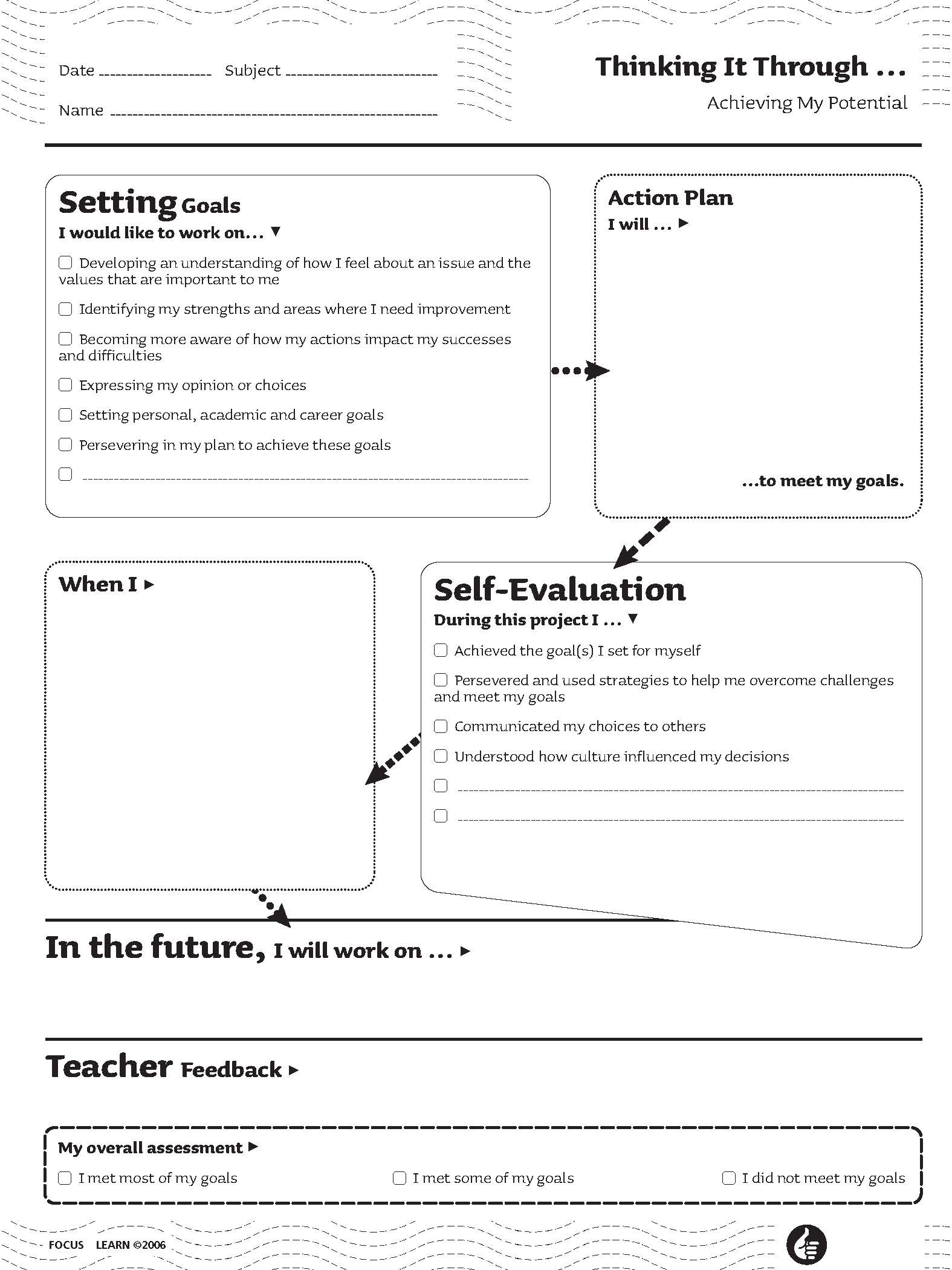
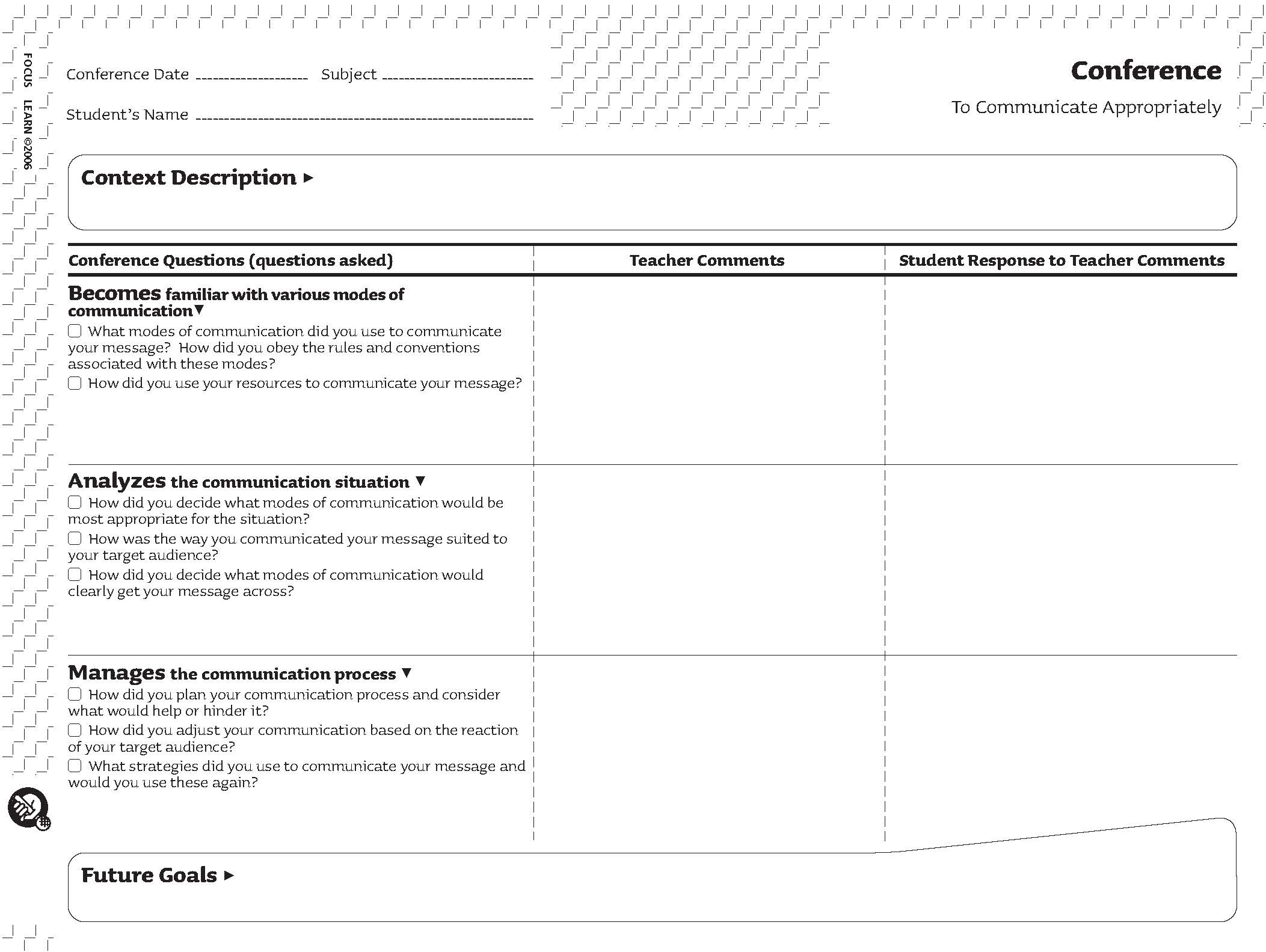
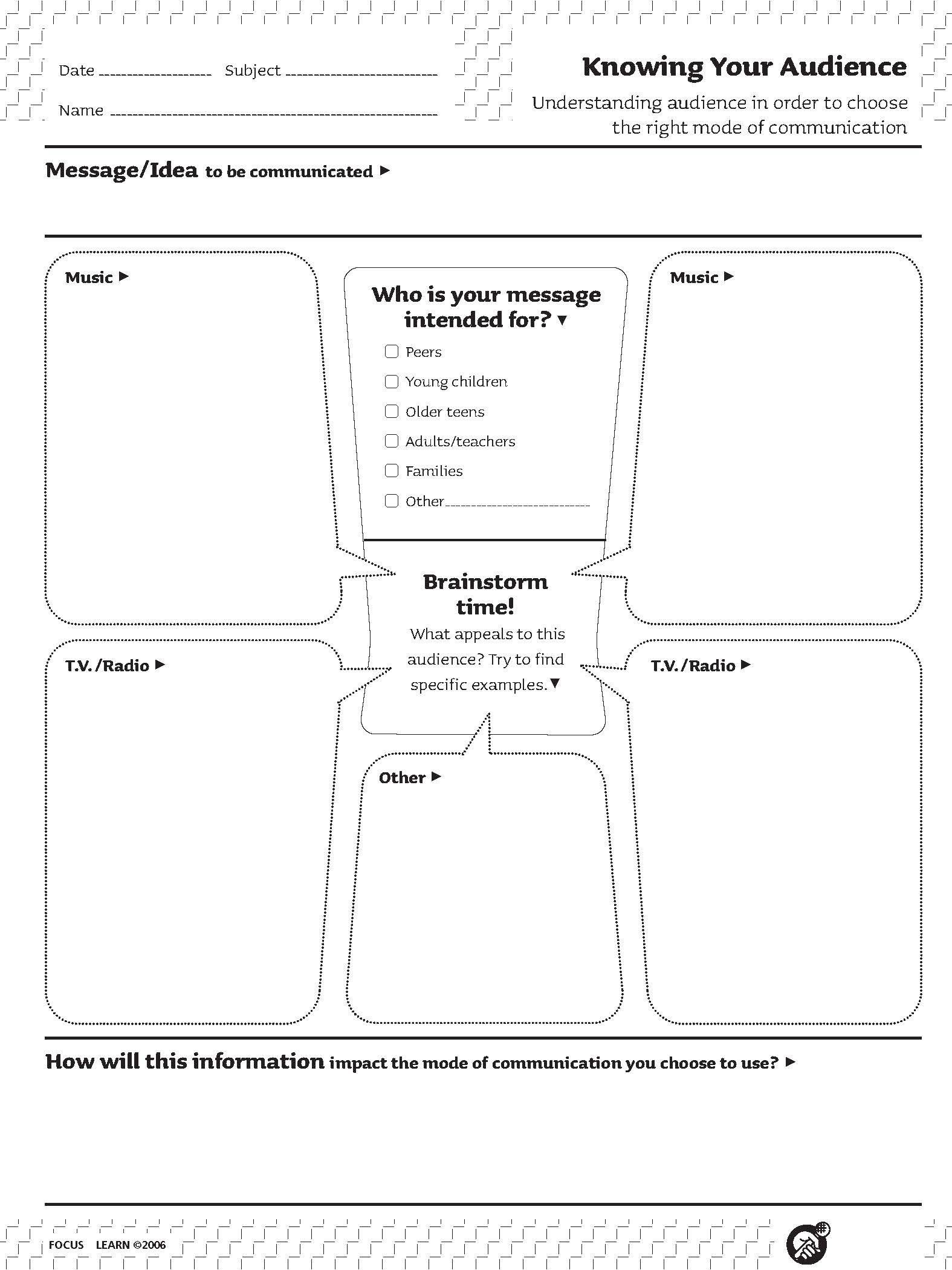
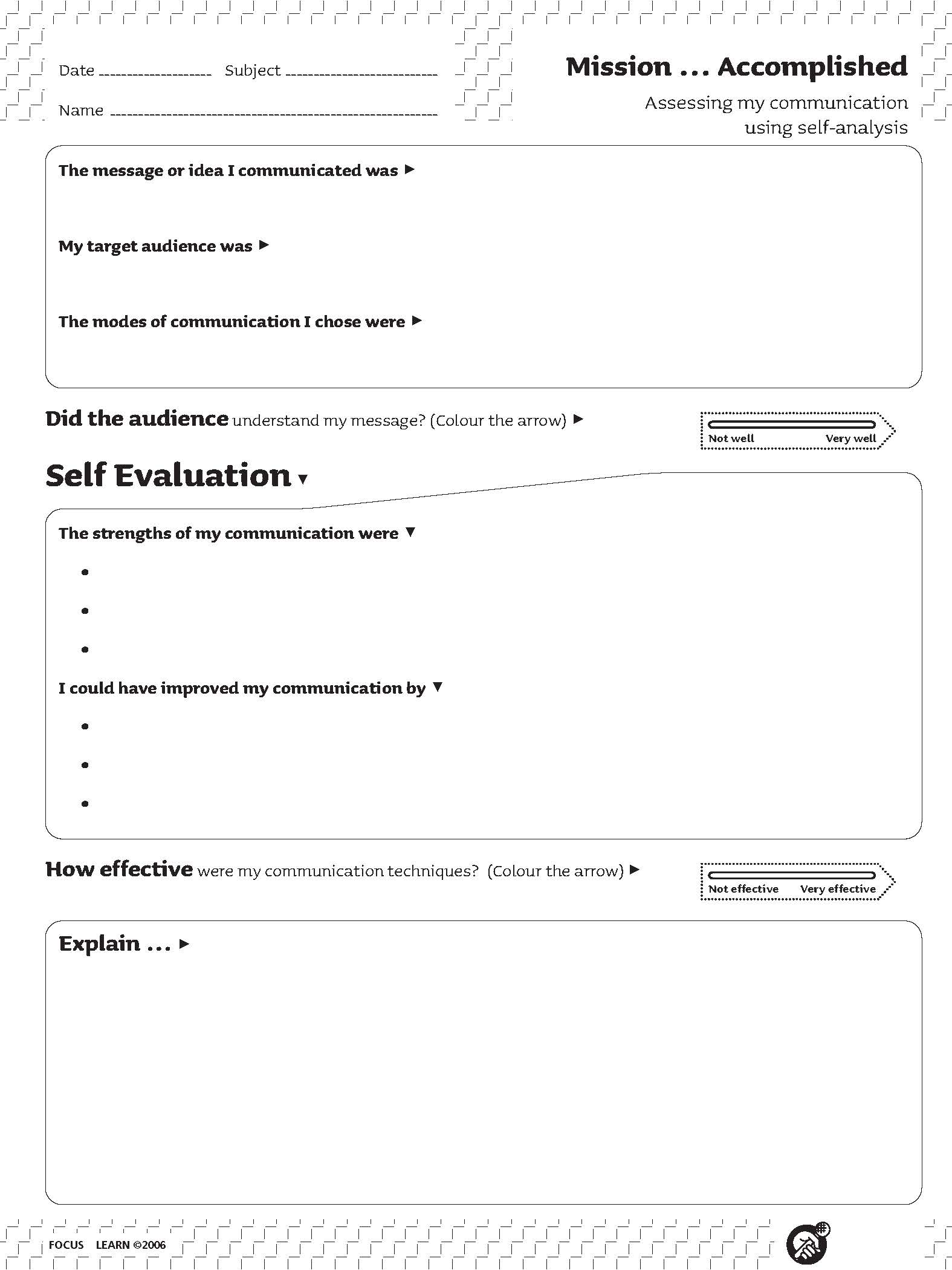
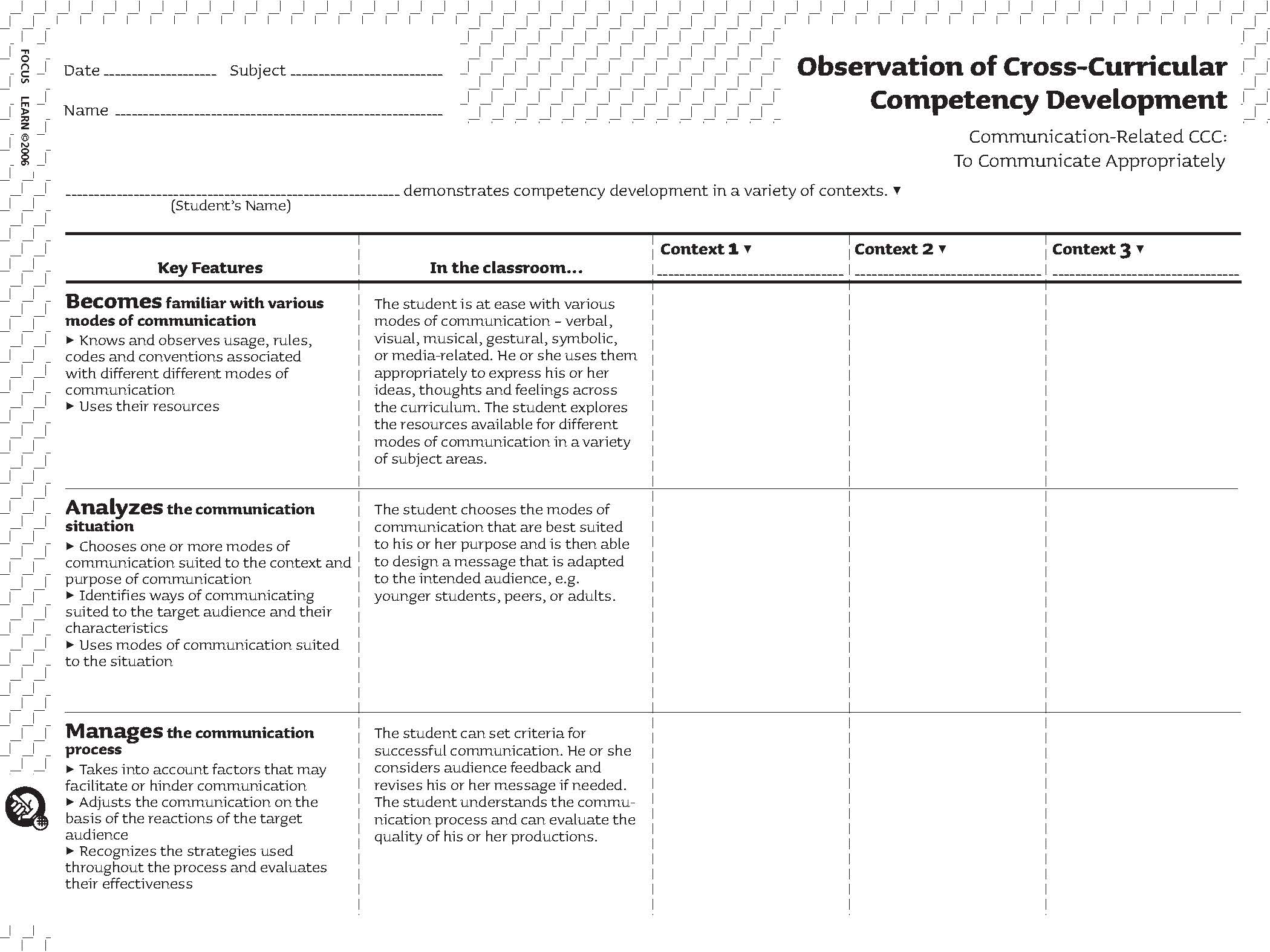
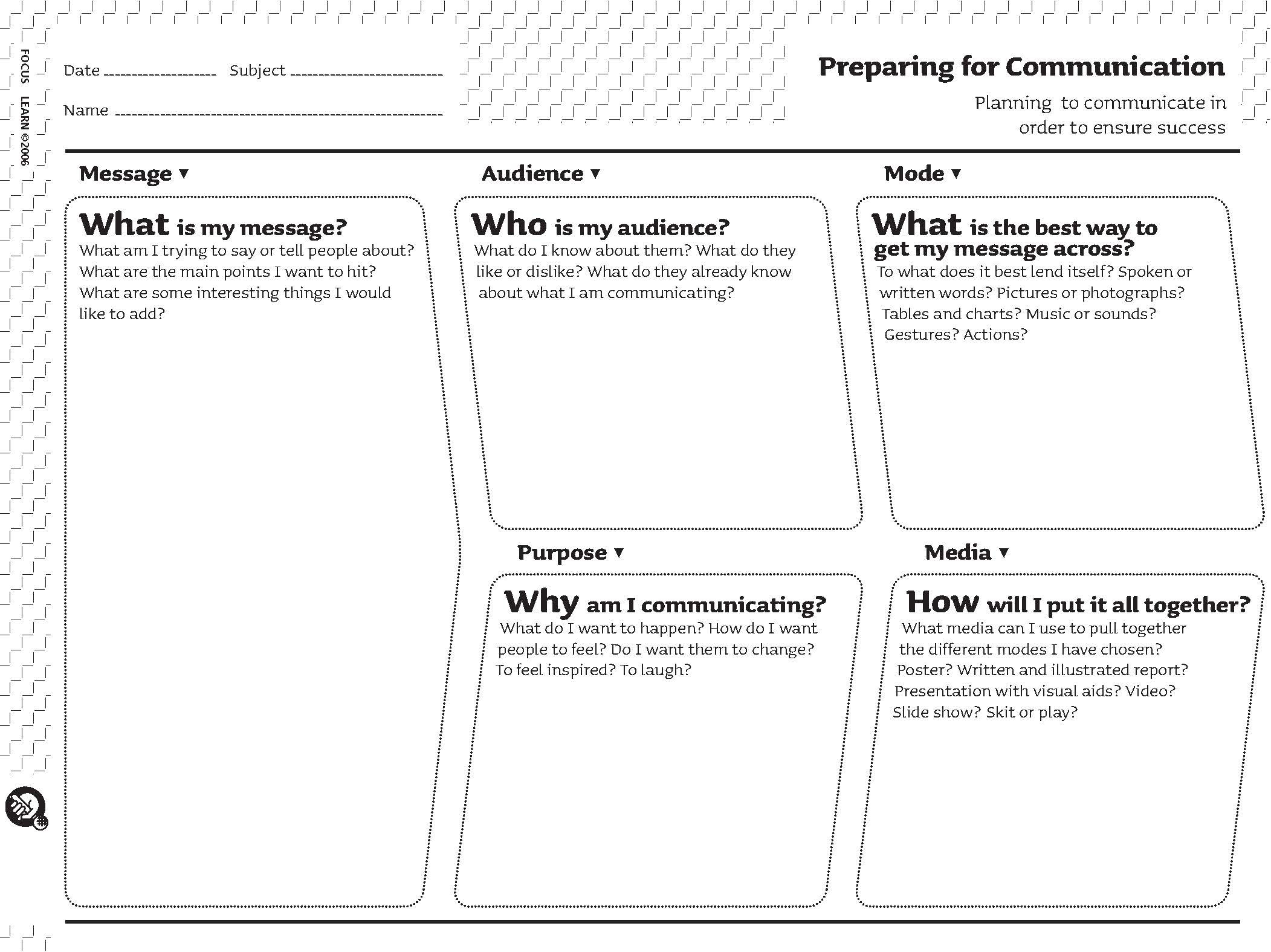
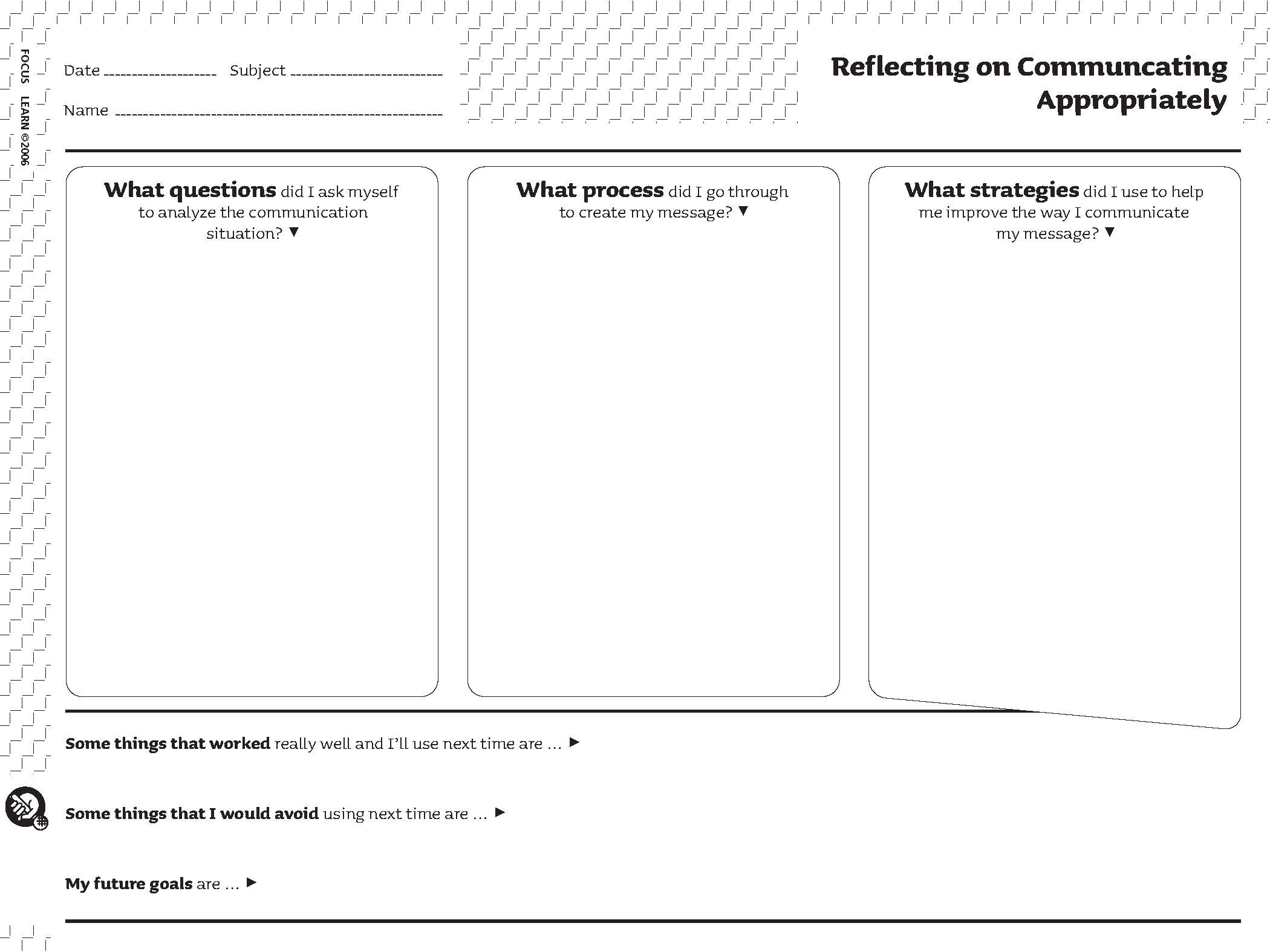
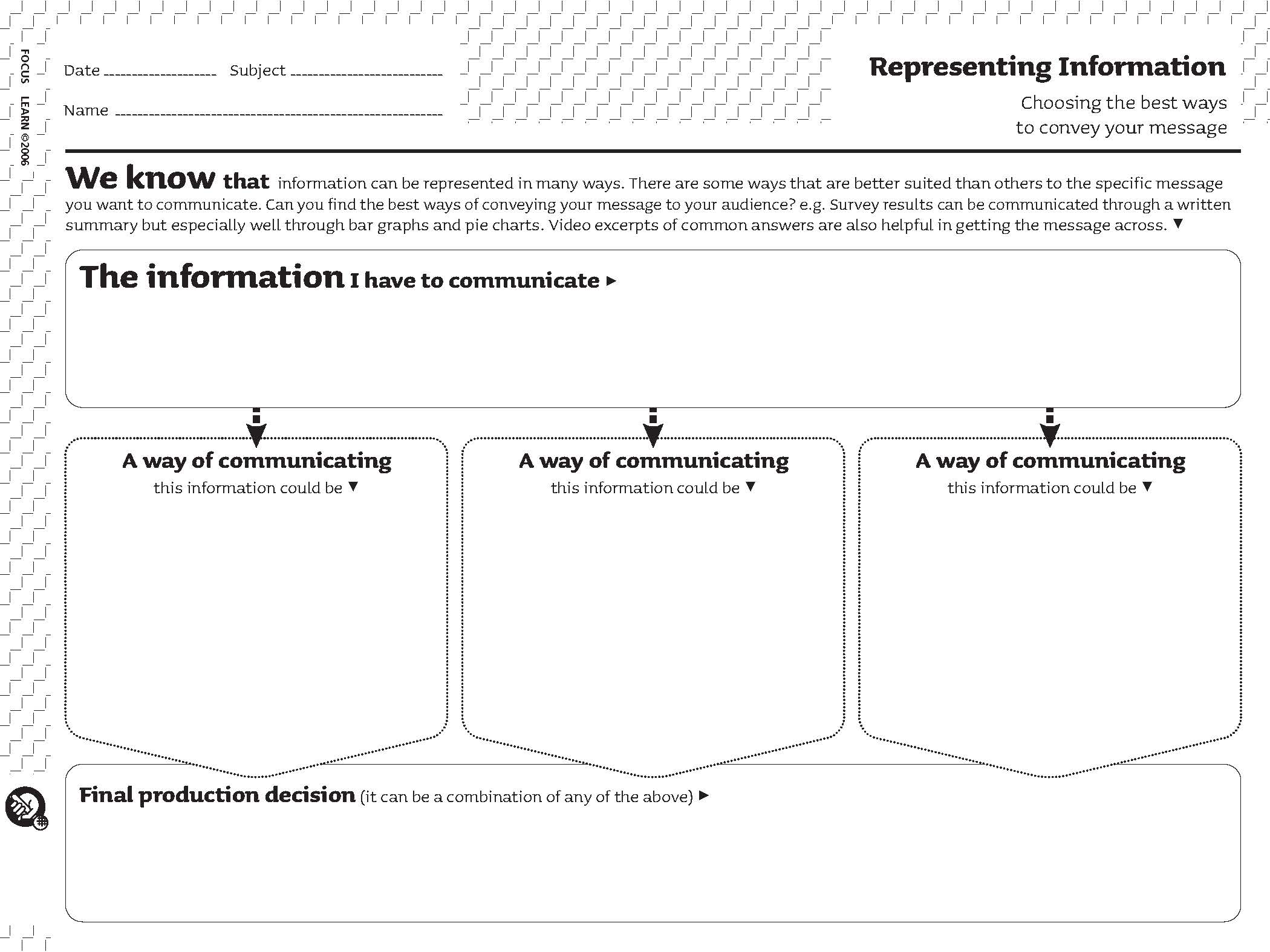
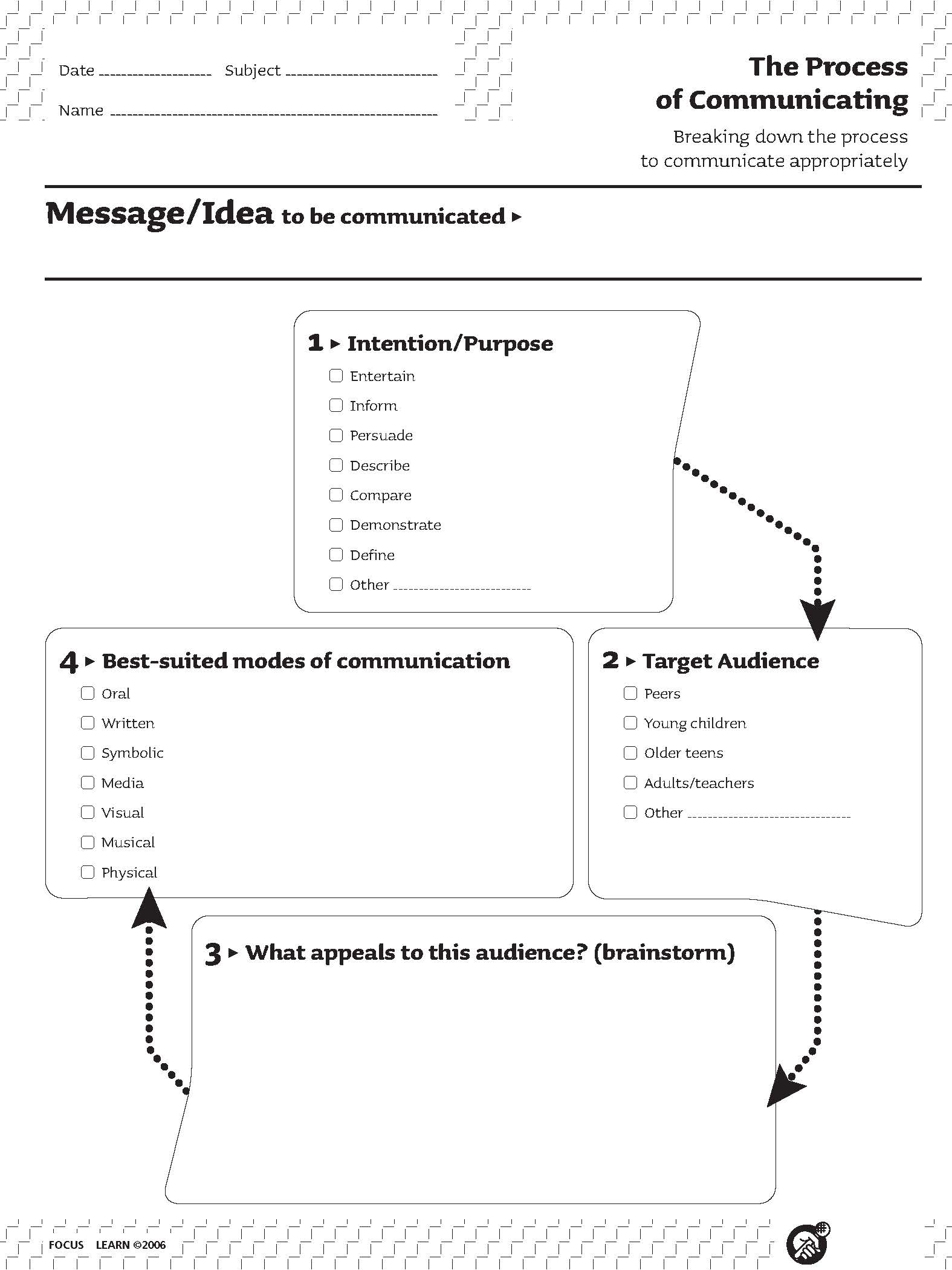
 FACEBOOK
FACEBOOK TWITTER
TWITTER
 INSTAGRAM
INSTAGRAM LINKEDIN
LINKEDIN